
- Modern Indian History Tutorial
- Modern Indian History - Home
- Decline of Mughal Empire
- Bahadur Shah I
- Jahandar Shah
- Farrukh Siyar
- Muhammad Shah
- Nadir Shah’s Outbreak
- Ahmed Shah Abdali
- Causes of Decline of Mughal Empire
- South Indian States in 18th Century
- North Indian States in 18th Century
- Maratha Power
- Economic Conditions in 18th Century
- Social Conditions in 18th Century
- Status of Women
- Arts and Paintings
- Social Life
- The Beginnings of European Trade
- The Portuguese
- The Dutch
- The English
- East India Company (1600-1744)
- Internal Organization of Company
- Anglo-French Struggle in South India
- The British Conquest of India
- Mysore Conquest
- Lord Wellesley (1798-1805)
- Lord Hastings
- Consolidation of British Power
- Lord Dalhousie (1848-1856)
- British Administrative Policy
- British Economic Policies
- Transport and Communication
- Land Revenue Policy
- Administrative Structure
- Judicial Organization
- Social and cultural Policy
- Social and Cultural Awakening
- The Revolt of 1857
- Major Causes of 1857 Revolt
- Diffusion of 1857 Revolt
- Centers of 1857 Revolt
- Outcome of 1857 Revolt
- Criticism of 1857 Revolt
- Administrative Changes After 1858
- Provincial Administration
- Local Bodies
- Change in Army
- Public Service
- Relations with Princely States
- Administrative Policies
- Extreme Backward Social Services
- India & Her Neighbors
- Relation with Nepal
- Relation with Burma
- Relation with Afghanistan
- Relation with Tibet
- Relation with Sikkim
- Relation with Bhutan
- Economic Impact of British Rule
- Nationalist Movement (1858-1905)
- Predecessors of INC
- Indian National Congress
- INC & Reforms
- Religious & Social Reforms
- Religious Reformers
- Women’s Emancipation
- Struggle Against Caste
- Nationalist Movement (1905-1918)
- Partition of Bengal
- Indian National Congress (1905-1914)
- Muslim & Growth Communalism
- Home Rule Leagues
- Struggle for Swaraj
- Gandhi Assumes Leadership
- Jallianwalla Bagh Massacre
- Khilafat & Non-Cooperation
- Second Non-Cooperation Movement
- Civil Disobedience Movement II
- Government of India Act (1935)
- Growth of Socialist Ideas
- National Movement World War II
- Post-War Struggle
- Clement Attlee’s Declaration
- Reference & Disclaimer
Modern Indian History - Quick Guide
Decline of Mughal Empire
The Great Mughal Empire declined and disintegrated during the first half of the 18th century.
The Mughal Emperors lost their power and glory and their empire shrank to a few square miles around Delhi.
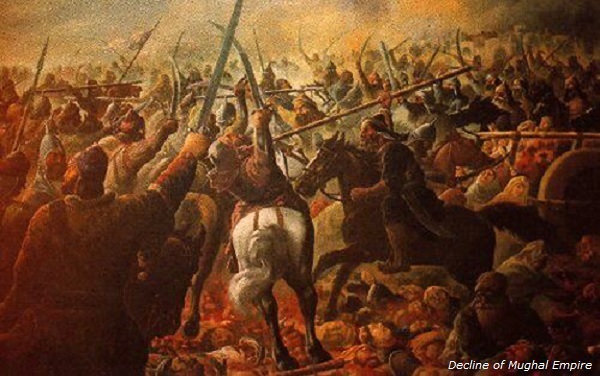
In the end, in 1803, Delhi itself was occupied by the British army and the proud of Mughal Emperor was reduced to the status of a mere pensioner of a foreign power.
The decline of Mughal Empire reveals some of the defects and weaknesses of India's medieval social, economic, and political structure which were responsible for the eventual subjugation of the country by the English East India Company.
The unity and stability of the Empire had been shaken up during the long and strong reign of Aurangzeb; yet in spite of his many harmful policies, the Mughal administration was still quite efficient and the Mughal army quite strong at the time of his death in 1707.
For better understanding (of the decline of Mughal Empire), the subsequent chapters (kept under the following headings) describe feeble Mughal Emperors, their weaknesses, and faulty activities −
- Bahadur Shah I
- Jahandar Shah
- Farrukh Siyar
- Muhammad Shah
- Nadir Shah’s Outbreak
- Ahmad Shah Abdali
Modern Indian History - Bahadur Shah I
On Aurangzeb's death, his three sons fought among themselves for the throne. The 65-year old Bahadur Shah emerged victorious. He was learned, dignified, and deserving.
Bahadur Shah followed a policy of compromise and conciliation, and there was evidence of the reversal of some of the narrow-minded policies and measures adopted by Aurangzeb. He adopted a more tolerant attitude towards the Hindu chiefs and rajas.
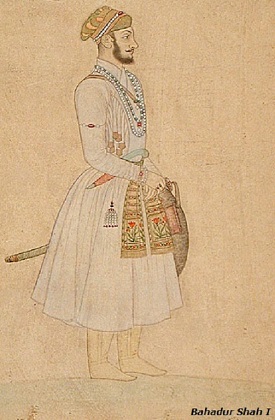
There was no destruction of temples in Bahadur Shah’s reign. In the beginning, he made an attempt to gain greater control over the regional states through the conciliation; however, dissensions developed among the regional kingdoms (including Rajput, Marathas, etc.); resultantly, they fought among themselves as well as against Mughal Emperor.
Bahadur Shah had tried to conciliate the rebellious Sikhs by making peace with Guru Gobind Singh and giving him a high mansab (rank). But after the death of the Guru, the Sikhs once again raised the banner of revolt in Punjab under the leadership of Banda Bahadur. The Emperor decided to take strong measures and himself led a campaign against the rebels, soon controlled practically the entire territory between the Sutlej and the Yamuna, and reached the close neighborhood of Delhi.
Bahadur Shah conciliated Chatarsal (the Bundela chief, who remained a loyal feudatory) and the Jat chief Churaman, who joined him in the campaign against Banda Bahadur.
In spite of hard efforts of Bahadur Shah, there was further deterioration in the field of administration in Bahadur Shah's reign. The position of state finances worsened as a result of his reckless grants and promotions.
During Bahadur Shah's reign, the remnants of the Royal treasure, amounting to some total 13 crores of rupees in 1707, were exhausted.
Bahadur Shah was examining towards a solution of the problems besetting the Empire. He might have revived the Imperial fortunes, but unfortunately, his death in 1712 plunged the Empire once again into civil war.
Modern Indian History - Jahandar Shah
After Bahadur Shah’s death, a new element entered Mughal politics i.e. the succeeding wars of succession. While previously the contest for the power had been between royal princes only, and the nobles had hardly any interference to the throne; now ambitious nobles became direct contenders for the power and used princes as mere pawns to capture the seats of authority.
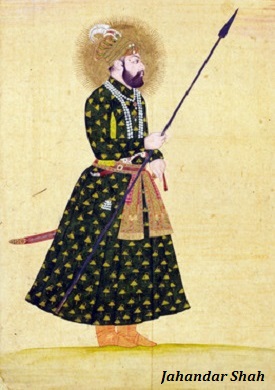
In the civil war, one of Bahadur Shah's weak sons, Jahandar Shah, won because he was supported by Zulfiqar Khan, the most powerful noble of the time.
Jahandar Shah was a weak and degenerate prince who was wholly devoted to pleasure. He lacked good manners, dignity, and decency.
During Jahandar Shah's reign, the administration was virtually in the hands of the extremely capable and energetic Zulfiqar Khan, who was his wazir.
Zulfiqar Khan believed that it was necessary to establish friendly relations with the Rajput rajas and the Maratha Sardars and to conciliate the Hindu chieftains necessary to strengthen his own position at the Court and to save the Empire. Therefore, he swiftly reversed the policies of Aurangzeb and abolished the hated jzyah (tax).
Jai Singh of Amber was given the title of Mira Raja Saint and appointed Governor of Malwa; Ajit Singh of Marwar was awarded the tide of Maharaja and appointed Governor of Gujarat.
Zulfiqar Khan made an attempt to secure the finances of the Empire by checking the reckless growth of jagirs and offices. He also tried to compel the (nobles) to maintain their official quota of troops.
An evil tendency encouraged by him was that of ‘ijara’ or revenue-farming. Instead of collecting land revenue at a fixed rate as under Todar Mal’s land revenue settlement, the Government began to contract with revenue farmers and middlemen to pay the Government a fixed amount of money while they were left free to collect whatever they could from the peasant. This encouraged the oppression of the peasant.
Many jealous nobles secretly worked against Zulfiqar Khan. Worse still, the Emperor did not give him his trust and cooperation in full measure. The Emperor's ears were poisoned against Zulfiqar Khan by unscrupulous favorites. He was told that his wazir was becoming too powerful and ambitious and might even overthrow the Emperor himself.
The cowardly Emperor could not dismiss the powerful wajir (Zulfiqar Khan), but he began to intrigue against him secretly.
Modern Indian History - Farrukh Siyar
Jahandar Shah's inglorious reign came to an early end in January 1713 when he was defeated at Agra by his nephew Farrukh Siyar.
Farrukh Siyar owed his victory to the Sayyid brothers, Abdullah Khan and Husain Ali Khan Baraha, who were therefore given the offices of wazir and nur bakshi respectively
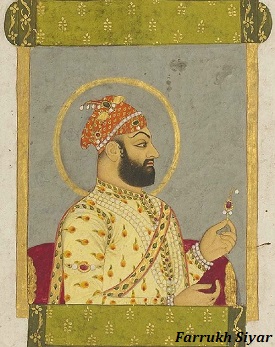
The Sayyid brothers soon acquired dominant control over the affairs of the state and Farrukh Siyar lacked the capacity to rule. He was coward, cruel, undependable, and faithless. Moreover, he allowed himself to be influenced by worthless favorites and flatterers.
In spite of his weaknesses, Farrukh Siyar was not willing to give the Sayyid brothers a free hand but wanted to exercise personal authority.
The Sayyid brothers were convinced that administration could be carried on properly, the decay of the Empire checked, and their own position safeguarded only if they wielded real authority and the Emperor merely reigned without ruling.
There was a prolonged struggle for power between the Emperor Farrukh Siyar and his wazir and mir bakshi.
Year after year the ungrateful Emperor intrigued to overthrow the two brothers, but he failed repeatedly. In the end of 1719, the Sayyid brothers deposed Farrukh Siyar and killed him.
In Farrukh Siyar place, they raised to the throne in quick succession two young princes' namely Rafi-ul Darjat and Rafi ud-Daulah (cousins of Farrukh Siyar), but they died soon. The Sayyid brothers now made Muhammad Shah the Emperor of India.
The three successors of Farrukh Siyar were mere puppets in the hands of the Saiyids Even their personal liberty to meet people and to move around was restricted. Thus, from 1713 until 1720, when they were overthrown, the Sayyid brothers wielded the administrative power of the state.
The Sayyid brothers made a rigorous effort to control rebellions and to save the Empire from administrative disintegration. They failed in these tasks mainly because they were faced with constant political rivalry, quarrels, and conspiracies at the court.
The everlasting friction in the ruling circles disorganized and even paralyzed administration at all levels and spread lawlessness and disorder everywhere.
The financial position of the state deteriorated rapidly as zamindars and rebellious elements refused to pay land revenue, officials misappropriated state revenues, and central income declined because of the spread of revenue farming.
The salaries of officials and soldiers could not be paid regularly and soldiers became undisciplined and even mutinous.
Many nobles were jealous of the 'growing power’ of the Sayyid brothers. The deposition and murder of Farrukh Siyar frightened many of them: if the Emperor could be killed, what safety was there for mere nobles?
Moreover, the murder of the Emperor created a wave of public revulsion against the two brothers. They were looked down upon as traitors.
Many of the nobles of Aurangzeb's reign also disliked the Sayyid alliance with the Rajput and the Maratha chiefs and their liberal policy towards the Hindus.
Many nobles declared that the Sayyids were following anti-Mughal and antiIslamic policies. They thus tried to arouse the fanatical sections of the Muslim nobility against the Sayyid brothers.
The anti- Sayyid nobles were supported by Emperor Muhammad Shah who wanted to free himself from the control of the two brothers.
In 1720, Haidar Khan killed Hussain Ali khan on 9 October 1720, the younger of the two brothers. Abdullah Khan tried to fight, back but was defeated near Agra. Thus ended the domination of the Mughal Empire by the Sayyid brothers (they were known in Indian history as 'king makers').
Modern Indian History - Muhammad Shah
Muhammad Shah's long reign of nearly 30 years (1719-1748) was the last chance of saving the Empire. But Muhammad Shah was not the man of the moment. He was weak-minded and frivolous and over-fond of a life of ease and luxury.
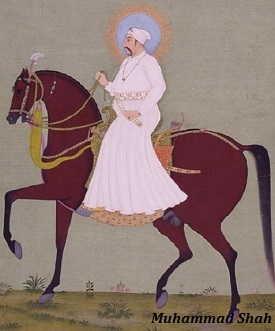
Muhammad Shah neglected the affairs of state. Instead of giving full support to knowledgeable wazirs such as Nizam-ul-Mulk, he fell under the evil influence of corrupt and worthless flatterers and intrigued against his own ministers. He even shared in the bribes taken by his favorite courtiers.
Disgusted with the fickle-mindedness and suspicious nature of the Emperor and the constant quarrels at the court, Nizum-ul-Mulk, the most powerful noble of the time, decided to follow his own ambition. He had become the wazir in 1722 and had made a vigorous attempt to reform the administration.
Nizum-ul-Mulk decided to leave the Emperor and his Empire to their fate and to strike out on his own. He relinquished his office in October 1724 and marched south to find the state of Hyderabad in the Deccan. "His departure was symbolic of the flight of loyalty and virtue from the Empire.”
After the withdrawal of Nizum-ul-Mulk, many other zamindars, rajas, and nawabs of many states raised the banner of rebellion and independence. For example Bengal, Hyderabad, Avadh, Punjab, and Maratha.
Nadir Shah’s Outbreak
In 1738-39, Nadir Shah descended upon the plains of northern India.
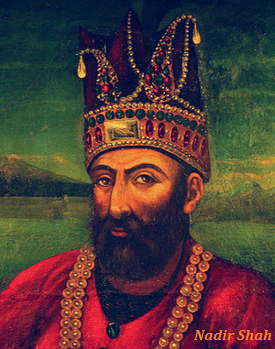
Nadir Shah was attracted to India by the fabulous wealth for which it was always famous. The visible weakness of the Mughal Empire made such spoliation possible.
Nadir Shah marched on to Delhi and the Emperor Muhammad Shah was taken as prisoner.
A terrible massacre of the citizens of the imperial capital was ordered by Nadir Shah as a reprisal against the killing of some of his soldiers.
The greedy invader Nadir Shah took possession of the royal treasury and other royal property, levied tribute on the leading nobles, and plundered Delhi.
Nadir Shah’s total plunder has been estimated about 70 crores of rupees. This enabled him to exempt taxation of his own Kingdom for three years.
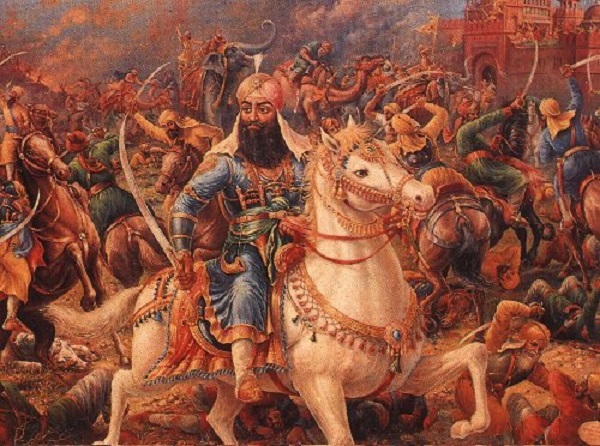
Nadir Shah also carried away the famous Koh-i-nur diamond and the Jewelstudded Peacock Throne of Shahjahan.
Nadir Shah compelled Muhammad Shah to cede to him all the provinces of the Empire falling west of the river Indus.
Nadir Shah's Invasion inflicted immense damage on the Mughal Empire. It caused an irreparable loss of prestige and exposed the hidden weaknesses of the Empire to the Maratha Sardars and the foreign trading companies.
The invasion ruined imperial finances and adversely affected the economic life of the country. The impoverished nobles began to rack-rent and oppress the peasantry even more in an effort to recover their lost fortunes
The loss of Kabul and the areas to the west of the Indus once again opened the Empire to the threat of invasions from the North-West. A vital line of defense had disappeared.
Modern Indian History - Ahmed Shah Abdali
After Muhammad Shah's death in 1748, bitter struggles, and even civil war broke out among unscrupulous and power hungry nobles. Furthermore, as a result of the weakening of the north-western defenses, the Empire was devastated by the repeated invasions of Ahmed Shah Abdali, one of Nadir Shah's ablest generals, who had succeeded in establishing his authority over Afghanistan after his master's death.
Abdali repeatedly invaded and plundered northern India right down to Delhi and Mathura between 1748 and 1767.
In 1761, Abdali defeated the Maratha in the Third Battle of Panipat and thus gave a big blow to their ambition of controlling the Mughal Emperor and thereby dominating the country.
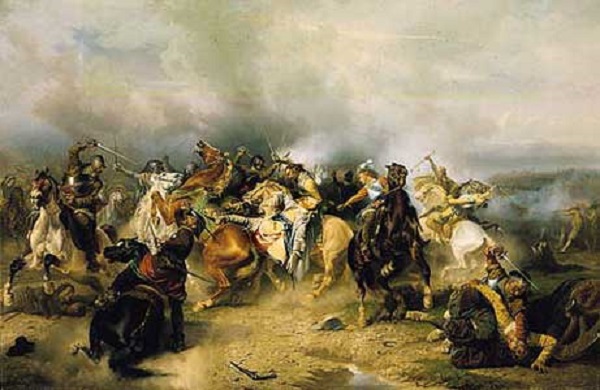
After defeating Mughal and Maratha, Abdali did not, however, found a new Afghan kingdom in India. He and his successors could not even retain the Punjab which they soon lost to the Sikh chiefs.
As a result of the invasions of Nadir Shah Abdali and the suicidal internal feuds of the Mughal nobility, the Mughal Empire had (by 1761) ceased to exist in practice as an all-India Empire.
Mughal Empire narrowed merely as the Kingdom of Delhi. Delhi itself was a scene of 'daily riot and tumult'.
Shah Alam II, who ascended the throne in 1759, spent the initial years as an Emperor wandering from place to place far away from his capital, for he lived in mortal fear of his own war.
Shah Alam II was a man of some ability and ample courage. But the Empire was by now beyond redemption.
In 1764, Shah Alam II joined Mir Qasim of Bengal and Shuja-ud-Daula of Avadh in declaring war upon the English East India Company.
Defeated by the British at the Battle of Buxar (October 1764), Shah Alam II lived for several years at Allahabad as a pensioner of the East India Company.
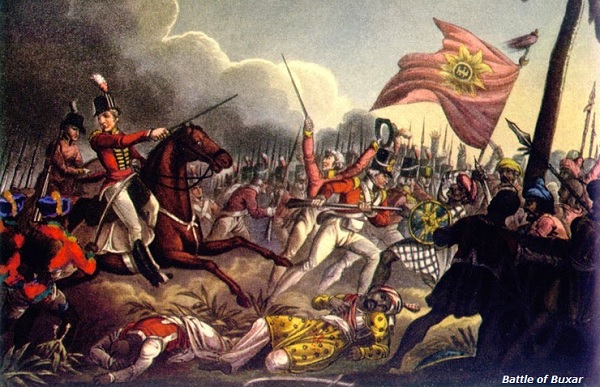
Shah Alam II left the British shelter in 1772 and returned to Delhi under the protective arm of the Marathas.
The British occupied Delhi in 1803 and since that time to till 1857, when the Mughal dynasty was finally extinguished, the Mughal Emperors merely served as a political front for the English.
Causes of Decline of Mughal Empire
Beginning of the decline of the Mughal Empire can be traced to the strong rule of Aurangzeb.
Aurangzeb inherited a large empire, yet he adopted a policy of extending it further to the farthest geographical limits in the south at the great expense of men and materials.
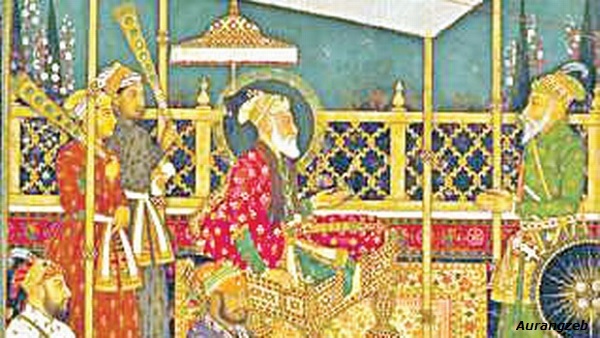
Political Cause
In reality, the existing means of communication and the economic and political structure of the country made it difficult to establish a stable centralized administration over all parts of the country.
Aurangzeb’s objective of unifying the entire country under one central political authority was, though justifiable in theory, not easy in practice.
Aurangzeb’s futile but arduous campaign against the Marathas extended over many years; it drained the resources of his Empire and ruined the trade and industry of the Deccan.
Aurangzeb’s absence from the north for over 25 years and his failure to subdue the Marathas led to deterioration in administration; this undermined the prestige of the Empire and its army.
In the 18th century, Maratha’s expansion in the north weakened central authority still further.
Alliance with the Rajput rajas with the consequent military support was one of the main pillars of Mughal strength in the past, but Aurangzeb's conflict with some of the Rajput states also had serious consequences.
Aurangzeb himself had in the beginning adhered to the Rajput alliance by raising Jaswant Singh of Kamer and Jai Singh of Amber to the highest of ranks. But his short-sighted attempt later to reduce the strength of the Rajput rajas and extend the imperial sway over their lands led to the withdrawal of their loyalty from the Mughal throne.
The strength of Aurangzeb’s administration was challenged at its very nerve center around Delhi by Satnam, the Jat, and the Sikh uprisings. All of them were to a considerable extent the result of the oppression of the Mughal revenue officials over the peasantry.
They showed that the peasantry was deeply dissatisfied with feudal oppression by Zamindars, nobles, and the state.
Religious Cause
Aurangzeb's religious orthodoxy and his policy towards the Hindu rulers seriously damaged the stability of the Mughal Empire.
The Mughal state in the days of Akbar, Jahangir, and Shahjahan was basically a secular state. Its stability was essentially founded on the policy of noninterference with the religious beliefs and customs of the people, fostering of friendly relations between Hindus and Muslims.
Aurangzeb made an attempt to reverse the secular policy by imposing the jizyah (tax imposed on non-Muslim people), destroying many of the Hindu temples in the north, and putting certain restrictions on the Hindus.
The jizyah was abolished within a few years of Aurangzeb’s death. Amicable relations with the Rajput and other Hindu nobles and chiefs were soon restored.
Both the Hindu and the Muslim nobles, zamindars, and chiefs ruthlessly oppressed and exploited the common people irrespective of their religion.
Wars of Succession and Civil Wars
Aurangzeb left the Empire with many problems unsolved, the situation was further worsened by the ruinous wars of succession, which followed his death.
In the absence of any fixed rule of succession, the Mughal dynasty was always plagued after the death of a king by a civil war between the princes.
The wars of succession became extremely fierce and destructive during the 18th century and resulted in great loss of life and property. Thousands of trained soldiers and hundreds of capable military commanders and efficient and tried officials were killed. Moreover, these civil wars loosened the administrative fabric of the Empire.
Aurangzeb was neither weak nor degenerate. He possessed great ability and capacity for work. He was free of vices common among kings and lived a simple and austere life.
Aurangzeb undermined the great empire of his forefathers not because he lacked character or ability but because he lacked political, social, and economic insight. It was not his personality, but his policies that were out of joint.
The weakness of the king could have been successfully overcome and covered up by an alert, efficient, and loyal nobility. But the character of the nobility had also deteriorated. Many nobles lived extravagantly and beyond their means. Many of them became ease-loving and fond of excessive luxury.
Many of the emperors neglected even the art of fighting.
Earlier, many able persons from the lower classes had been able to rise to the ranks of nobility, thus infusing fresh blood into it. Later, the existing families of nobles began to monopolies all offices, barring the way to fresh comers.
Not all the nobles, however, bad become weak and inefficient. A large number of energetic and able officials and brave and brilliant military commanders came into prominence during the 18th century, but most of them did not benefit the Empire because they used their talents to promote their own interests and to fight each other rather than to serve the state and society.
The major weakness of the Mughal nobility during the 18th century lay, not in the decline in the average ability of the nobles or their moral decay, but in their selfishness and lack of devotion to the state and this, in turn, gave birth to corruption in administration and mutual bickering.
In order to increase emperors’ power, prestige, and income, the nobles formed groups and factions against each other and even against the king. In their struggle for power, they took recourse to force, fraud, and treachery.
The mutual quarrels exhausted the Empire, affected its cohesion, led to its dismemberment, and, in the end, made it an easy prey to foreign conquerors.
A basic cause of the downfall of the Mughal Empire was that it could no longer satisfy the minimum needs of its population.
The condition of the Indian peasant gradually worsened during the 17th and 18th centuries. Nobles made heavy demands on the peasants and cruelly oppressed them, often in violation of official regulations.
Many ruined peasants formed roving bands of robbers and adventurers, often under the leadership of the zamindars, and thus undermined law and order and the efficiency of the Mughal administration.
During the 18th century, the Mughal army lacked discipline and fighting morale. Lack of finance made it difficult to maintain a large number of army. Its soldiers and officers were not paid for many months, and, since they were mere mercenaries, they were constantly disaffected and often verged on a mutiny.
The civil wars resulted in the death of many brilliant commanders and brave and experienced solders. Thus, the army, the ultimate sanction of an empire, and the pride of the Great Mughals, was so weakened that it could no longer curb the ambitious chiefs and nobles or defend the Empire from foreign aggression.
Foreign Invasion
A series of foreign invasions affected Mughal Empire very badly. Attacks by Nadir Shah and Ahmad Shah Abdali, which were themselves the consequences of the weakness of the Empire, drained the Empire of its wealth, ruined its trade and industry in the North, and almost destroyed its military power.
The emergence of the British challenge took away the last hope of the revival of the crisis-ridden Empire.
South Indian States in 18th Century
The rulers of the South Indian states established law and order and viable economic and administrative states. They curbed with varying degrees of success.
The politics of South Indian states were invariably non-communal or secular. The motivations of their rulers were being similar in economic and political terms.
The rulers of South Indian states did not discriminate on religious grounds in public appointment; civil or military; nor did the rebels against their authority pay much attention to the religion of the rulers.
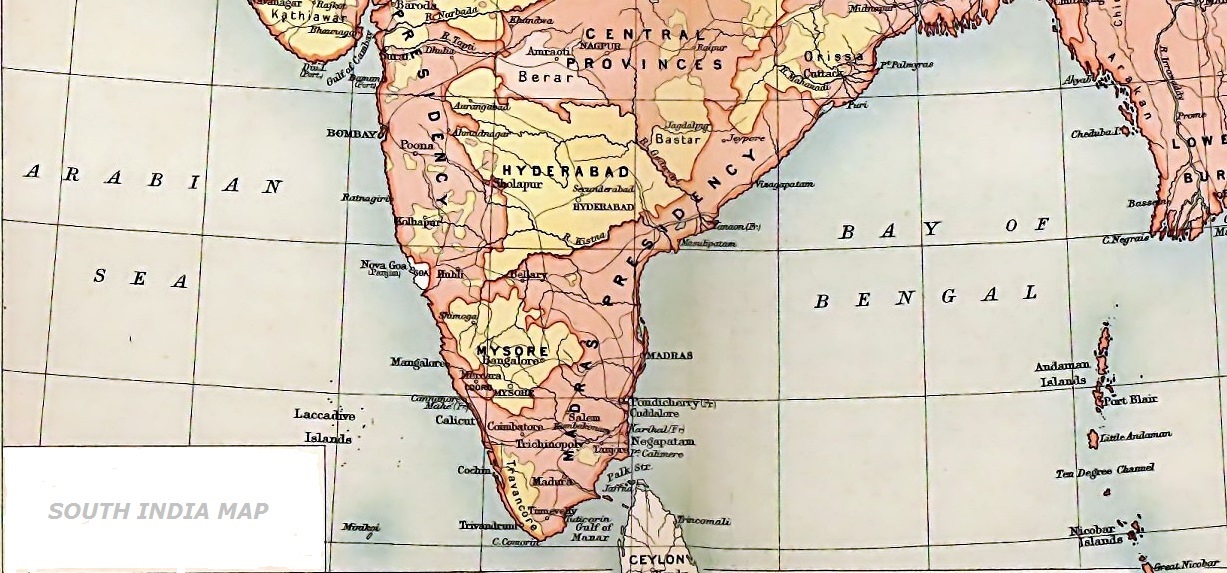
None of the South Indian states, however, succeeded in arresting the economic crisis. The zamindars and jagirdars, whose had number constantly increased, continued to fight over a declining income from agriculture, while the condition of the peasantry continued to deteriorate.
While the South Indian states prevented any breakdown of internal trade and even tried to promote foreign trade, they did nothing to modernize the basic industrial and commercial structure of their states.
Following were the important states of South India in 18th century −
Hyderabad and the Carnatic
The state of Hyderabad was founded by Nizam-ul-Mulk Asaf Jah in 1724. He was one of the leading nobles of the post-Aurangzeb era.
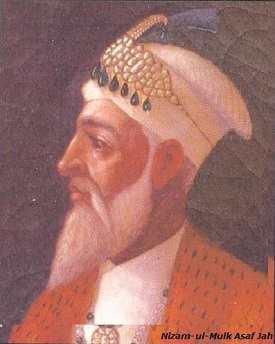
Asaf Jah never openly declared his independence in front of the Central Government, but in practice, he acted like an independent ruler. He waged wars, concluded peace, conferred titles, and gave jaws and offices without reference to Delhi.
Asaf Jah followed a tolerant policy towards the Hindus. For example, a Hindu, Purim Chand, was his Dewan. He consolidated his power by establishing an orderly administration in Deccan.
After the death of Asaf Jah (in 1748), Hyderabad fell prey to the same disruptive forces as were operating at Delhi.
The Carnatic was one of the subahs of the Mughal Deccan and as such came under the Nizam of Hyderabad's authority. But just as in practice the Nizam had become independent of Delhi, so also the Deputy Governor of the Carnatic, known as the Nawab of Carnatic, had freed himself from the control of the Viceroy of Deccan and made his office hereditary.
Mysore
Next to Hyderabad, the most important power that emerged in South India was Mysore under Haidar Ali. The kingdom of Mysore had prescribed its precarious independence ever since the end of the Vijayanagar Empire.
Haidar Ali born in 1721, in an obscure family, started his career as a petty officer in the Mysore army. Though uneducated, he possessed a keen intellect and was a man of great energy and daring and determination. He was also a brilliant commander and shrewd diplomat.
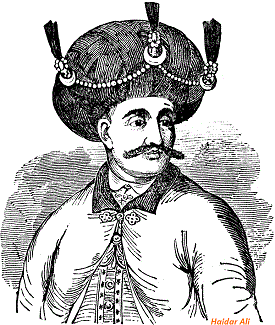
Cleverly using the opportunities that came his way, Haidar Ali gradually rose in the Mysore army. He soon recognized the advantages of western military training and applied it to the troops under his own command.
In 1761, Haidar Ali overthrew Nanjaraj and established his authority over the Mysore state. He took over Mysore when it was weak and divided state and soon made it one of the leading Indian powers
Haidar Ali extended full control over the rebellious poligars (zamindars) and conquered the territories of Bidnur, Sunda, Sera, Canara, and Malabar.
Haidar Ali practiced religious toleration and his first Dewan and many other officials were Hindus.
Almost from the beginning of the establishment of his power, Haidar Ali was engaged in wars with the Maratha Sardars, the Nizam, and the British forces.
In 1769, Haidar Ali repeatedly defeated the British forces and reached the walls of Madras. He died in 1782 in the course of the second Anglo-Mysore War and was succeeded by his son Tipu.
Sultan Tipu, who ruled Mysore untill his death at the hands of the British in 1799, was a man of complex character. He was, for one an innovator.
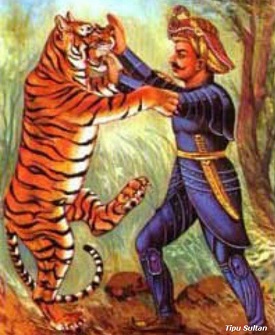
Tipu Sultan’s desire to change with the times was symbolized in the Introduction of a new calendar, a new system of coinage, and new scales of weights and measures.
Tipu Sultan’s personal library contained books on such diverse subjects as religion, history, military science, medicine, and mathematics. He showed a keen interest in the French Revolution.
Tipu Sultan planted a 'Tree of Liberty' at Sringapatam and he became a member of a Jacobin club.
Tipu Sultan tried to do away with the custom of giving jagirs, and thus increased the state income. He also made an attempt to reduce the hereditary possessions of the poligars.
Tipu Sultan’s land revenue was as high as that of other contemporary rulers— it ranged up to 1/3rd of the gross produce. But he checked the collection of illegal ceases, and he was liberal in granting remissions.
Tipu Sultan’s infantry was armed with muskets and bayonets in fashion, which were, however, manufactured in Mysore.
Tipu Sultan made an effort to build a modern navy after 1796. For this purpose, two dockyards, the models of the ships being supplied.
Tipu Sultan was recklessly brave and, as a commander was, however, hasty in action and unstable in nature.
Tipu Sultan stood forth as a foe for the rising English power. The English, in turn, too as his most dangerous enemy in India.
Tipu Sultan gave money for the construction of goddess Sarda in the Shringeri Temple in 1791. He regularly gave gifts to as well to several other temples.
In 1799, while fighting the Fourth Anglo-Mysore War, Tipu Sultan died.
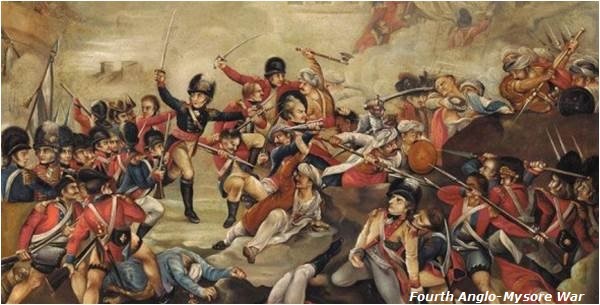
Kerala
At the beginning of the 18th century, Kerala was divided into a large number of feudal chiefs and rajas.
The kingdom of Travancore rose into prominence after 1729 under King Martanda Varma, one of the leading statesmen of the 18th century.
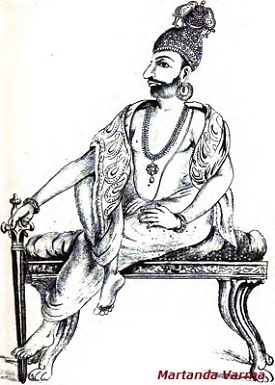
Martanda Varma organized a strong army on the western model with the help of European officers and armed it with modern weapons. He also constructed a modern arsenal.
Martanda Varma used his new army to expand northwards and the boundaries of Travancore soon extended from Kanyakumari to Cochin.
Martanda Varma undertook many irrigation works, built roads and canals for communication, and gave active encouragement to foreign trade.
By 1763, all the petty principalities of Kerala had been absorbed or subordinated by the three big states of Cochin, Travancore, and Calicut.
Haidar Ali began his invasion of Kerala in 1766 and in the end annexed northern Kerala up to Cochin, including the territories of the Zamorin of Calicut.
Trivandrum, the capital of Travancore, became a famous center of Sanskrit scholarship during the second half of the 18th century.
Rama Varma, the successor of Martanda Varma, was himself a poet, a scholar, a musician, a renowned actor, and a man of great culture. He conversed fluently in English, took a keen interest in European affairs. He regularly used to read newspapers and journals published in London, Calcutta, and Madras.
North Indian States in 18th Century
Following were the important North Indian States in 18th Century −
Avadh
The founder of the autonomous kingdom of Avadh was Saadat Khan Burhanul-Mulk who was appointed as Governor of Avadh in 1722. He was an extremely bold, energetic, iron-willed, and intelligent person.
At the time of Burhan-ul-Mulk’s appointment, rebellious zamindars had raised their heads everywhere in the province. They refused to pay the land tax, organized their own private armies, erected forts, and defied the Imperial Government.
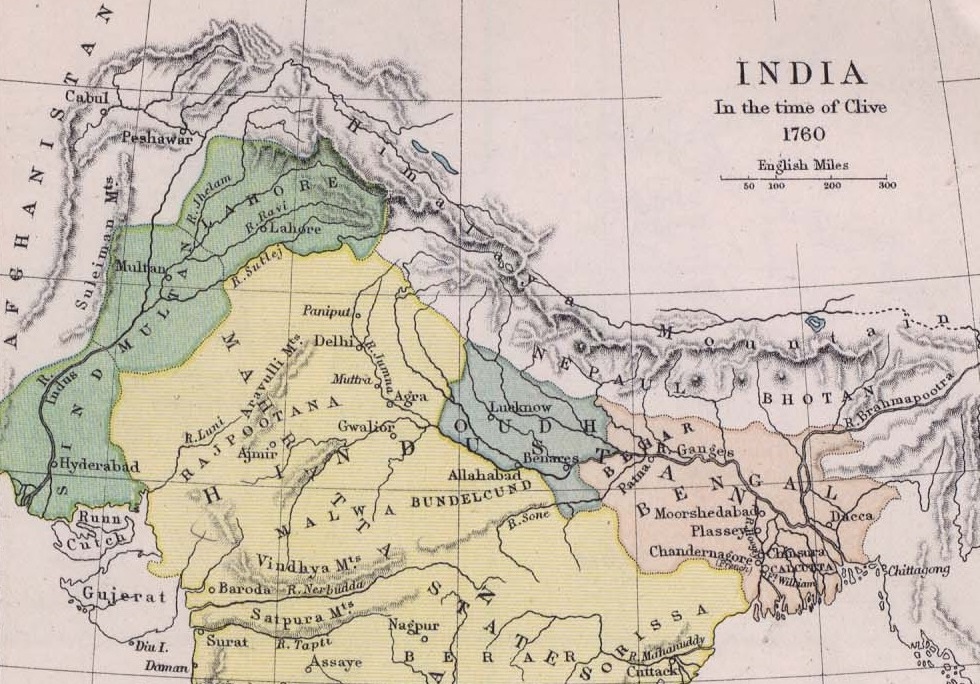
For years, Burhan-ul-Mulk had to wage war upon them. He succeeded in suppressing lawlessness and disciplining the big zamindars and thus, increasing the financial resources of his government.
Burhan-ul-Mulk also carried out a fresh revenue settlement in 1723, as he was asked to improve the peasant condition by protecting them from oppression by the big zamindars.
Like the Bengal Nawabs, Burhan-ul-Mulk too did not discriminate between Hindus and 'Muslims. Many of his commanders and high officials were Hindus and he 'curbed refractory zamindars, chiefs, and nobles irrespective of their religion. His troops were well-paid, well-armed, and Well-trained.
Before his death in 1739, Burhan-ul-Mulk had become virtually independent and had made the province a hereditary possession.
Burhan-ul-Mulk was succeeded by his nephew Safdar Jang, who was simultaneously appointed the wazir of the Empire in 1748 and granted in addition the province of Allahabad.
Safdar Jang suppressed rebellious zamindars and made an alliance with the Maratha Sardars so that his dominion was saved from their incursions.
Safdar Jang gave a long period of peace to the people of Avadh and Allahabad before his death in 1754.
The Rajput States
Many Rajput states took advantage of the growing weakness of Mughal power to virtually free themselves from central control while at the same time increasing their influence in the rest of the Empire.
In the reigns of Farrukh Siyar and Muhammad Shah, the rulers of Amber and Marwar were appointed governors of important Mughal provinces such as Agra, Gujarat, and Malwa.
The internal politics of Agra, Gujarat, Malwa, etc. were often characterized by the same type of corruption, intrigue, and treachery as prevailed at the Mughal court.
Ajit Singh of Marwar was killed by his own son.
The most outstanding Rajput ruler of the 18th century was Raja Sawai Jai Singh of Amber (1681-1743).
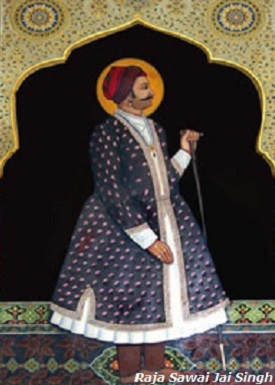
Raja Sawai Jai Singh was a distinguished statesman, law-maker, and reformer. But most of all he shone as a man of science in an age when Indians were oblivious of scientific progress.
Raja Sawai Jai Singh founded the city of Jaipur in the territory taken from the Jats and made it a great seat of science and art.
Jaipur was built upon strictly scientific principles and according to a regular plan. Its broad streets are intersected at right angles.
Jai Singh was a great astronomer. He erected observatories with accurate and advanced instruments, some of his inventions can be still observed at Delhi, Jaipur, Ujjain, Varanasi, and Mathura. His astronomical observations were remarkably accurate.
Jai Singh drew up a set of tables, entitled Zij-i Muhammadshahi, to enable people to make astronomical observations. He had Euclid's "Elements of Geometry", translated into Sanskrit as also several works on trigonometry, and Napier's work on the construction and use of logarithms.
Jai Singh was also a social reformer. He tried to enforce a law to reduce the lavish expenditure which a Rajput had to incur on a daughter's wedding and which often led to infanticide.
This remarkable prince ruled Jaipur for nearly 44 years from 1699 to 1743.
The Jats
The Jats, a caste of agriculturists, lived in the region around Delhi, Agra, and Mathura.
Repression by Mughal officials drove the Jat peasants around Mathura to revolt. They revolted under the leadership of their Jat Zamindars in 1669 and then again in 1688.
Jats’ revolts were crushed, but the area remained disturbed. After the death of Aurangzeb, they created disturbances all around Delhi. Though originally a peasant uprising, the Jat revolt, led by zamindars, soon became predatory.
Jats plundered all and sundry, the rich and the poor, the jagirdars and the peasants, the Hindus and the Muslims.
The Jat state of Bharatpur was set up by Churaman and Badan Singh.
The Jat power reached its highest glory under Suraj Mal, who ruled from 1756 to 1763 and who was an extremely able administrator and soldier and a very wise statesman.
Suraj Mal extended his authority over a large area, which extended from the Ganga in the East to Chambal in the South, the Subah of Agra in the West to the Subah of Delhi in the North. His state included among others the districts of Agra, Mathura, Meerut, and Aligarh.
After the death of Suraj Mal in 1763, the Jat state declined and was split up among petty zamindars most of whom lived by plunder.
Bangash and Rohelas
Muhammad Khan Bangash, an Afghan adventure, established his control over the territory around Farrukhabad, between what are now Aligarh and Kanpur, during the reigns of Farrukh Siyar and Muhammad Shah.
Similarly, during the breakdown of administration following Nadir Shah's invasion, Ali Muhammad Khan carved out a separate principality, known as Rohilkhand, at the foothills of the Himalayas between the Ganga in the south and the Kumaon hills in the north with its capital first at Aolan in Bareilly and later at Rampur.
The Rohelas clashed constantly with Avadh, Delhi, and the Jats.
The Sikhs
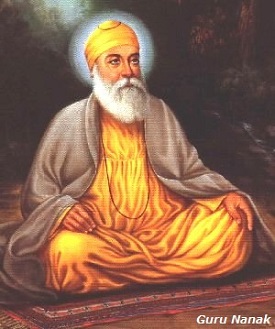
Founded at the end of the 15th century by Guru Nanak, the Sikh religion spread among the Jat peasantry and other lower castes of Punjab.
The transformation of the Sikhs into a militant, fighting community was begun by Guru Hargobind (1606-1645).
It was, however, under the leadership of Guru Gobind Singh (1664-1708), the tenth and the last Guru of the Sikhs, that Sikhs became a political and military force.
From 1699 onwards, Guru Gobind Singh waged constant war against the armies of Aurangzeb and the hill rajas.
After Aurangzeb's death Guru Gobind Singh joined Bahadur Shah's camp as a noble of the rank of 5,000 Jat at and 5,000 sawar and accompanied him to the Deccan where he was treacherously murdered by one of his Pathan employees.
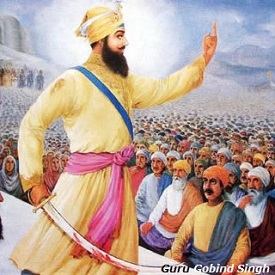
After Guru Gobind Singh's death, the institution of Guruship came to an end and the leadership of the Sikhs passed to his trusted disciple Banda Singh, who is more widely known as Banda Bahadur.
Banda rallied together the Sikh peasants of the Punjab and carried on a vigorous though unequal struggle against the Mughal army for eight years. He was captured in 1715 and put to death.
Banda Bahadur’s death gave a set-back to the territorial ambitions of the Sikhs and their power declined.
Punjab
At the end of the 18th century, Ranjit Singh, chief of the Sukerchakia Misl rose into prominence. A strong and courageous soldier, an efficient administrator, and a skillful diplomat, he was a born leader of men.
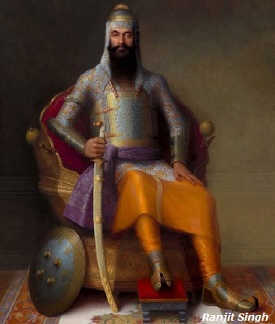
Ranjit Singh captured Lahore in 1799 and Amritsar in 1802. He soon brought all Sikh chiefs west of the Sutlej River under his control and established his own kingdom in the Punjab.
Ranjit Singh conquered Kashmir, Peshawar, and Multan. The old Sikh chiefs were transformed into big zamindars and jagirdars.
Ranjit Singh did not make any change in the system of lend revenue promulgated earlier by the Mughals. The amount of land revenue was calculated on the basis of 50 per cent of the gross produce.
Ranjit Singh built up a powerful, disciplined, and well-equipped army along European lines with the help of European instructors. His new army was not confined to the Sikhs. He also recruited Gurkhas, Biharis, Oriyas, Pathans, Dogras, and Punjabi Muslims.
Ranjit Singh set up the modern foundries to manufacture cannon at Lahore and employed Muslim gunners to man them. It is said that he possessed the second best army in Asia, the first was the army of the English East India Company
Bengal
Taking advantage of the growing weakness of the central authority, two men of exceptional ability, Murshid Quli Khan and Alivardi Khan, made Bengal virtually independent. Even though Murshid Quli Khan was made Governor of Bengal as late as 1717, he had been its effective ruler since 1700, when he was appointed its Dewan.
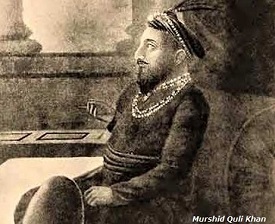
Murshid Quli Khan soon freed himself from central control though he sent regular tribute to the Emperor. He established peace by freeing Bengal of internal and external danger.
The only three major uprisings during Murshid Quli Khan’s rule were −
By Sitaram Ray,
By Udai Narayan, and
By Ghulam Muhammad.
Later Shujat Khan, and Najat Khan also rebelled during the Murshid Quli Khan’s reign.
Murshid Quli Khan died in 1727, and his son-in-law Shuja-ud-din ruled Bengal till 1739. In that year, Alivardi Khan deposed and killed Shuja-ud-din's son, Sarfaraz Khan, and made himself the Nawab.
Modern Indian History - Maratha Power
Rise and Fall of Martha Empire
The most important challenge to the decaying Mughal power came from the Maratha Kingdom, which was the most powerful of the Succession states. In fact, it alone possessed the strength to fill the political vacuum created by the disintegration of the Mughal Empire.
The Maratha Kingdom produced a number of brilliant commanders and statesmen needed for the task. But the Maratha Sardars lacked unity, and they lacked the outlook and program, which were necessary for founding an all-India empire.
Shahu, the grandson of Shivaji, had been a prisoner in the hands of Aurangzeb since 1689.
Aurangzeb had treated Shahu and his mother with great dignity, honor, and consideration, paying full attention to their religious, caste, and other needs, hoping perhaps to arrive at a political agreement with Shahu.
Shahu was released in 1707 after Aurangzeb's death.
A civil war broke out between Shahu at Satara and his aunt Tara Bai at Kolhapur who had carried out an anti-Mughal struggle since 1700 in the name of her son Shivaji II after the death of her husband Raja Ram.
Maratha Sardars, each one of whom had a large following of soldiers loyal to themselves alone began to side with one or the other contender for power.
Maratha Sardars used this opportunity to increase their power and influence by bargaining with the two contenders for power. Several of them even intrigued with the Mughal viceroys of the Deccan.
Balaji Vishwanath
Arising out of the conflict between Shahu and his rival at Kolhapur, a new system of Maratha government was evolved under the leadership of Balaji Vishwanath, the Peshwa of King Shahu.
The period of Peshwa domination in Maratha history was the most remarkable in which the Maratha state was transformed into an empire.
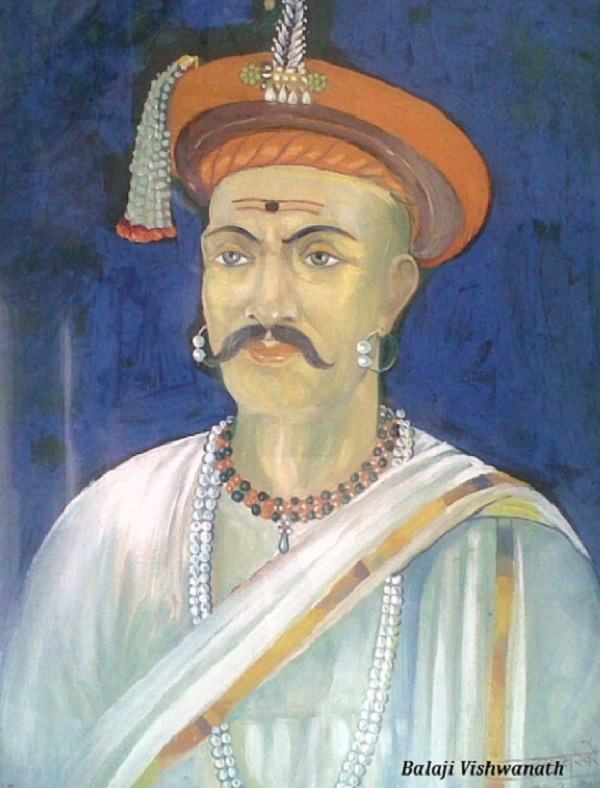
Balaji Vishwanath, a Brahmin, started life as a petty revenue official and then rose step by step as an official.
Balaji Vishwanath rendered Shahu loyal and useful service in suppressing his enemies. He excelled in diplomacy and won over many of the big Maratha Sardars.
In 1713, Shahu made him his Peshwa or the mulk pradhan (chief minister).
Balaji Vishwanath gradually consolidated Shabu's hold and his own over Maratha Sardars and over most of Maharashtra except for the region south of Kolhapur where Raja Ram's descendants ruled.
The Peshwa concentrated power in his office and eclipsed the other ministers and' seniors.
Balaji Vishwanath took full advantage of the internal conflicts of the Mughal officials to increase Maratha power.
Balaji Vishwanath had induced Zulfiqar Khan to pay the chauth and sardeshmukhi of the Deccan.
All the territories that had earlier formed Shivaji's kingdom were restored to Shahu who was also assigned the chauth and sardeshmukhi of the six provinces of the Deccan.
In 1719, Balaji Vishwanath, at the head of a Maratha force, accompanied Saiyid Hussain Ali Khan to Delhi and helped the Saiyid brothers in overthrowing Farrukh Siyar.
At Delhi, Balaji Vishwanath and the other Maratha Saradars witnessed at first hand the weakness of the Empire and were filled with the ambition of expansion in the North.
Balaji Vishwanath died in 1720 and his 20-year old son Baji Rao I succeeded as Peshwa. In spite of his youth, Baji Rao I was a bold and brilliant commander and an ambitious and clever statesman.
Baji Rao has been described as "the greatest exponent of guerrilla tactics after Shivaji".
Led by Baji Rao, the Marathas waged numerous campaigns against the Mughal Empire trying to compel the Mughal officials first to give them the right to collect the chauth of vast areas and then to cede these areas to the Maratha kingdom.
By 1740, when Baji Rao died, the Maratha had won control over Malwa, Gujarat, and parts of Bundelkhand. The Maratha families of Gaekwad, Holkar, Sindhia, and Bhonsle came into prominence during this period.
Baji Rao died in April 1740. In the short period of 20 years, he had changed the character of the Maratha state. From the kingdom of Maharashtra it had been transformed into an Empire expanding in the North (as shown in the map below).

Baji Rao's 18-year old son Balaji Baji Rao (also known as Nana Saheb) was the Peshwa from 1740 to 1761. He was as able as his father though less energetic.
King Shahu died in 1749 and by his will left all management of state affairs in the Peshwa's hands.
The office of the Peshwa had already become hereditary and the Peshwa was the de facto ruler of the state. Now Peshwa became the official head of the administration and, as a symbol of this fact, shifted the government to Poona, his headquarters.
Balaji Baji Rao followed in the footsteps of his father and further extended the Empire in different directions taking Maratha power to its height. Maratha armies now overran the whole of India.
Maratha control over Malwa, Gujarat, and Bundelkhand was consolidated.
Bengal was repeatedly invaded and, in 1751, the Nawab of Bengal had to cede Orissa.
In the South, the state of Mysore and other minor principalities were forced to pay tribute.
In 1760, the Nizam of Hyderabad was defeated at Udgir and was compelled to cede vast territories yielding an annual revenue of Rs. 62 lakhs.
Later, the arrival of Ahmad Shah Abdali and his alliance with the major kingdoms of North India (including an alliance with Najib-ud-daulah of Rohilkhand; Shuja-ud-daulah of Avadh, etc.) lead to third battle of Panipat (on January 14, 1761).
The Maratha army did not get any alliance and support resultantly was completely routed out in the third battle of Panipat.
The Peshwa's son, Vishwas Rao, Sadashiv Rao Bhau and numerous other Maratha commanders perished on the battle field as did nearly 28,000 soldiers. Those who fled were pursued by the Afghan cavalry and robbed and plundered by the Jats, Ahirs, and Gujars of the Panipat region.
The Peshwa, who was marching north to render help to his cousin, was stunned by the tragic news (i.e. defeat at Panipat). Already seriously ill, his end was hastened and he died in Jun 1761.
The Maratha defeat at Panipat was a disaster for them. They lost the cream of their army and their political prestige suffered a big blow.
Afghans did not get benefit from their victory. They could not even hold the Punjab. In fact, the Third Battle of Panipat did not decide who was to rule India, but rather who was not. The way was, therefore, cleared for the rise of the British power in India.
The 17-year old Madhav Rao became the Peshwa in 1761. He was a talented Soldier and statesman.
Within the short period of 11 years, Madhav Rao restored the lost fortunes of the Maratha Empire. He defeated the Nizam, compelled Haidar Ali of Mysore to pay tribute, and reasserted control over North India by defeating the Rohelas and subjugating the Rajput states and Jat chiefs.
In 1771, the Marathas brought back to Delhi Emperor Shah Alam who now became their pensioner.
Once again, however, a blow fell on the Marathas for Madhav Rao died of consumption in 1772.
The Maratha Empire was now in a state of confusion. At Poona there was a struggle for power between Reghunath Rao, the younger brother of Balaji Baji Rao, and Narayan Rao, the younger brother of Madhav Rao.
Narayan Rao was killed in 1773. He was succeeded by his posthumous son, Sawai Madhav Rao.
Out of frustration, Raghunath Rao approached to the British and tried to capture power with their help. This resulted in the First Anglo-Maratha War.
Sawai Madhav Rao died in 1795 and was succeeded by the utterly worthless Baji Rao II, son of Raghunath Rao.
The British had by now decided to put on end to the Maratha challenge to their supremacy in India.
The British divided the mutually-warring Maratha Sardars through clever diplomacy and then overpowered them in separate battles during the second Maratha War, 1803-1805, and the Third Maratha War, 1816-1819.
While other Maratha mates were permitted to remain as subsidiary states, the house of the Peshwas was extinguished.
Economic Conditions in 18th Century
India of the 18th century failed to make progress economically, socially, or culturally at a pace, which would have saved the country from collapse.
The increasing revenue demands of the state, the oppression of the officials, the greed and rapacity of the nobles, revenue-farmers, and zamindars, the marches and countermarches of the rival armies, and the depredations of the numerous adventurers roaming the land during the first half of the 18th century made the life of the people quite despicable.
India of those days, was also a land of contrasts. Extreme poverty existed side by side with extreme rich and luxury. On the one hand, there were the rich and powerful nobles steeped in luxury and comfort; on the other, backward, oppressed, and impoverished peasants living at the bare subsistence level and having to bear all sorts of injustices and inequities.
Even so, the life of the Indian masses was by and large better at this time than it was after over 100 years of British rule at the end of the 19th century.
Agriculture
Indian agriculture during the 18th century was technically backward and stagnant. The techniques of production had remained stationary for centuries.
The peasants tried to make up for technical backwardness by working very hard. They, In fact, performed miracles of production; moreover, they did not usually suffer from shortage of land. But, unfortunately, they seldom reaped the fruits of their labor.
Even though it was peasants’ produce that supported the rest of the society, their own reward was miserably inadequate.
Trade
Even though the Indian villages were largely self-sufficient and imported little from outside and the means of communication were backward, extensive trade within the country and between India and other countries of Asia and Europe was earned on under the Mughals.
India imported −
pearls, raw silk, wool, dates, dried fruits, and rose water from the Persian Gulf region;
coffee, gold, drugs, and honey from Arabia;
tea, sugar, porcelain, and silk from China;
gold, musk and woolen cloth from Tibet;
tin from Singapore;
spices, perfumes, attack, and sugar from the Indonesian islands;
ivory and drugs from Africa; and
woolen cloth, metals such as copper, iron, and lead, and paper from Europe.
India's most important article of export was cotton textiles, which were famous all over the world for their excellence and were in demand everywhere.
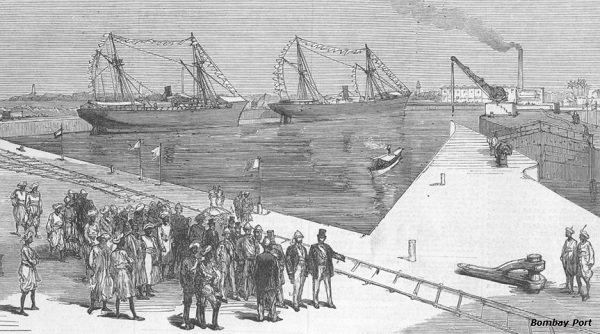
India also exported raw silk and silk fabrics, hardware, indigo, saltpeter, opium, rice, wheat, sugar, pepper and other spices, precious stones, and drugs.
Constant warfare and disruption of law and order, in many areas during the 18th century, banned the country's internal trade and disrupted its foreign trade to some extent and in some directions.
Many trading centers were looted by the Indians as well as by foreign invaders. Many of the trade routes were infested with organized bands of robbers, and traders and their caravans were regularly looted.
The road between the two imperial cities, Delhi and Agra, was made unsafe by the marauders. With the rise of autonomous provincial regimes and innumerable local chiefs, the number of custom houses or chowkies grew by leaps and bounds.
Every petty or large ruler tried to increase his income by imposing heavy customs duties on goods entering or passing though his territories.
The impoverishment of the nobles, who were the largest consumers of luxury products in which trade was conducted, also injured internal trade.
Many prosperous cities, centers of flourishing industry, were sacked and devastated.
Delhi was plundered by Nadir Shah;
Lahore, Delhi, and Mathura by Ahmad Shah Abdali;
Agra by the Jats;
Surat and other cities of Gujarat and the Deccan by Maratha chiefs;
Sarhind by the Sikhs, and so on.
The decline of internal and foreign trade also hit the industries hard in some parts of the country. Nevertheless, some industries in other parts of the country gained as a result of expansion in trade with Europe due to the activities of the European trading companies.
The important centers of textile industry were −
Dacca and Murshidabad in Bengal;
Patna in Bihar;
Surat, Ahmedabad, and Broach in Gujarat;
Chanderi in Madhya Pradesh
Burhanpur in Maharashtra;
Jaunpur, Varanasi, Lucknow, and Agra in U.P.;
Multan and Lahore in Punjab;
Masulipatam, Aurangabad, Chicacole, and Vishakhapatnam in Andhra;
Bangalore in Mysore; and
Coimbatore and Madurai in Madras.
Kashmir was a center of woolen manufactures.
Ship-building industry flourished in Maharashtra, Andhra, and Bengal.
Social Conditions in 18th Century
Social life and culture in the 18th century were marked by stagnation and dependence on the past.
There was, of course, no uniformity of culture and social patterns all over the country. Nor did all Hindus and all Muslims form two distinct societies.
People were divided by religion, region, tribe, language, and caste.
Moreover, the social life and culture of the upper classes, who formed a tiny minority of the total population, was in many respects different from the life and culture of the lower classes.
Hindu
Caste was the central feature of the social life of the Hindus.
Apart from the four vanes, Hindus were divided into numerous castes (Jatis), which differed in their nature from place to place.
The caste system rigidly divided people and permanently fixed their place in the social scale.
The higher castes, headed by the Brahmins, monopolized all social prestige and privileges.
Caste rules were extremely rigid. Inter-caste marriages were forbidden.
There were restrictions on inter-dining among members of different castes.
In some cases, persons belonging to higher castes would not take food touched by persons of the lower castes.
Castes often determined' the choice of ' profession, though exceptions did occur. Caste regulations were strictly enforced by caste councils and panchayats and caste chiefs through fines, penances (prayaschitya) and expulsion from the caste.
Caste was a major divisive force and element of disintegration in India of 18th century.
Muslim
Muslims were no less divided by considerations of caste, race, tribe, and status, even though their religion enjoined social equality.
The Shia and Sunni (two sects of Muslim religion) nobles were sometimes at loggerheads on account of their religious differences.
The Irani, Afghan, Turani, and Hindustani Muslim nobles, and officials often stood apart from each other.
A large number of Hindus converted to Islam carried their caste into the new religion and observed its distinctions, though not as rigidly as before.
Moreover, the sharif Muslims consisting of nobles, scholars, priests, and army officers, looked down upon the ajlaf Muslims or the lower class Muslims in a manner similar to that adopted by the higher caste Hindus towards the lower caste Hindus.
Modern Indian History - Status of Women
The family system in the 18th century India was primarily patriarchal, that is, the family was dominated by the senior male member, and inheritance was through the male line.
In Kerala, however, the family was matrilineal. Outside Kerala, women were subjected to nearly complete male control.
Women were expected to live as mothers and wives only, though in these roles they were shown a great deal of respect and honor.
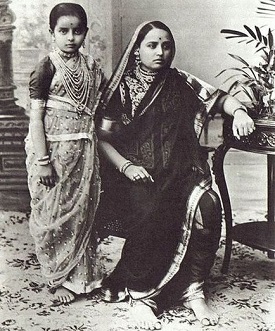
Even during war and anarchy, women were seldom molested and were treated with respect.
A European traveler, Abbe J.A. Dubois, commented, at the beginning of the 19th century −
"A Hindu woman can go anywhere alone, even in the most crowded places, and she need never fear the impertinent looks and jokes of idle loungers....A house inhabited solely by women is a sanctuary which the most shameless libertine would not dream of violating."
The women of the time possessed title individuality of their own. This does not mean that there were no exceptions to this rule. Ahilya Bai administered Indore with great success from 1766 to 1796.
Many Hindu and Muslim ladies played important roles in 18th century politics.
While women of the upper classes were not supposed to work outside their homes, peasant women usually worked in the fields and women of the poorer classes often worked outside their homes to supplement the family income.
The purdah was common mostly among the higher classes in the North. It was not practiced in the South.
Boys and girls were not permitted to mix with each other.
All marriages were arranged by the heads of the families. Men were permitted to have more than one wife, but except for the well-off, they normally had only one.
On the other hand, a woman was expected to marry only once in her life-time.
The custom of early marriage prevailed all over the country.
Sometimes children were married when they were only three or four years of age.
Among the upper classes, the evil customs of incurring heavy expenses on marriages and of giving dowry to the bride prevailed.
The evil of dowry was especially widespread in Bengal and Rajputana culture.
In Maharashtra, it was curbed to some extent by the energetic steps taken by the Peshwas.
Two great social evils of the 18th century India, apart from the caste system, were the custom of sati and the harrowing condition of widows.
Sati involved the rite of a Hindu widow burning herself (self-immolation) along with the body of her dead husband.
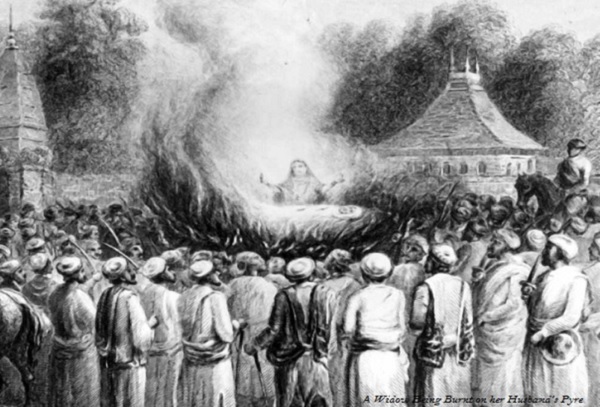
Sati practice was mostly prevalent in Rajputana, Bengal, and other parts of northern India. In the South it was uncommon: and the Marathas did not encourage it.
Even in Rajputana and Bengal, it was practiced only by the families of rajas, chiefs, big zamindars, and upper castes.
Widows belonging to the higher classes and higher castes could not remarry, though in some regions and in some castes, for example, among non-Brahmins in Maharashtra, the Jats and people of the hill-regions of the North, widow remarriage was quite common.
There were all sorts of restrictions on her clothing, diet, movements, etc. In general, she was expected to renounce all the pleasures of the earth and to serve selflessly the members of her husband's or her brother's family, depending on where she spent the remaining years of her life.
Raja Sawai Jai Singh of Amber and the Maratha General Prashuram Bhau tried to promote widow remarriage but failed.
Modern Indian History - Arts and Paintings
Culturally, India showed signs of exhaustion during the 18th century. But at the same time, culture remained wholly traditionalist as well as some development took place.
Many of the painters of the Mughal School migrated to provincial courts and flourished at Hyderabad, Lucknow, Kashmir, and Patna.
The paintings of Kangra and Rajput Schools revealed new vitality and taste.
In the field of architecture, the Imambara of Lucknow reveals proficiency in technique.
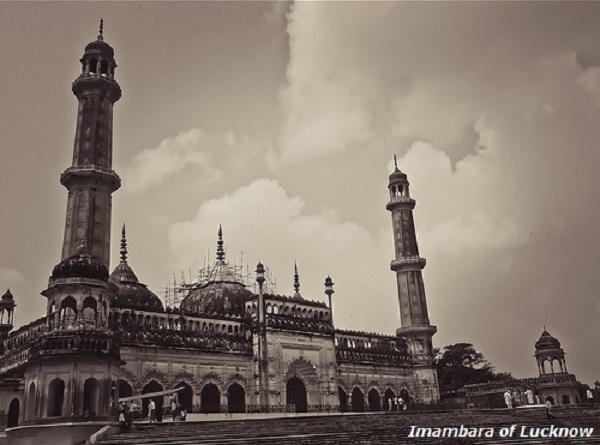
The city of Jaipur and its buildings are an example of continuing vigor.
Music continued to develop and flourish in the 18th century. Significant progress was made in this field in the reign of Mohammad Shah.
Literary Works
Poetry in reality, all the Indian languages lost its touch with life and became decorative, artificial, mechanical, and traditional.
A noteworthy feature of the literary life of the 18th century was the spread of Urdu language and the vigorous growth of Urdu poetry.
Urdu gradually became the medium of social intercourse among the upper classes of northern India.
The 18th century Kerala also witnessed the full development of Kathakali literature, drama, and dance.
Tayaumanavar (1706-44) was one of the best exponents of sittar poetry in Tamil. In line with other poets, he protested against the abuses of temple-rule and the caste system.
In Assam, literature developed under the patronage of the Ahom kings.
Heer Ranjha, the famous romantic epic in Punjabi, was composed at this time by Warris Shah.
For Sindhi literature, the 18th century was a period of enormous achievement.
Shah Abdul Latif composed his famous collection of poems.
Modern Indian History - Social Life
Cultural activities of the time were mostly financed by the Royal Court, rulers, and nobles and chiefs whose impoverishment led to their gradual neglect.
Friendly relations between Hindus and Muslims were a very healthy feature of life in 18th century.
Politics were secular in spite of having fights and wars among the chiefs of the two groups (Hindus and Muslims).
There was little communal bitterness or religious intolerance in the country.
The common people in the villages and towns who fully shared one another’s joys and sorrows, irrespective of religious affiliations.
Hindu writers often wrote in Persian while Muslim writers wrote in Hindi, Bengali, and other vernaculars.
The development of Urdu language and literature provided a new meeting ground between Hindus and Muslims.
Even in the religious sphere, the mutual influence, and respect that had been developing in the last few centuries as result of the spread of the Bhakti movement among Hindus and Sufism among Muslim saints was the great example of unity.
Education
Education was not completely neglected in 18th century India, but it was on the whole defective.
It was traditional and out of touch with the rapid developments in the West. The knowledge which it imparted was confined to literature, law, religion, philosophy, and logic, and excluded the study of physical and natural sciences, technology, and geography.
In all fields original thought was discouraged and reliance placed on the ancient learning.
The centers of higher education were spread all over the country and were usually financed by nawabs, rajas, and rich zamindars.
Among the Hindus, higher education was based on Sanskrit learning and was mostly confined to Brahmins.
Persian education being based on the official language of the time was equally popular among Hindus and Muslims.
A very pleasant aspect of education then was that the teachers enjoyed high prestige in the community. However, a bad feature of it was that girls were seldom given education, though some women of the higher classes were an exception.
The Beginnings of European Trade
India's trade relations with Europe go back to the ancient days of the Greeks. During the middle Ages, trade between Europe and India and South-East Asia was carried through various routes.
Trade Routes
Major trade routes were −
Through sea - along the Persian Gulf;
Through land- through Iraq and Turkey, and then again by sea to Venice and Genoa;
Third was via the Red Sea and then overland to Alexandria in Egypt and from there again by sea to Venice and Genoa.
The fourth one was less used i.e. overland route through the passes of the North-West frontier of India, across Central Asia, and Russia to the Baltic.
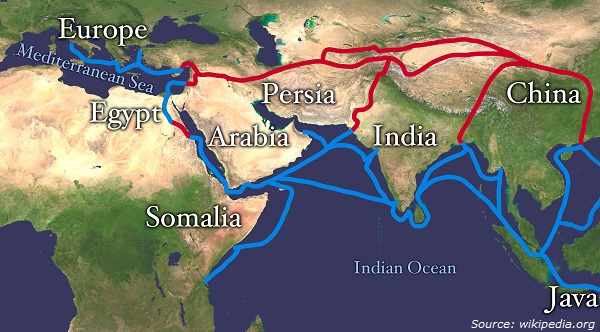
The Asian part of the trade was carried on mostly by Arab merchants and sailors, while the Mediterranean and European part was the virtual monopoly of the Italians.
Goods from Asia to Europe passed through many states and many hands. Every state levied tolls and duties while every merchant made a substantial profit.
There were many other obstacles, such as pirates and natural calamities on the way. Yet the trade remained highly profitable. This was mostly due to the pressing demand of the European people for Eastern spices.
The Europeans needed spices because they lived on salted and peppered meat during the winter months, when there was little grass to feed the cattle, and only a liberal use of spices could make this meat palatable. Consequently, European food was as highly spiced as Indian food till the 17th century.
The old trading routes between the East and the West came under Turkish control after the Ottoman conquest of Asia Minor and the capture of Constantinople in 1453.
The merchants of Venice and Genoa monopolized the trade between Europe and Asia and refused to let the new nation states of Western Europe, particularly Spain, and Portugal, have any share in the trade through these old routes.
The trade with India and Indonesia was highly prized by the West Europeans to be so easily given up.
The demand for spices was pressing and the profits to be made in their trade inviting.
The reputedly fabulous wealth of India was an additional attraction as there was an acute shortage of gold all over Europe, and gold was essential as a medium of exchange if the trade was to grow unhampered.
The West European states and merchants therefore began to search for new and safer sea routes to India and the Spice Islands of Indonesia, (at that time popular as the East Indies).
The West Europeans wanted to break the Arab and Venetian trade monopolies, to bypass Turkish hostility, and to open direct trade relations with the East.
The West European were well-equipped to do so as great advances in shipbuilding and the science of navigation had taken place during the 15th century. Moreover, the Renaissance had generated a great spirit of adventure among the people of Western Europe.
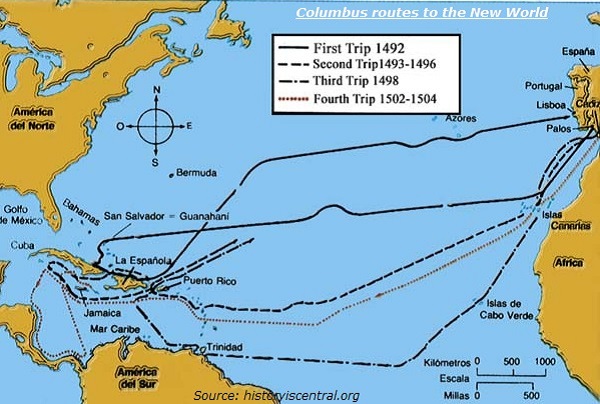
The first steps were taken by Portugal and Spain whose seamen, sponsored and controlled by their governments, began a great era of geographical discoveries.
In 1494, Columbus of Spain set out to reach India and discovered America instead of India.
Modern Indian History - The Portuguese
In 1498, Vasco da Gama of Portugal discovered a new and all-sea route from Europe to India. He sailed around Africa via the Cape of Good Hope (South Africa) and reached Calicut (as shown in the map given below).
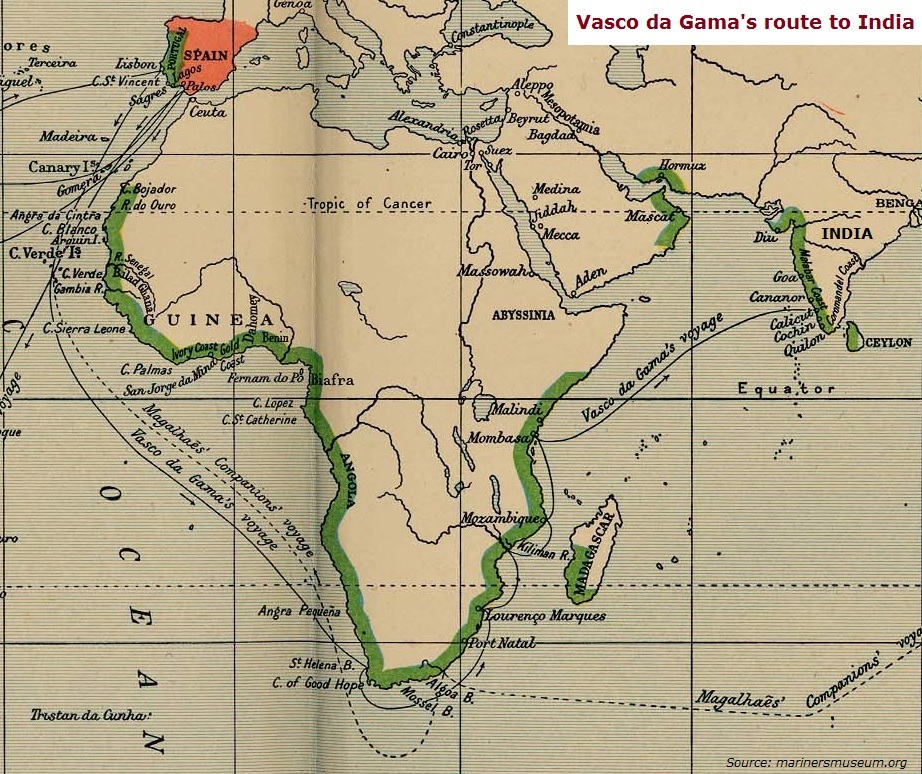
Vasco da Gama returned with a cargo, which sold for 60 times the cost of his voyage.
Columbus and Vasco da Gama’s sea routes along with other navigational discoveries opened a new chapter in the history of the world.
Adam Smith wrote later that the discovery of America and the Cape route to India were "the two greatest and most important events recorded in the history of mankind."
The new continent was rich in precious metals. Its gold and silver poured into Europe where they powerfully stimulated trade and provided some of the capital, which was soon to make European nations the most advanced in trade, industry, and science.
America became a new and inexhaustible market for European manufacturers.
Some other source of early capital accumulation or enrichment for European countries was their penetration into African land in the middle of the 15th century.
In the beginning, gold and ivory of Africa had attracted the foreigner. Very soon, however, trade with Africa concentrated on the slave trade.
In the 16th century, this trade was a monopoly of Spain and Portugal; later it was dominated by Dutch, French, and British merchants.
Year after year (particularly after 1650), thousands of Africans were sold as slaves in the West Indies and in North and South America.
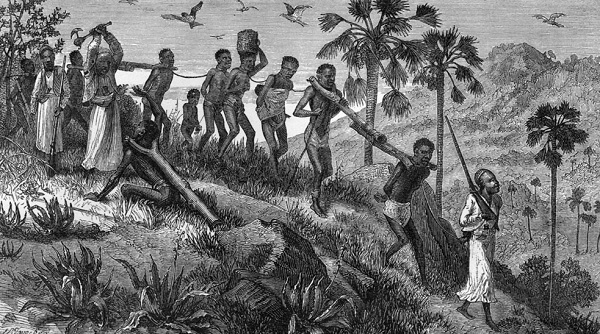
The slave ships carried manufactured goods from Europe to Africa, exchanged them on the coast of Africa for Negroes, took these slaves across the Atlantic and exchanged them for the colonial produce of plantations or mines, and finally brought back and sold this produce in Europe.
While no exact record of the number of Africans sold into slavery exists, historians' estimate, ranged between 15 and 50 million.
Slavery was later abolished in the 19th century after it had ceased to play an important economic role, but it was openly defended and praised as long as it was profitable.
Monarchs, ministers, members of Parliament, dignitaries of the church, leaders of public opinion, and merchants and industrialists supported the slave trade.
On the other hand, in Britain, Queen Elizabeth, George III, Edmund Burke, Nelson, Gladstone, Disraeli, and Carlyle were some of the defenders and apologists of slavery.
Portugal had a monopoly of the highly profitable Eastern trade for nearly a century. In India, Portugal established her trading settlements at Cochin, Goa, Diu, and Daman.
From the beginning, the Portuguese combined the use of force with trade and they were helped by the superiority of their armed ships which enabled them to dominate the seas.
Portuguese also saw that they could take advantage of the mutual rivalries of the Indian princes to strengthen their position.
Portuguese intervened in the conflict between the rulers of Calicut and Cochin to establish their trading centers and forts on the Malabar Coast. Likewise, they attacked and destroyed Arab shipping, brutally killing hundreds of Arab merchants and seamen. By threatening Mughal shipping, they also succeeded in securing many trading concessions from the Mughal Emperors.

Under the viceroyalty of Alfanso d’ Albuquerque, who captured Goa in 1510, the Portuguese established their domination over the entire Asian land from Hormuz in the Persian Gulf to Malacca in Malaya and the Spice Islands in Indonesia.
Portuguese seized Indian territories on the coast and waged constant war to expand their trade and dominions and safeguard their trade monopoly from their European rivals.
In the words of James Mill (the famous British historian of the 19th century): "The Portuguese followed their merchandise as their chief occupation, but like the English and the Dutch of the same period, had no objection to plunder, when it fell in their way."
The Portuguese were intolerant and fanatical in religious matters. They indulged in forcible conversion offering people the alternative of Christianity or sword.
Portuguese approach was particularly hateful to people of India (where the religious tolerance was the rule). They also indulged in inhuman cruelties and lawlessness.
In spite of their barbaric behavior, Portuguese possessions in India survived for a century because −
They (Portuguese) enjoyed control over the high seas;
Their soldiers and administrators maintained strict discipline; and
They did not have to face the fight of the Mughal Empire as South India was outside Mughal influence.
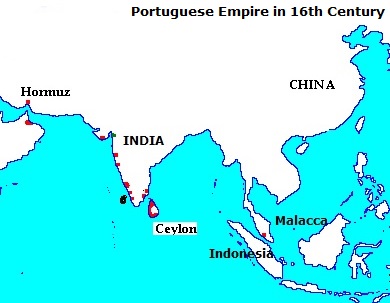
Portuguese clashed with the Mughal power in Bengal in 1631 and were driven out of their settlement at Hugli.
The Portuguese and the Spanish had left the English and the Dutch far behind during the 15th century and the first half of the 16th century. But, in the latter half of the 16th century, England and Holland, and later France, all growing commercial and naval, powers, waged a fierce struggle against the Spanish and Portuguese monopoly of world trade.
Portuguese hold over the Arabian Sea had been weakened by the English and their influence in Gujarat had become negligible.
Decline of Portuguese
Portugal was, however, incapable of maintaining for long its trade monopoly or its dominion in the East because of −
Its population was less than a million;
Its Court was autocratic and decadent;
Its merchants enjoyed much less power and prestige than its landed aristocrats;
It lagged behind in the development of shipping, and
It followed a polity of religious intolerance.
It became a Spanish dependency in 1530.
In 1588, the English defeated the Spanish fleet called the Armada and shattered Spanish naval supremacy forever.
Modern Indian History - The Dutch
The weakening of Portuguese enabled the English and the Dutch merchants to use the Cape of Good Hope route to India and so to join in the race for empire in the East.
At the end, the Dutch gained control over Indonesia and the British over India, Ceylon, and Malaya.
In 1595, four Dutch ships sailed to India via the Cape of Good Hope.
In 1602, the Dutch East India Company was formed and the Dutch States General (the Dutch parliament) gave it a Charter empowering it to make war, conclude treaties, acquire territories, and build fortresses.
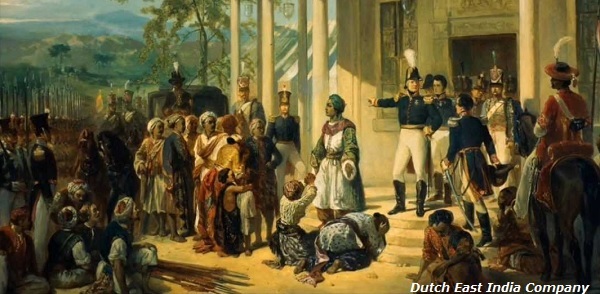
The main interest of Dutch was not in India, but in the Indonesian Islands of Java, Sumatra, and the Spice Islands where spices were produced.
Dutch forced back the Portuguese from the Malay Straits and the Indonesian Islands and, in 1623, defeated English who attempted to establish themselves on the islands.
In the first half of 17th century, Dutch had successfully seized the most important profitable part of Asian trade.
Dutch also established trading depots at −
Surat, Broach, Cambay, and Ahmadabad in Gujarat;
Cochin in Kerala;
Nagapatam in Madras;
Masulipatam in Andhra
Chinsura in Bengal;
Patna in Bihar; and
Agra in Uttar Pradesh.
In 1658, also conquered Ceylon from the Portuguese.
Dutch exported indigo, raw silk, cotton textiles, saltpeter, and opium from India.
Like the Portuguese, Dutch treated the people of India with cruelty and exploited them ruthlessly.
Modern Indian History - The English
An English association or company to trade with the East was formed in 1599 under the auspices of a group of merchants known as the Merchant Adventurers. The company was granted a Royal Charter and the exclusive privilege to trade in the East by Queen Elizabeth on 31 December 1600. The company was named as the East India Company.
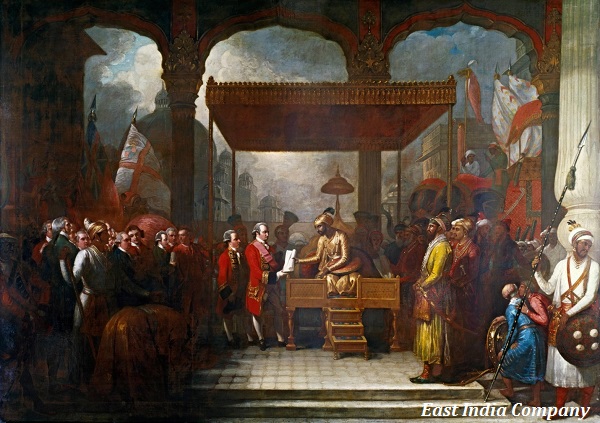
From the beginning, it was linked with the monarchy: Queen Elizabeth (1558-1603) was one of the shareholders of the company.
The first voyage of the English East India Company was made in 1601 when its ships sailed to the Spice Islands of Indonesia.
In 1608, a factory was established at Surat, on the West coast of India and sent Captain Hawkins to Jahangir’s Court to obtain Royal favors.
Initially, Hawkins was received in a friendly manner. He was given a mansab and a jagir. Later, he was expelled from Agra as a result of Portuguese intrigue. This convinced the English (need) to overcome Portuguese influence at the Mughal Court if they were to obtain any concessions from the Imperial Government.
English defeated a Portuguese naval squadron at Swally near Surat in 1612 and then again in 1614. These victories led the Mughals to hope that in view of their naval weakness, they could use the English to counter the Portuguese on the sea.
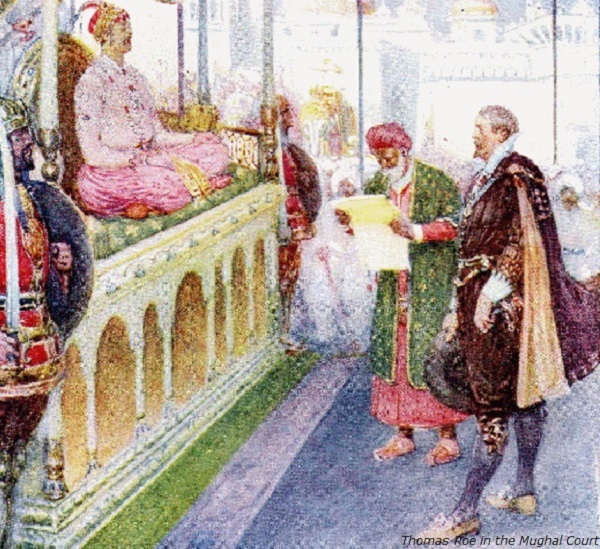
In 1615, English ambassador Sir Thomas Roe reached the Mughal Court (shown in the image given above) and exerted pressure on the Mughal authorities by taking advantage of India's naval weakness. English merchants also harassed the Indian traders while shipping through the Red Sea and to Mecca. Thus, combining entreaties with threats, Roe succeeded in getting an imperial Farman to trade and establish factories in all parts of the Mughal Empire.
Roe's success further angered the Portuguese and a fierce naval battle between the two countries began in 1620 that ended with English victory.
Hostilities between the English and Portuguese came to an end in 1630.
In 1662, the Portuguese gave the Island of Bombay to King Charles II of England as dowry for marrying with a Portuguese Princess.
Eventually, the Portuguese lost all their possessions in India except Goa, Diu, and Daman.
The English Company fell out with the Dutch Company over division of the spice trade of the Indonesian Islands. Finally, the Dutch nearly expelled the English from the trade of the Spice Islands and the later were compelled to concentrate on India where the situation was more favorable to them.
The intermittent war in India between the English and the Dutch had begun in 1654 and ended in 1667; when the English gave up all claims to Indonesia while the Dutch agreed to leave alone the English settlements in India.
The English, however, continued their efforts to drive out the Dutch from the Indian trade and by 1795, they had expelled the Dutch from their last possession in India.
The English East India Company had very humble beginnings in India. Surat was the center of its trade till 1687.
Throughout the trading period, the English refrained petitioners before the Mughal authorities. By 1623, they had established factories at Surat, Broach, Ahmedabad, Agra, and Masulipatam.
East India Company (1600-1744)
The English East Company had very humble beginnings in India. Surat was the center of its trade till 1687.
The Beginning and Growth of East India Company
By 1623, English East India Company had established factories at Surat, Broach, Ahmedabad, Agra, and Masulipatam.
From the very beginning, the English trading company tried to combine trade and diplomacy with war and control of the territory where their factories were situated.
In 1625, the East India Company's authorities at Surat made an attempt to fortify their factory, but the chiefs of the English factory were immediately imprisoned and put in irons by the local authorities of the Mughal Empire.
The Company's English rivals made piratical attacks on Mughal shipping, the Mughal authorities imprisoned the President of the Company in retaliation at Surat and members of his Council and released them only on payment of £18,000.
Conditions in the South India were more favorable to the English, as they did not have to face a strong Indian Government there.
The English opened their first factory in the South at Masulipatam in 1611. But they soon shifted the center of their activity to Madras the lease of which was granted to them by the local king in 1639.
The English built a small fort around their factory called Fort St. George in Madras (shown in the image given below).
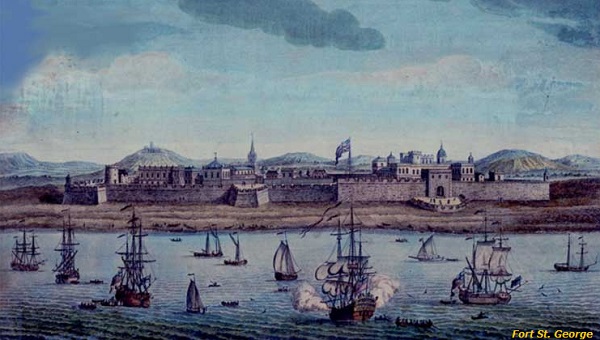
By the end of the 17th century, the English Company was claiming full sovereignty over Madras and was ready to fight in, defence of the claim. Interestingly enough, from the very beginning, English Company of profit seeking merchants was also determined to make Indians pay for the conquest of their own country.
In Eastern India, the English Company had opened its first factories in Orissa in 1633.
English Company was given permission to trade at Hugli in Bengal. It soon opened factories at Patna, Balasore, Dacca, and other places in Bengal and Bihar.
Englishmen’s easy success in trade and in establishing independent and fortified settlements at Madras and at Bombay, and the preoccupation of Aurangzeb with the anti-Maratha campaigns led the English to abandon the role of humble petitioners.
English Company now dreamt of establishing political power in India, which would enable them to compel the Mughals to allow them a free hand in trade, to force Indians to sell cheap and buy costly goods.
Hostilities between the English and the Mughal Emperor broke out in 1686, after the former had sacked Hugli and declared war on the Emperor. But the English had seriously miscalculated the situation and underestimated Mughal strength.
The Mughal Empire under Aurangzeb was even now more than a match for the petty forces of the East India Company. The war proved disastrous to the English.
The English were driven out of their factories in Bengal and compelled to seek protection in a fever-stricken island at the mouth of the Ganga.
Their factories at Surat, Masulipatam, and Vishikhapatam were seized and their fort at Bombay besieged.
Having discovered that they were not yet strong enough to fight with the Mughal power, the English once again became humble petitioners and submitted "that the ill crimes they have done may be pardoned."
Once again they relied on flattery and humble entreaties to get trading concessions from the Mughal Emperor. The Mughal authorities readily pardoned the English folly as they had no means of knowing that these harmless-looking foreign traders would one day pose a serious threat to the country.
English, though weak on land, were, because of their naval supremacy, capable of completely ruining Indian trade and shipping to Iran, West Asia, Northern and Eastern Africa, and East Asia.
Aurangzeb therefore permitted them to resume trade on payment of Rs. 150,000 as compensation.
In 1691, the Company was granted exemption from the payment of custom duties in Bengal in return for Rs. 3,000 a year.
In 1698, the Company acquired the zamindari of the three villages Sutanati, Kalikata, and Govindpur where the English built Fort William around its factory. These villages soon grew into a city, which came to be known as Calcutta (now Kolkata).
During the first half of the 18th century, Bengal was ruled by strong Nawabs namely Murshid Quli Khan and Alivardi Khan.
Nawabs of Bengal exercised strict control over the English traders and prevented them from misusing their privileges. Nor did they allow them to strengthen fortifications at Calcutta or to rule the city independently.
British settlements in Madras, Bombay, and Calcutta became the nuclei of flourishing cities. Large numbers of Indian merchants and bankers were attracted to these cities.
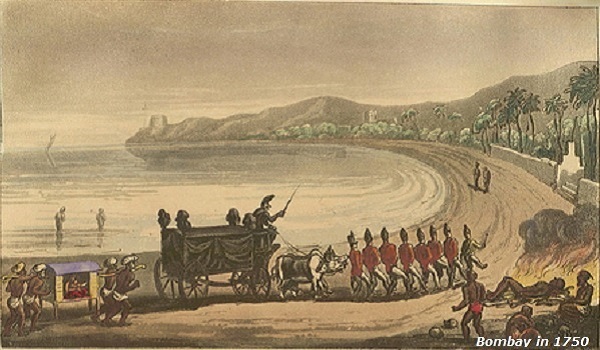
People attracted towards Madras, Bombay, and Calcutta partly due to the new commercial opportunities available in these cities and partly due to the unsettled condition and insecurity outside them, caused by the break-up of the Mughal Empire.
By the middle of the 18th century, the population of Madras had increased to 300,000, of Calcutta 200,000, and of Bombay to 70,000. It should also be noted that these three cities contained fortified English settlements; they also had immediate access to the sea where English naval power remained far superior to that of the Indians.
In case of conflict with any Indian authority, the English could always escape from these cities to the sea. And when a suitable opportunity arose for them to take advantage of the political disorders in the country, they could use these strategic cities as spring-boards for the conquest of India.
Internal Organization of the Company
The Charter of 1600 granted the East India Company the exclusive privilege of trading East of the Cape of Good Hope for a period of 15 years.
The Charter provided for the management of the Company by a committee consisting of a Governor, a Deputy-Governor, and 24 members to be elected by a general body of the merchants forming the Company. This committee later on came to be known as the 'Court of Directors' and its members as 'Directors'.
The East Indian Company soon became the most important trading company of England. Between 1601 and 1612 its rate of profit recorded about 20 per cent per annum.
Profits of the East Indian Company were derived both from trade and from piracy, there was no clear dividing line between the two at the time.
In 1612, the Company made a profit of £ 1,000,000 on a capital of 200,000.
The Company was a strictly closed corporation or a monopoly. No non-member was allowed to trade with the East or to share in its high profits.
From the very beginning, the English manufacturers and those merchants who could not secure a place in the ranks of the monopoly companies carried on a vigorous campaign against royal monopolies like the Fast India Company. But the monarchs threw their influence behind the big companies who gave heavy bribes to them and to other influential political leaders.
From 1609 to 1676, the Company gave loans amounting to £ 170,000 to Charles II. In return, Charles II granted it a series of Charters confirming its previous privileges, empowering it to build forts, raise troops, make war and peace with the powers of the East, and authorizing its servants in India to administer justice to all Englishmen and others living in English settlements. Thus the Company occulted extensive military and judicial powers.
Many English merchants continued to trade in Asia in spite of the monopoly of the East India Company. They called themselves 'Free Merchants' while the Company called them Interlopers.'
The Interlopers in the end, compelled the Company to take them into partnership.
A change of fortunes occurred in 1688 when Parliament became supreme in England as a result of the Revolution of 1688, which overthrew the Stuart king James II and invited William III and his wife Mary to be the joint sovereign of Britain.
The "Free Merchants" now began to press their case on the public and the Parliament. But the Company defended itself by giving heavy bribes to the King, his ministers, and members of the Parliament. In one year alone it spent 80,000 on bribes, giving the King £ 10,000. In the end, they secured a new Charter in 1693.
The time was running against the Company; its success was short-lived. In 1694, the House of Commons passed a Resolution that "a subjects of England have equal rights to trade in the East Indies, unless prohibited by Act of Parliament."
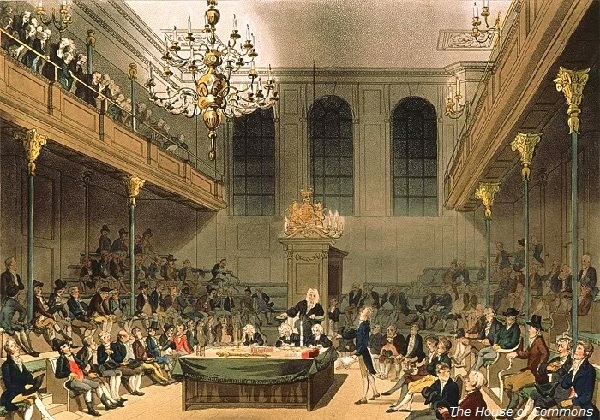
The rivals of the Company founded another Company and gave a loan of £ 2,000,000 to the Government at a time when the Old Company could offer only £ 700,000. Consequently, the Parliament granted the monopoly of trade with the East to the New Company.
The Old Company refused to give up its profitable trade so easily. It bought large shares in the New Company to be able to influence its policies. At the same time, its servants in India refused to let the servants of the New Company carry on trade.
Both the New and Old companies faced ruin as a result of their mutual conflict. Finally, in 1702, the two deckled to join forces and together formed a united company.
The new company entitled as 'The Limited Company of Merchants of England trading to the East Indies' came into existence in 1708.
Company’s Factories in India
As the East India Company gradually grew in power and tended to acquire the status of a sovereign state in India, the organization of its factories in India too changed and developed accordingly.
A factory of the Company was generally a fortified area within which the warehouses (stores), offices, and houses of the Company's employees were situated.
The Company's servants were divided into three ranks −
Writers,
Factors, and
Merchants.
All three ranked employees lived and dined together as if in a hostel and at Company's cost.
The Factory with its trade was administered by a Governor-in-Council. The Governor was merely the President of the Council and had no power apart from the Council which took decisions by a majority vote. The Council consisted of senior merchants of the Company.
Anglo-French Struggle in South India
Introduction
In Southern India, however, conditions were gradually becoming favorable to foreign adventurers, as the central authority had disappeared there after the death of Aurangzeb (1707) and Nizam-ul-Mulk Asaf Jah (1748).
The Maratha chiefs regularly invaded Hyderabad and the rest of the South for collecting Chauth (tax).
The absence of central power gave the foreigners an opportunity to expand their political influence and control over the affairs of the South Indian states.
For nearly 20 years from 1744 to 1763, the French and the English were to wage a bitter war for control over the trade, wealth, and territory of India.
The French East India Company was founded in 1664. It made rapid progress and it was reorganized in the 1720's and soon began to catch up with the English Company.
It was firmly established at Chandernagore near Calcutta and Pondicherry on the East Coast.
The French Company had some other factories at several ports on the East and the West coasts. It had also acquired control over the islands of Mauritius and Reunion in the Indian Ocean.
The French East India Company was heavily dependent on the French Government, which helped it by giving it treasury grants, subsidies, and loan, etc.
The French East India Company was largely controlled by the Government, which appointed its directors after 1723.
The French state of the time was autocratic, semi-feudal, and unpopular and sniffled from corruption, inefficiency, and instability.
Instead of being forward-looking, it was decadent, bound by tradition, and in general unsuited to the times. Control by such a state could not but be injurious to the interests of the Company.
In 1742, war broke out in Europe between France and England. One of the major causes of the war was rivalry over colonies in America. Another was their trade rivalry in India. This rivalry was intensified by the knowledge that the Mughal Empire was disintegrating and so the prize of trade or territory was likely to be much bigger than in the past.
Anglo-French conflict in India lasted for nearly 20 years and led to the establishment of British power in India.
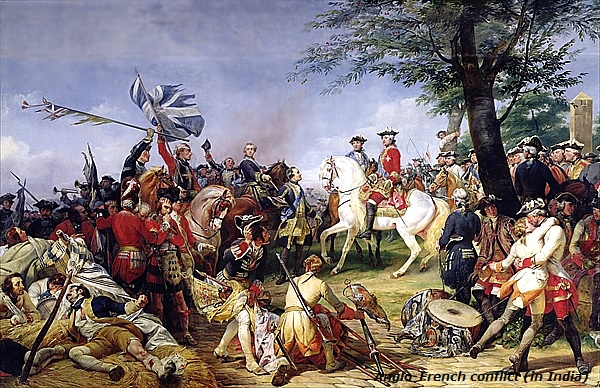
The English Company was the wealthier of the two because of its superiority in trade. It also possessed naval superiority.
In 1745, the English navy captured French ships off the South-east coast of India and threatened Pondicherry.
Dupleix
Dupleix, the French Governor-General at Pondicherry, was a statesman of genius and imagination. Under his brilliant leadership, the French retaliated and occupied Madras in 1746.
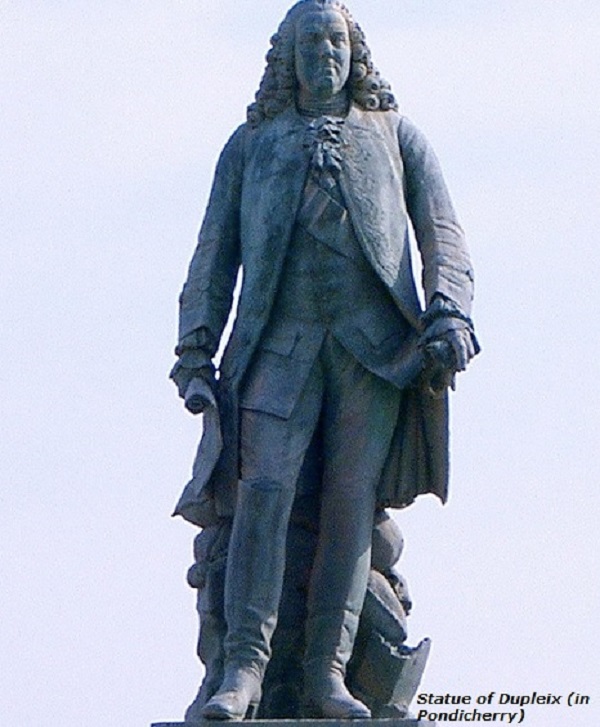
After defeated by France, the British appealed to the Nawab of Carnatic (in whose territory Madras was situated), to save their settlement from the French.
The Nawab sent an army against the French to stop the two foreign trading companies from fighting on his soil. And so the 10,000 strong armies of the Nawab clashed with a small French force, consisting of 230 Europeans and 700 Indian soldiers trained along Western lines, at St. Thorne on the banks of the Adyar River.
The Nawab was decisively defeated. This battle revealed the immense superiority of Western armies over Indian armies because of their better equipment and organization.
In 1748, the general war between England and France ended and, as a part of the peace settlement, Madras was restored to the English.
In the Carnatic, Chanda Sahib began to conspire against the Nawab, Anwaruddin, while in Hyderabad the death of Asaf Jah (Nizam-ul-Mulk), was followed by civil war between his son Nash Jang and his grandson Muzaffar Jang.
Dupleix seized concluded a secret treaty with Chanda Sahib and Muzaffar Jang to help them with his well-trained French and Indian forces.
In 1749, the three allies defeated and killed Anwaruddin in a battle at Ambur.
Carnatic passed under the dominion of Chanda Sahib who rewarded the French with a grant of 80 villages around Pondicherry.
In Hyderabad, the French were successful. Nasir Jung was killed and Muzaffar Jang became the Nizam or Viceroy of the Deccan.
Muzaffar Jang rewarded the French Company by giving territories near Pondicherry as well as the famous town of Masulipatam.
Dupleix stationed his best officer, Bussy, at Hyderabad with a French army. While the ostensible purpose of this arrangement was to protect the Nizam from enemies, it was really aimed at maintaining French influence at his court.
While Muzaffar Jang was marching towards his capital, he was accidentally killed. Bussy immediately raised Salabat Jang, the third son of Nizam-ul-Mulk, to the throne.
Salabat Jang, in return, granted the French the area in Andhra known as the Northern Sarkars, consisting of the four districts of Mustafanagar, Ellore, Rajahmundry, and Chicacole.
The French had started out by trying to win Indian states as friends; they had ended by making them clients or satellites. But the English had not been silent spectators of their rival's successes. To offset French influence and to increase their own, they (British) had been intriguing with Nasir Jung and Muhammad Ali.
In 1750, British decided to throw their entire strength behind Muhammad Ali.
Robert Clive, a young clerk in the Company's service, proposed that French pressure on Muhammad Ali, besieged at Trichinopoly, could be released by attacking Arcot, the capital of Carnatic. The proposal accepted and Clive assaulted and occupied Arcot with only 200 English and 300 Indian Soldiers.
Dupleix made strenuous attempts to reverse the tide of French misfortunes. But he was given little support by the French Government or even by the higher authorities of the French East India Company.
In the end, the French Government, weary of the heavy expense of the war in India and fearing the loss of its American colonies, initiated peace negotiations and agreed in 1754 to the English demand for the recall of Dupleix from India.
The temporary peace between the two Companies (British and France) ended in 1756 when another war between England and France broke out.
The French Government made a determined attempt to oust the English from India and sent a strong force headed by Count de Lally, it was all in vain.
The French fleet was driven off Indian waters and the French forces in the Carnatic were defeated.
The English replaced the French as the Nizam’s protectors and secured from him Muslipatam and the Northern Sarkar.
The decisive battle was fought at Wandiwash on 22 January 1760 when the English General Eyre Coot defeated Lally. The war ended in 1763 with the signing of the Treaty of Paris.
The French factories in India were restored but they could no longer be fortified or even adequately garrisoned with troops. They could serve only as centers of trade; and now the French lived in India under British protection.
The British Conquest of India
The British conquest India strategically i.e. one after another.
The British Occupation of Bengal
The beginning of British political influence over India may be traced to the battle of Plassey in 1757, when the English East India Company's forces defeated Siraj-ud-Daulah, the Nawab of Bengal.
As result of the Battle of Plassey, the English proclaimed Mir Jafar the Nawab of Bengal and set out to gather the reward i.e. the company was granted undisputed right to free trade in Bengal, Bihar, and Orissa.
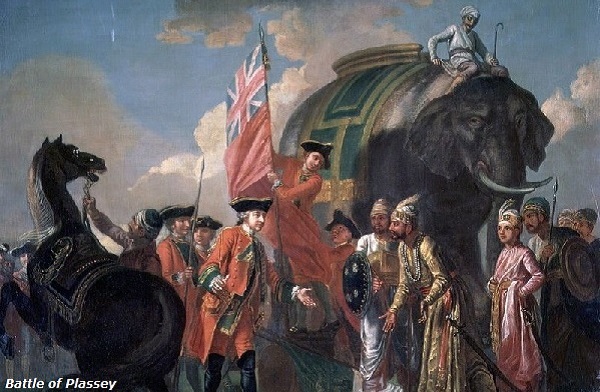
The East Company received the zamindari of the 24 Parganas near Calcutta. Mir Jafar paid a sum of Rs 17,700,000 as compensation for the attack on Calcutta and the traders of the city.
The battle of Plassey was of immense historical importance, as it paved the way for the British mastery on Bengal and eventually on the whole of India.
The victory of Plassey enabled the Company and its servants to amass untold wealth at the cost of the helpless people of Bengal.
Mir Qasim realized that if these abuses continued he could never hope to make Bengal strong or free himself of the Company’s control. He therefore took the drastic step of abolishing all duties on internal trade.
Mir Qasim was defeated in a series of battles in 1763 and fled to Avadh where he formed an alliance with Shuja-ud-Daulah, the Nawab of Avadh, and Shah Alam II, the fugitive Mughal Emperor.
The three allies clashed with the Company’s army at Buxar on 22 October 1764 and were thoroughly defeated.
The result of Buxar battle firmly established the British as masters of Bengal, Bihar, and Orissa and placed Avadh at their mercy.
Dual Administrative System in Bengal
The East India Company became the real master of Bengal from 1765. Its army was in sole control of its defence and the supreme political power was in its hands.
The Nawab of Bengal became dependent for his internal and external security on the British.
The virtual unity of the two branches of Government under British control was signified by the fact that the same person acted in Bengal as the Deputy Diwan on behalf of the Company and as Deputy Subedar on behalf of the Nawab. This arrangement is known in history as the Dual or Double Government.
Dual system of administration of Bengal held a great advantage for the British: they had power without the responsibility.
British controlled the finances of Bengal and its army directly and its administration indirectly.
The Nawab and his officials had the responsibility of administration, but not the power to discharge it.
The consequences of double government for the people of Bengal were disastrous: neither the Company nor the Nawab cared for their welfare.
In 1770, Bengal suffered from a famine which in its effects proved one of the most terrible famines known in human history.
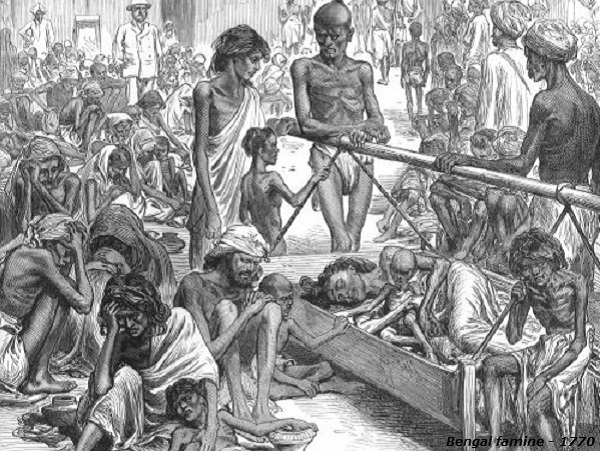
Bengal famine killed millions of people and nearly one-third of Bengal’s population fell victim to its ravages. Though the famine was due to failure of rains, but its effects were heightened by the Company’s policies.
Modern Indian History - Mysore Conquest
For British, Haidar Ali was one of the biggest problems in south India; without defeating Haidar Ali, it was not possible for the British to control the southern states.
Haidar Ali
In 1766, British entered into an alliance with the Nizam of Hyderabad to protect him from Haidar Ali (of Mysore) in return for the secession of the Northern Sarkars.
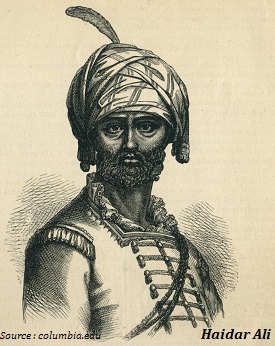
Haidar Ali was more than a match for the Company's armies. Having beaten back the British attack, he threatened Madras in 1769 and forced the Madras Council to sign a peace on his terms. Both sides restored each other's conquests and promised mutual help in case of attack by a third party.
In 1771, when Haidar Ali was attacked by the Marathas, the English went back on their promise and did not come to his help. This led Haidar Ali to distrust and dislike them.
In 1775, the English clashed with the Marathas, which lasted in 1782.
In the English and Maratha war, all the Maratha chiefs were united behind the Peshwa and their chief minister, Nana Phadnavis.
The Southern Indian powers had long been resenting the presence of the British among them, and Haidar Ali and the Nizam chose this moment to declare war against the British Company.
The British in India were, however, led at this time by their brilliant, energetic, and experienced Governor-General, Warren Hastings.
Acting with firm determination, he retrieved the vanishing British power and prestige.
The English had found in the Marathas a determined enemy, with immense resources. Mahadji Sindhia had given evidence of his power which the English dreaded to contest.
The Anglo-Maratha War had come to a standout. With the intercession of Mahadji, peace was concluded in 1782 by the Treaty of Salbai by which the status quo was maintained.
This war, known in history as the First Anglo-Maratha War, did not end in victory for either side. But it did give the British 20 years of peace with the Marathas, the strongest Indian power of the day.
The British utilized the period of 20 years to consolidate their rule over the Bengal Presidency, while the Maratha chiefs frittered away their energy in bitter mutual squabbles.
The Treaty of Salbai enabled the British to exert pressure on Mysore as the Marathas promised to help them in recovering their territories from Haidar Ali.
In July 1781, the British army under Eyre Coote defeated Haidar Ali at Porte Novo and saved Madras.
Tipu Sultan
After Haidar Ali’s death in December 1782, the war was carried on by his son, Tipu Sultan. Since neither side was capable of overpowering the other, peace was signed by them in March 1784 and both sides restored all conquests.
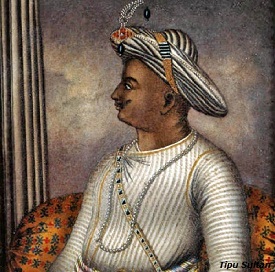
The peace of 1784 had not removed the grounds for struggle between Tipu and the British; it had merely postponed the struggle.
The authorities of the East India Company were acutely hostile to Tipu. They looked upon him as their most formidable rival in the South and as the chief obstacle standing between them and complete domination over South India.
Tipu, on his part, thoroughly disliked the English, saw them as the chief danger to his own independence, and nursed the ambition to expel them from India.
Even though Tipu fought with exemplary bravery, Lord Cornwallis, the then Governor-General, had succeeded through shrewd diplomacy in isolating him by winning over the Marathas, the Nizam, and the rulers of Travancore and Coorg.
This war again revealed that the Indian powers were shortsighted enough to aid the foreigner against another Indian power for the sake of temporary advantages.
By the Treaty of Seringapatam (1792), Tipu ceded half of his territories to the allies and paid 330 lakhs of rupees as indemnity.
The Third Anglo-Mysore war destroyed Tipu's dominant position in the South and firmly established British supremacy there.
Lord Wellesley (1798-1805)
Lord Wellesley (as Governor General) came to India in 1798 at a time when the British were locked in a life and death struggle with France all over the world.
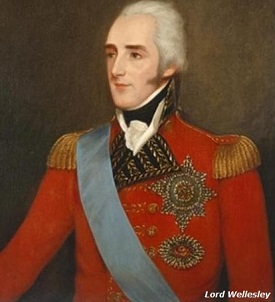
Lord Wellesley decided that the time was ripe for bringing as many Indian states as possible under British control.
By 1797, the two strongest Indian powers, Mysore and the Marathas, had declined in power.
The Third Anglo-Mysore war had reduced Mysore to a mere shadow of its recent greatness and the Marathas were dissipating their strength in mutual intrigues and wars.
Political conditions in India were propitious for a policy of (British) expansion: aggression was easy as well as profitable.
Administrative Plans of Wellesley
To achieve his political aims, Wellesley relied on three methods i.e.
The system of Subsidiary Alliances;
Outright wars; and
Assumptions of the territories of previously subordinated rulers.
The doctrine of subsidiary alliance was introduced by Lord Wellesley.
Under the subsidiary alliance system, the ruler of the allying Indian State was compelled to accept the permanent stationing of a British force within his territory and to pay a subsidy for its maintenance.
Subsidiary Alliance
In reality, by signing a Subsidiary Alliance, an India state virtually signed away−
Its independence;
The right of self-defense;
Maintaining the diplomatic relations;
Employing foreign experts; and
Settling its disputes with its neighbors.
As a consequence of Subsidiary Alliance, lakhs of soldiers and officers were deprived of their hereditary livelihood, spreading misery and degradation in the country.
Many of the unemployed soldiers joined the roaming bands of Pindarees which were to ravage the whole of India during the first two decades of the 19th century.
The Subsidiary Alliance system was, on the other hand, extremely advantageous to the British. They could now maintain a large army at the cost of the Indian states.
Lord Wellesley signed his first Subsidiary Treaty with the Nizam of Hyderabad in 1798.
The Nizam was to dismiss his French-trained troops and to maintain a subsidiary force of six battalions at a cost of £ 241,710 per year. In return, the British guaranteed his state against Maratha encroachments.
In 1800, the subsidiary force was increased and, in lieu of cash payment, the Nizam ceded part of his territories to the Company.
The Nawab of Avadh was forced to sign a Subsidiary Treaty in 1801. In return for a larger subsidiary force, the Nawab was forced to surrender to the British nearly half of his kingdom consisting of Rohilkhand and the territory lying between the Rivers Ganga and the Yamuna.
Wellesley dealt with Mysore, Carnatic, Tanjore, and Surat even more sternly.
Tipu of Mysore would, of course, never agreed to a Subsidiary Treaty. On the contrary, he had never reconciled himself to the loss of half of his territory in 1791. He worked incessantly to strengthen his forces for the inevitable struggle with the British.
Tipu Sultan entered into negotiations for an alliance with Revolutionary France. He sent missions 'to Afghanistan, Arabia, and Turkey to forge an anti-British alliance.
Lord Wellesley was no less determined to bring Tipu to heel and to prevent any possibility of the French re-entering India.
The British army attacked and defeated Tipu in a brief but fierce war in 1799, before French help could reach him.
Tipu still refused to beg for peace on humiliating terms. He proudly declared that it was "better to die like a soldier, than to live a miserable dependent on the infidels, in the list of their pensioned, rajas and Nawabs."
Tipu met a hero's end on 4 May 1799 while defending his capital Seringapatam. His army remained loyal to him to the very end.
Nearly half of Tipu's dominions were divided between the British and their ally, the Nizam. The reduced kingdom of Mysore was restored to the descendants of the original rajas from whom Haidar Ali had seized power.
A special treaty of Subsidiary Alliance was imposed on the new Raja by which the Governor-General was authorized to take over the administration of the state in case of necessity.
An important result of the Fourth Anglo-Mysore War was the complete elimination of the French threat to British supremacy in India.
In 1801, Lord Wellesley forced a new treaty upon the puppet Nawab of Carnatic compelling him to cede his kingdom to the Company in return for a handsome pension.
The Madras Presidency as it existed till 1947 was created, by attaching the Carnatic to territories seized from Mysore and Malabar.
The territories of the rulers of Tanjore and Surat were taken over and their rulers pensioned off.
The Marathas were the only major Indian power left outside the sphere of British control. Wellesley now turned his attention towards them and began aggressive interference in their internal affairs.
Chiefs of Maratha Empire
The Maratha Empire (during the Wellesley time) consisted of a confederacy of five big chiefs, namely −
The Peshwa at Poona;
The Gaekwad at Baroda;
The Sindhia at Gwalior;
The Holkar at Indore; and
The Bhonsle at Nagpur.
The Peshwa was the nominal head of the confederacy.
Unfortunately, the Marathas lost nearly all of their wise and experienced leaders towards the close of the 18th century.
Mahadji Sindhia, Tukoji Holker, Ahilya Bai Holker, Peshwa Madhav Rao II, and Nana Phadnavis, the people who had kept the Maratha confederacy together for the last 30 years, all were dead by the year 1800.
What was worse, the Maratha chiefs were engaged in bitter fratricidal strife, blind to the real danger from the rapidly advancing foreigners.
Wellesley had repeatedly offered a subsidiary alliance to the Peshwa and Sindhia. But the far-sighted Nana Phadnavis had refused to fall into the trap.
On 25 October 1802, the day of the great festival of Diwali, Holkar defeated the combined armies of' the Peshwa and Sindhia, the cowardly Peshwa Baji Rao II rushed into the arms of the English and on the fateful last day of 1802 signed the Subsidiary Treaty at Bassein.
The following map shows the acquired British territories in 1765 and 1805.
Modern Indian History - Lord Hastings
Marquess of Hastings (Lord Hastings) was appointed Governor-General of India on November 11, 1812. His tenure in India as Governor-General was a notable one, as he won two wars namely the Gurkha War (1814–1816) and the Maratha War (1818).
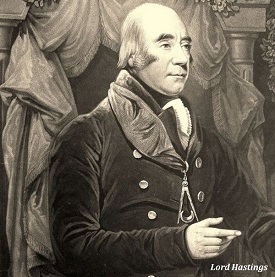
The Second Anglo-Maratha War had shattered the power of the Maratha chiefs but not their spirit. The loss of their freedom rankled in their hearts. They made a desperate last attempt to regain their independence and old prestige in 1817.
The lead in organizing a united front of the Maratha chiefs was taken by the Peshwa who was smarting under the rigid control exercised by the British Resident. However, once again the Marathas failed to evolve a conceded and well-thought out plan of action.
The Peshwa attacked the British Residency at Poona in November 1817. Madhoji II Bhonsle (also known as Appa Sahib) of Nagpur attacked the Residency at Nagpur, and Madhav Rao Holkar made preparations for war.
The Governor-General, Lord Hastings, struck back with characteristic vigor.
Hastings compelled Sindhia to accept British suzerainty, and defeated the armies of the Peshwa, Bhonsle, and Holkar.
The Peshwa was dethroned and pensioned off at Bithur near Kanpur. His territories were annexed and the enlarged Presidency of Bombay brought into existence.
Holkar and Bhonsle accepted subsidiary forces. All the Maratha chiefs had to cede to the Company large tracts of their territories.
To satisfy Maratha pride, the small Kingdom of Satara was founded out of the Peshwa's lands and gave to the descendant of Chhatrapati Shivaji who ruled it as a complete dependent of the British.
Like other rulers of Indian states, the Maratha chiefs too existed from now on at the mercy of the British power.
The Rajputana states had been dominated for several decades by Sindhia and Holkar. After the downfall of the Marathas, they lacked the energy to reassert their independence and readily accepted British supremacy.
By 1818, the entire Indian sub-continent excepting the Punjab and Sindh had been brought under British control.
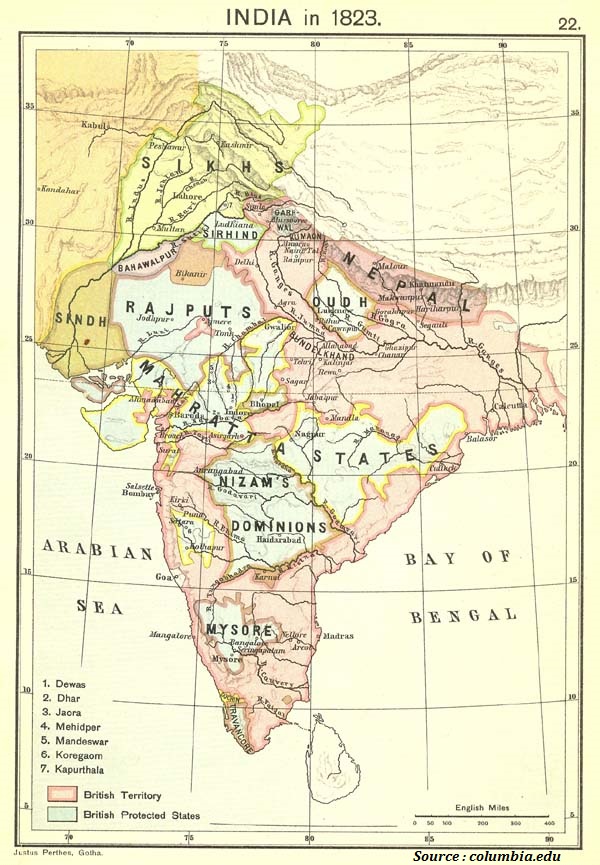
Some part of India was ruled directly by the British and the rest by a host of Indian rulers over whom the British exercised paramount power (as shown in the map given above).
The British protected states had virtually no armed forces of their own, nor did they have any independent foreign relations. However, they were autonomous in their internal affairs, but even in this respect, they acknowledged British authority wielded through a Resident.
The British protected states paid heavily for the British forces stationed in their territories to control them.
Consolidation of British Power
To consolidate its power, the British completed the task of conquering the whole of India from 1818 to 1857.
Conquest of Sindh
The conquest of Sindh occurred as a result of the growing Anglo-Russian rivalry in Europe and Asia and the consequent British fears that Russia might attack India through Afghanistan or Persia.
To counter Russia, the British Government decided to increase its influence in Afghanistan and Persia. It further felt that this policy could be success, fully pursued only if Sindh was brought trader British control. The commercial possibilities of the river Sindh were an additional attraction.
The roads and rivers of Sindh were opened to British trade by a treaty in 1832.
The chiefs of Sindh, known as Amirs were forced to sign a Subsidiary Treaty in 1839. And finally, in spite of previous assurances that its territorial integrity would be respected, Sindh was annexed in 1843 after a brief campaign by Sir Charles Napier.
Conquest of Punjab
The death of Maharaja Ranjit Singh in June 1839 was followed by political instability and rapid changes of government in the Punjab. Selfish and corrupt leaders came to the front. Ultimately, power fell into the hands of the brave and patriotic but utterly indiscipline army.
The political instability in Punjab led the British to look greedily across the Sutlej upon the land of the five rivers even though they had signed a treaty of perpetual friendship with Ranjit Singh in 1809.
The British officials increasingly talked of having to wage a campaign in the Punjab.
The Punjab army let itself be provoked by the warlike actions of the British and their intrigues with the corrupt chiefs of the Punjab.
In November 1844, Major Broadfoot, who was known to be hostile to the Sikhs, was appointed the British agent in Ludhiana.
Broadfoot repeatedly indulged in hostile actions and gave provocations. The corrupt chiefs and officials found that the army would sooner or later deprive them of their power, position, and possessions. Therefore, they conceived the idea of saving themselves by embroiling the army in a war with the British.
In the autumn of 1845, news reached that boats designed to form bridges had been dispatched from Bombay to Ferozepur on the Sutlej.
The Punjab Army, now convinced that the British were determined to occupy the Punjab, took counter measures.
When it heard in December that Lord Gough, the Commander-in-Chief, and Lord Harding, the Governor-General, were marching towards Ferozepur, the Punjab army decided to strike.
The war between the two was thus declared on 13 December 1845. The danger from the foreigner immediately united the Hindus, the Muslims, and the Sikhs.
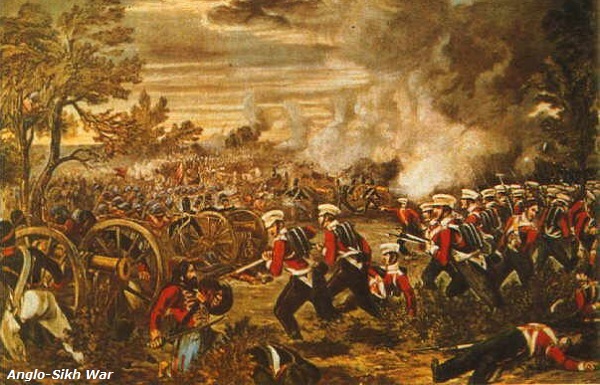
The Punjab army fought heroically and with exemplary courage. But some of its leaders had already turned traitors. The Prime Minister, Raja Lal Singh, and the Commander-in-Chief, Misar Tej Singh, were secretly corresponding with the enemy.
The Punjab Army was forced to concede defeat and to sign the humiliating Treaty of Lahore on 8 March 1846.
The British annexed the Jalandhar Doab and handed over Jammu and Kashmir to Raja Gulab Singh Dogra for a cash payment of five million rupees.
The Punjab army was reduced to 20,000 infantry and 12,000 cavalries and a strong British force was stationed at Lahore.
Later, on 16 December 1846, another treaty was signed giving the British Resident at Lahore full authority on over all matters in every department of the state. Moreover, the British were permitted to station their troops in any part of the state.
In 1848, freedom loving Punjabis rose up in through numerous local revolts. Two of the prominent revolts were led by Mulraj at Multan and Chattar Singh Attariwala near Lahore.
The Punjabis were once again decisively defeated. Lord Dalhousie seized this opportunity to annex the Punjab. Thus, the last independent state of India was absorbed in the British Empire of India.
Lord Dalhousie (1848-1856)
Lord Dalhousie came to India as the Governor-General in 1848. He was from the beginning determined to extend direct British rule over as large area as possible.
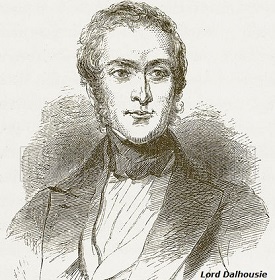
Dalhousie had declared that "the extinction of all native states of India is just a question of time". The ostensible reason for this policy was his belief that British administration was far superior to the corrupt and oppressive administration of the native rulers.
The underlying motive of Dalhousie’s policy was the expansion of British exports to India.
Dalhousie, in common with other aggressive imperialists, believed that British exports to the native states of India were suffering because of the maladministration of these states by their Indian rulers.
Doctrine of Lapse
The chief instrument through which Lord Dalhousie implemented his policy of annexation was the ‘Doctrine of Lapse.’
Under the Doctrine of Lapse, when the ruler of a protected state died without a natural heir, his/her state was not to pass to an adopted heir as sanctioned by the age-old tradition of the country. Instead, it was to be annexed to the British dominions unless the adoption had been clearly approved earlier by the British authorities.
Many states, including Satara in 1848 and Nagpur and Jhansi in 1854, were annexed by applying this doctrine.
Dalhousie also refused to recognize the titles of many ex-rulers or to pay their pensions. Thus, the titles of the Nawabs of Carnatic and of Surat and the Raja of Tanjore were extinguished.
After the death of the ex-Peshwa Baji Rao II, who had been made the Raja of Bithur, Dalhousie refused to extend his pay or pension to his adopted son, Nana Saheb.
Lord Dalhousie was keen on annexing the kingdom of Avadh. But the task presented certain difficulties. For one, the Nawabs of Avadh had been British allies since the Battle of Buxer. Moreover, they had been most obedient to the British over the years.
The Nawab of Avadh had many heirs and could not therefore be covered by the Doctrine of Lapse. Some other pretext had to be found for depriving him of his dominions.
Lord Dalhousie hit upon the idea of alleviating the plight of the people of Avadh. Nawab Wajid Ali Shah was accused of having misgoverned his state and of refusing to introduce reforms. His state was therefore annexed in 1856.
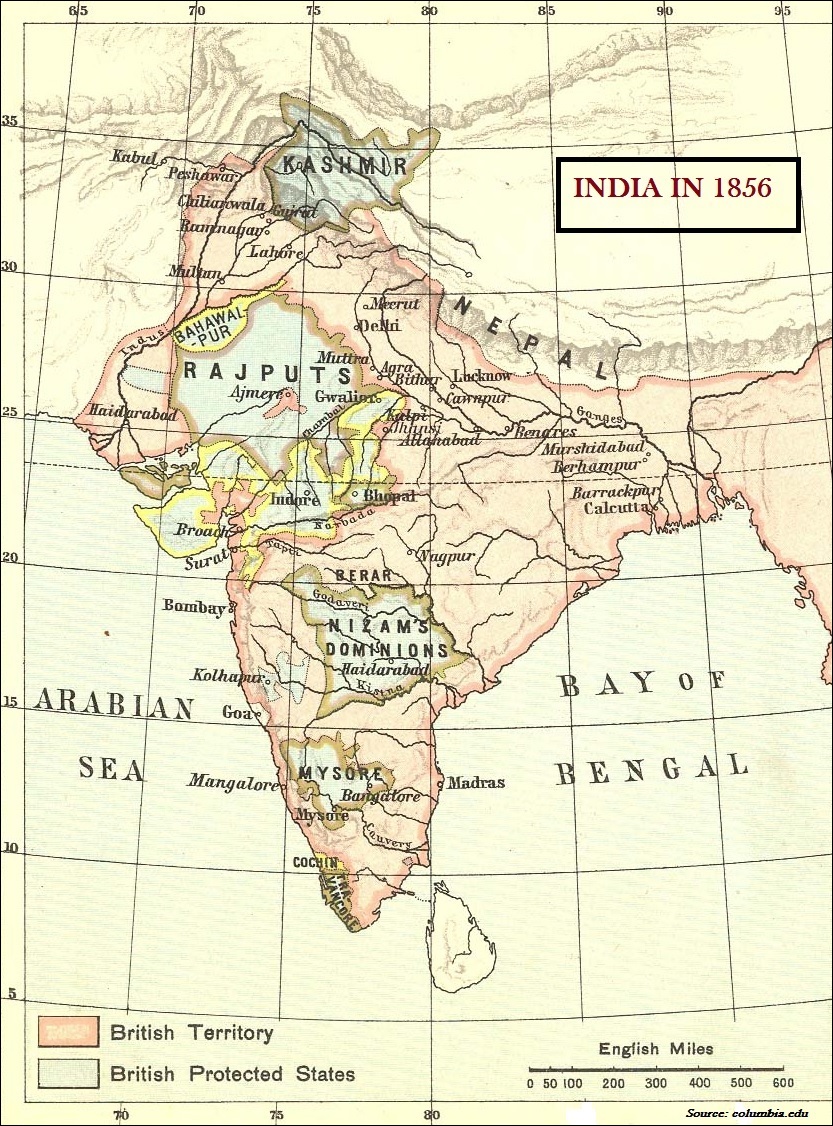
Undoubtedly, the degeneration of the administration of Avadh was a painful reality for its people.
The Nawabs of Avadh, like other princes of the day, were selfish rulers absorbed in self-indulgence who cared little for good administration for the welfare of the people. However, the responsibility for this state of affairs was in part that of the British who had at least since, 1801 controlled and indirectly governed Avadh.
In reality, it was the immense potential of Avadh as a market for Manchester goods which excited Dalhousie’s greed and aroused his ‘philanthropic’ feelings.
For similar reasons, to satisfy Britain’s growing demand for raw cotton, Dalhousie took away the cotton-producing province of Berar from the Nizam in 1853.
The above map shows the British territory in 1856
British Administrative Policy
The administrative policy of the Company underwent frequent changes during the long period between 1751 and 1857. However, it never lost sight of its main objects which were −
To increase the Company's profits;
To enhance the profitability of its Indian possessions to Britain; and
To maintain and strengthen the British hold over India.
The administrative machinery of the Government of India was designed and developed to serve these ends. The main emphasis in this respect was placed on the maintenance of law and order so that trade with India and exploitation of its resources could be carried out without disturbance.
The Structure of the Government
From 1765 to 1772, in the period of the Dual Government, Indian officials were allowed to function as before but under the over-all control of the British Governor and British officials.
The Indian officials had responsibility but no power while the Company's officials had power but no responsibility. Both sets of officials were venal and corrupt men.
In 1772, the Company ended the Dual Government and undertook to administer Bengal directly through its own servants. But the evils inherent in the administration of a country by a purely commercial company soon came to the surface.
The East India Company was at this time a commercial body designed to trade with the East. Moreover, its higher authority was situated in England, many thousands of miles away from India.
The parliamentary politics of Britain during the latter half of the 18th century were corrupt in the extreme.
The Company, as well as its retired officials bought seats in the House of Commons for their agents.
Many English statesmen were worried that the Company and its officials, backed by Indian plunder, might gain a preponderant influence in the Government of Britain. The Company and its vast empire in India had to be controlled or the Company as master of India would soon come to control British administration and be in a position to destroy the liberties of the British people.
The exclusive privileges of the Company were also attacked by the rising school of economists representing free-trade manufacturing capitalism. In his celebrated work, “The Wealth of Nations.”
Adam Smith, the founder of Classical economics, condemned the exclusive companies; “Such exclusive companies, therefore, are nuisances in many respect; always more or less inconvenient to the countries in which they are established and destructive to those which have the misfortune to fall under their government.”
The Regulating Act of 1773
The first important parliamentary act regarding the Company's affairs was the Regulating Act of 1773.
Act of 1773 made changes in the constitution of the Court of Directors of the Company and subjected their actions to the supervision of the British Government.
The Directors were to lay before the Ministry all correspondence dealing with the civil and military affairs and the revenues of India.
In India, the Government of Bengal was to be carried on by a Governor-General and his Council who were given the power to superintend and control the Bombay and Madras Presidencies in matters of war and peace.
The Act also provided for the establishment of a Supreme Court of Justice at Calcutta to administer justice to Europeans, their employees, and the citizens of Calcutta.
The Regulating Act soon broke down in practice. It had not given the British Government effective and decisive control over the Company.
In India, the Act had paced the Governor-General at the mercy of his Council. Three of the Councilors could combine and outvote the Governor-General on any matter.
In practice, Warren Hastings, the first Governor-General under the Act, and three of his Councilors quarreled incessantly, often creating deadlocks in the administration.
The Act perceptively had failed to resolve the conflict between the Company and its opponents in England who were daily growing stronger and more vocal. Moreover, the Company remained extremely vulnerable to the attacks of its enemies as the administration of its Indian possessions continued to be corrupt, oppressive, and economically disastrous.
Pitt’s India Act
The defects of the Regulating Act and the exigencies of British politics necessitated the passing in 1784 of another important act known as Pitt's India Act.
Pitt’s Act gave the British Government supreme control over the Company's affairs and its administration in India. It established six Commissioners for the affairs of India, popularly known as the Board of Control, including two Cabinet Ministers.
The Board of Control was to guide and control the work of the Court of Directors and the Government of India. In important and urgent matters it had the power to send direct orders to India through a secret committee of Directors.
The Pitt’s Act placed the Government of India in the hands of the Governor-General and a Council of three, so that if the Governor-General could get the support of even one member, he could have his way.
The Act clearly subordinated the Bombay and Madras Presidencies to Bengal in all questions of war, diplomacy, and revenues.
With the Pitt’s Act, a new phase of the British conquest began in India. While the East India Company became the instrument of British national policy, India was to be made to serve the interests of all sections of the ruling classes of Britain.
The Company having saved its monopoly of the Indian and Chinese trade was satisfied. Its Directors retained the profitable right of appointing and dismissing its British officials in India. Moreover, the Government of India was to be carried out through their agency.
While Pitt's India Act laid down the general framework in which the Government of India was to be carried on till 1857, later enactments brought about several important changes which gradually diminished the powers and privileges of the Company.
In 1786, the Governor-General was given the authority to overrule his Council in matters of importance affecting safety, peace, or the interests of the Empire in India.
Charter Act of 1813
By the Charter Act of 1813, the trade monopoly of the Company in India was ended and trade with India was thrown open to all British subjects. But the trade of tea and trade with China were still exclusive to the Company.
According to the Charter Act, the Government and the revenues of India continued to be in the hands of the Company. The Company also continued to appoint its officials in India.
Charter Act of 1833
The Charter Act of 1833 brought the Company's monopoly of tea trade and trade with China to an end. At the same time, the debts of the Company were taken over by the Government of India, which was also to pay its shareholders a 10.5 per cent dividend on their capital.
The Government of India continued to be run by the Company under the strict control of the Board of Control.
Supreme authority in India was, therefore, delegated to the Governor-General in Council. The Governor-General, having the authority to overrule his Council in important questions, became in fact the real, effective ruler of India, functioning under the superintendence, control, and direction of the British Government.
As per the Act of 1833, Indians were allowed ‘no share’ in their own administration.
The three seats of authority, as far as India was concerned, were −
The Court of Directors of the Company;
The Board of Control representing the British Government; and
The Governor-General.
With none of these three seats, any Indian was associated even remotely or in any capacity.
The British created a new system of administration in India to serve their purposes.
The chief aim of the British was to enable them to exploit India economically to the maximum advantage of various British interests, ranging from the Company to the Lancashire manufacturers.
At the same time, India was to be made to bear the full cost of its own conquest as well as of the foreign rule. An examination of the economic policies of the British in India is, therefore, of prime importance.
British Economic Policies
From 1600 to 1757, the East India Company’s role in India, was that of a trading corporation, which brought goods or precious metals into India and exchanged them for Indian goods like textiles, spices, etc., which it sold abroad.
British’s profits came primarily from the sale of Indian goods abroad. It tried constantly to open new markets for Indian goods in Britain and other countries. Thereby, it increased the export of Indian manufactures and thus encouraged their production. This is the reason why the Indian rulers tolerated and even encouraged the establishment of the Company's factories in India.
By 1720, laws had been passed forbidding the wear or use of printed or dyed cotton cloth in the UK.
Other European countries, except Holland, also either prohibited the import of Indian cloth or imposed heavy import duties. In spite of these laws, however, Indian silk and cotton textiles still held their importance in foreign markets, until the middle of the 18th century when the English textile industry began to develop on the basis of new and advance technology.
After the Battle of Plassey in 1757, the pattern of the Company's commercial relations with India underwent a qualitative change. Now the Company could use its political control over Bengal to push its Indian trade.
The Company used its political power to dictate terms to the weavers of Bengal who were forced to sell their products at a cheaper and dictated price, even at a loss. Moreover, their labor was no longer free. Many of them were compelled to work for the Company for low wages and were forbidden to work for Indian merchants.
The British Company eliminated its rival traders, both Indian and foreign, and prevented them from offering higher wages or pries to the Bengal handicraftsmen.
The servants of the Company monopolized the sale of raw cotton and made the Bengal weaver pay exorbitant prices for it. Thus, the weaver lost by both ways, as a buyer as well as a seller. On the contrary, Indian textiles had to pay heavy duties on catering England.
The Industrial Revolution (in Britain)
The real blow on Indian handicrafts fell after 1813 when they lost not only their foreign markets but, what was of much greater importance, their market in India itself.
Between the second half of the 18th century and the first few decades of the 19th century, Britain underwent profound social and economic transformation. British industry developed and expanded rapidly on the basis of modem machines, the factory system, and capitalism.
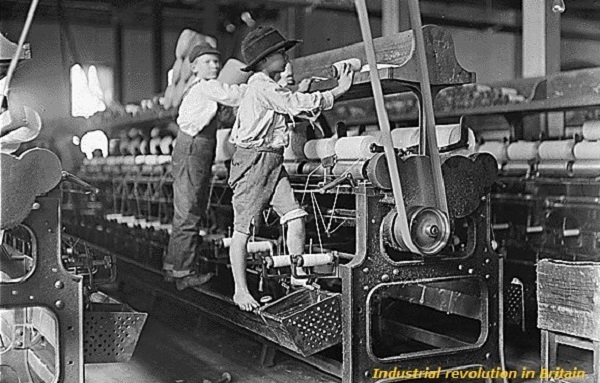
The Industrial Revolution transformed British society in a fundamental manner. It led to rapid economic development, which is the foundation of today's high standard of living in Britain as well as in Europe, the Soviet Union, the U.S.A., Canada, Australia, and Japan.
Britain became increasingly urbanized as a result of the Industrial Revolution. More and more men began to live in factory towns.
In 1750, Britain had only two cities with more than 50,000 inhabitants; in 1851, their number was 29.
Two entirely new classes of society were born i.e.
The industrial capitalists, who owned the factories, and
The workers who hired out as the labors on daily wages.
While the industrial capitalist class developed rapidly, enjoying unprecedented prosperity, the workers — the laboring poor in the beginning reaped a harvest of sorrow.
Instead of exporting manufactured goods, India was now forced to export raw materials like raw cotton and raw silk, which British industries needed urgently, or plantation products like indigo and tea, or food grains, which were in short supply in Britain.
The British also promoted the sale of Indian opium in China even though the Chinese put a ban on it because of its poisonous and other harmful qualities. But the trade yielded large profits to British merchants and fat revenues to the Company-cannoned administration of India.
Interestingly enough, the import of opium into Britain was strictly banned. Thus, the commercial policy of the East India Company after 1913 was guided by the needs of British industry. Its main aim was to transform India into a consumer of British manufactures and a supplier of raw materials.
The Drain of Wealth
The British exported to Britain part of India's wealth and resources for which India got no adequate economic or material return.
This 'Economic Drain' was peculiar to British rule. Even the worst of previous Indian governments had spent the revenue they extracted from the people inside the country.
The British, consequently, spent a large part of the taxes and income they derived from Indian people not in India, but in their home country.
The drain of wealth from Bengal began in 1757 when the Company's servants began to carry home immense fortunes extorted from Indian rulers, zamindars, merchants, and from other common people.
They sent home nearly £ 6 million between 1758 and 1765. This amount was more than four times the total land revenue collection of the Nawab of Bengal in 1765.
In 1765, the Company acquired the dewani of Bengal and thus gained control over its revenues.
The Company, even more than its servants, soon directly organized the drain. It began to purchase Indian goods out of the revenue of Bengal and to export them. These purchases were known as 'investments' Thus, through 'Investments', Bengal's revenue was sent to England.
Transport & Communication
Up to the middle of the 19th century, the means of transport in India were backward. They were confined to bullock-cart, camel, and packhorse.
The British rulers soon realized that a cheap and easy system of transport was a necessity if British manufactures were to flow into India on a large scale and her raw materials secured for British industries.
The British rulers introduced steamships on the rivers and set about improving the roads.
Work on the Grand Trunk Road from Calcutta to Delhi began in 1839 and completed in the 1850's. Efforts were also made to link by road the major cities, ports, and markets of the country.
Development of Railway
The first railway engine designed by George Stephenson was put on the rail in England in 1814. Railways developed rapidly during the 1830s and 1840s.
The earliest suggestion to build a railway in India was made in Madras in 1831. But the wagons of this railway were to be drawn by horses.
Construction of steam-driven railways in India was first proposed in 1834 in England. It was given strong political support by England's railway promoters, financiers, and mercantile houses trading with India, and textile manufacturers.
It was decided that the Indian railways were to be constructed and operated by private companies who were guaranteed a minimum of five per cent return on their capital by the Government of India.
The first railway line running from Bombay to Thane was opened to traffic in 1853.
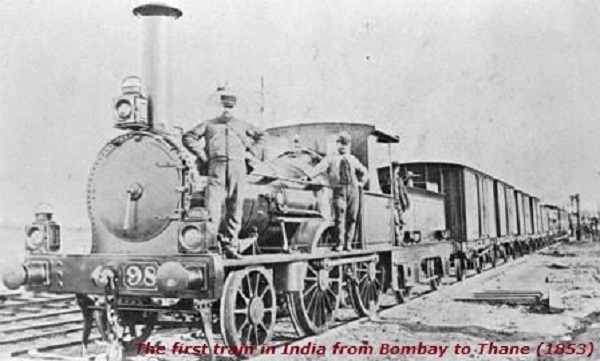
Lord Dalhousie, who became Governor-General of India in 1849, was an ardent advocate of rapid railway construction.
Dalhousie proposed a network of four main trunk lines which would link the interior of the country with the big ports and inter-connect the different parts of the country.
By the end of 1869, more than 4,000 miles of railways had been built by the guaranteed companies; but this system proved very costly and slow, and so in 1869 the Government of India decided to build new railways as state enterprises. But the speed of railway extension still did not satisfy officials in India and businessmen in Britain.
After 1880, railways were built through private enterprises as well as state agency.
By 1905, nearly 28,000 miles of railways had been built. The railway lines were laid primarily with a view to link India's raw material producing areas in the interior with the ports of export.
The needs of Indian industries regarding their markets and their sources of raw materials were neglected. Moreover, the railway rates were fixed in a manner so as to favor imports and exports and to discriminate against internal movement of goods.
Several railway lines in Burma and North-Western India were built at high cost to serve British imperial interests.
Postal and Telegraph System
The British also established an efficient and modern postal system and introduced the telegraph.
The first telegraph line from Calcutta to Agra was opened in 1853.
Lord Dalhousie introduced postage stamps. Previously cash payment had to be made when a letter was posted. He also cut down postal rates and charged a uniform rates.
Modern Indian History - Land Revenue Policy
The Indian peasants had been forced to bear, the main burden of providing money for the trade and profits of the Company, the cost of administration, and the wars of British expansion in India. In fact, the British could not have conquered such a vast country as India if they had not taxed him heavily.
The Indian state had since times immemorial taken a part of the agriculture produce as land revenue. It had been done so either directly through its servants or indirectly through intermediaries, such as zamindars, revenue-farmers, etc., who collected the land revenue from the cultivator and kept a part of it as their commission.
The intermediaries were primarily collectors of land revenue, although they did sometimes own some land in the area from which they collected revenue.
The Land Revenue Policy in India can studied into three following heads −
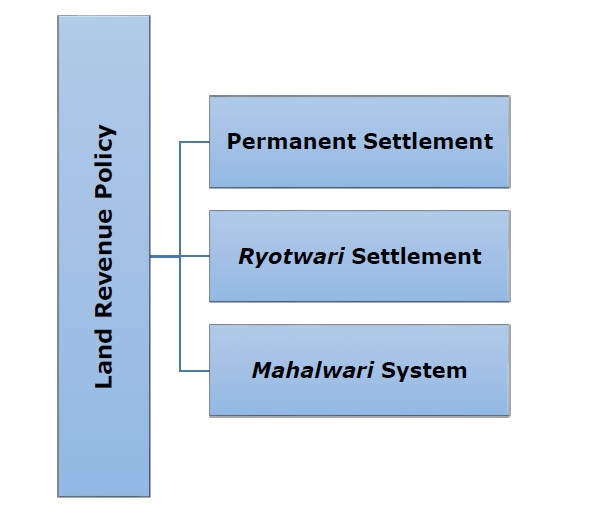
The Permanent Settlement
In 1773, the British Company decided to manage the land revenues directly.
Warren Hastings auctioned the right to collect revenue to the highest bidders. But his experiment did not succeed.
The amount of land revenue was pushed high by zamindars and other Speculators bidding against each other; however, the actual collection varied from year to year and seldom came up to official expectations. This introduced instability in the Company's revenues at a time when the Company was hard pressed for money.
Neither the ryot nor the zamindar would do anything to improve cultivation when they did not know what the next year's assessment would be or who would be the next year's revenue collector.
The idea of fixing the land revenue at a permanent amount was introduced. Finally, after prolonged discussion and debate, the Permanent Settlement was introduced in Bengal and Bihar in 1793 by Lord Cornwallis.
Permanent Settlement had some special features i.e.
The reminders and revenue collectors were converted into so many landlords. They were not only to act as agents of the Government in collecting land revenue from the ryot, but also to become the owners of the entire land (over which they were collecting revenue). Their right of ownership was made hereditary and transferable.
On the other hand, the cultivators were reduced to the low status of mere tenants and were deprived of long-standing rights to the soil and other customary rights.
The use of the pasture and forest lands, irrigation canals, fisheries, and homestead plots and protection against enhancement of rent were some of the cultivators’ rights which were sacrificed.
In fact the tenancy of Bengal was left entirely at the mercy of the zamindars. This was done so that the zamindars might be able to pay in time the exorbitant land revenue demand of the Company.
The zamindars were to give 10/11th of the rental they derived from the peasantry to the state, keeping only 1/11th for themselves. But the sums to be paid by them as land revenue were fixed in perpetuity.
At the same time, the zamindar had to pay his revenue rigidly on the due date even if the crop had failed for some reason; otherwise his lands were to be sold.
John Shore, the man who planned the Permanent Settlement and later succeeded Cornwallis as Governor-General, calculated that if the gross produce of Bengal be taken as 100, the Government claimed 45, zamindars and other intermediaries below them received 15, and only 40 remained with the actual cultivator.
Before 1793, the Company was troubled by fluctuations in its chief source of income, i.e. the land revenue. The Permanent Settlement guaranteed the stability of income.
The Permanent Settlement enabled the Company to maximize its income as land revenue was now fixed higher than it had ever been in the past.
Collection of revenue through a small number of zamindars seemed to be much simpler and cheaper than the process of dealing with lakhs of cultivators.
The Permanent Settlement was expected to increase agricultural production.
Since the land revenue would not be increased in future even if the zamindar's income went up, the latter would be inspired to extend cultivation and improve agricultural productivity.
Benefits of Permanent Settlement
Ryotwari Settlement
The establishment of British rule in South and South-Western India brought new problems of land settlement. The officials believed that in these regions there were no zamindars with large estates with whom settlement of land revenue could be made and that the introduction of zamindari system would upset the existing state of affairs.
Many Madras officials led by Reed and Munro recommended that settlement should therefore be made directly with the actual cultivators.
The system they proposed, is known as the Ryotwari Settlement, under which the cultivator was to be recognized as the owner of his plot of land subject to the payment of land revenue.
The supporters of the Ryotwari Settlement claimed that it was a continuation of the state of affairs that had existed in the past.
Munro said: "It is the system which has always prevailed in India".
The Ryotwari Settlement was introduced in parts of the Madras and Bombay Presidencies in the beginning of the 19th century.
The settlement under the Ryotwari system was not made permanent. It was revised periodically after 20 to 30 years when the revenue demand was usually raised.
Mahalwari System
A modified version of the zamindari settlement, introduced in the Gangetic valley, the North-West Provinces, parts of Central India, and Punjab, was known as the Mahalwari System.
The revenue settlement was to be made village by village or estate (mahal) by estate with landlords or heads of families who collectively claimed to be the landlords of the village or the estate.
In Punjab, a modified Mahalwari System known as the village system was introduced. In Mahalwari areas also, the land revenue was periodically revised.
Both the Zamindari and the Ryotwari systems, departed fundamentally from the traditional land systems of the country.
The British created a new form of private property in land in such a way that the benefit of the innovation did not go to the cultivators.
All over the country, the land was now made salable, mortgagable, and alienable. This was done primarily to protect the Government's revenue.
If land had not been made transferable or salable, the Government would find it very difficult to realize revenue from a cultivator who had no savings or possessions out of which to pay it.
The British by making land a commodity which could be freely bought and sold introduced a fundamental change in the existing land systems of the country. The stability and the continuity of the Indian villages were shaken, in fact, the entire structure of the rural society began to break up.
Administrative Structure
In the beginning, the Company left the administration of its possessions in India in Indian hands, confining its activities to supervision. But soon found `that British aims were not adequately served by following old methods of administration. Consequently, the Company took all aspects of administration in its own hand.
Under Warren Hastings and Cornwallis, the administration of Bengal was completely overhauled and found a new system based on the English pattern.
The spread of British power to new areas, new problems, new needs, new experiences, and new ideas led to changes in the system of administration. But the overall objectives of imperialism were never forgotten.
Strength of British Administrative System
The British administration in India was based on three pillars −
The Civil Service,
The Army, and
The Police.
The chief aim of British-Indian administration was the maintenance of law and order and the perpetuation of British rule. Without law and order, British merchants and British manufacturers could not hope to sell their goods in every nook and corner of India.
The British, being foreigners, could not hope to win the affections of the Indian people; they, therefore, relied on superior force rather than on public support for the maintenance of their control over India.
Civil Service
The Civil Service was brought into existence by Lord Cornwallis.
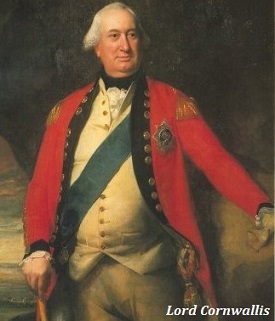
The East India Company had from the beginning carried on its trade in the East through servants who were paid low wages but who were permitted to trade privately.
Later, when the Company became a territorial power, the same servants assumed administrative functions. They now became extremely corrupt by −
Oppressing local weavers and artisans, merchants, and zamindars,
Extorting bribes and 'gifts' from rajas and nawabs, and
Indulging in illegal private trade. They amassed untold wealth with which they retired to England.
Clive and Warren Hastings made attempts to put an end to their corruption, but were only partially successful.
Cornwallis, who came to India as Governor-General in 1786, was determined to purify the administration, but he realized that the Company's servants would not give honest and efficient service so long as they were not given adequate salaries.
Cornwallis, therefore, enforced the rules against private trade and acceptance of presents and bribes by officials with strictness. At the same time, he raised the salaries of the Company's servants. For example, the Collector of a district was to be paid Rs 1,500 a month and one per cent commission on the revenue collection of his district.
Cornwallis also laid down that promotion in the Civil Service would be by seniority so that its members would remain independent of outside influence.
In 1800, Lord Wellesley pointed out that even though civil servants often ruled over vast areas, they came to India at the immature age of 18 or so and were given no regular training before starting on their jobs. They generally lacked knowledge of Indian languages.
Wellesley, therefore, established the College of Fort William at Calcutta for the education of young recruits to the Civil Service.
The Directors of the Company disapproved of his action and in 1806 replaced it by their own East Indian College at Haileybury in England.
Till 1853, all appointments to the Civil Service were made by the Directors of the East India Company who placated the members of the Board of Control by letting them make some of the nominations.
The Directors fought hard to retain this lucrative and prized privilege and refused to surrender it even when their other economic and political privileges were taken away by Parliament.
The Directors lost it finally in 1853 when the Charter Act decreed that all recruits to the Civil Service were to be selected through a competitive examination.
A special feature of the Indian Civil Service since the days of Cornwallis was the rigid and complete exclusion of Indians (from it).
It was laid down officially in 1793 that all the higher posts in administration worth more than £ 500 a year in salary were to be held by Englishmen. This policy was also applied to other branches of Government, such as the army, police, judiciary, and engineering.
The Indian Civil Service gradually developed as one of the most efficient and powerful civil services in the world.
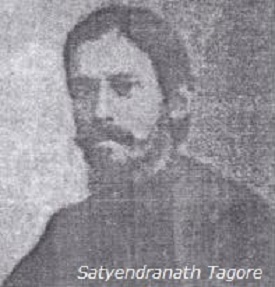
Its members exercised vast power and often participated in the making of policy. They developed certain traditions of independence, integrity, and hard work, though these qualities obviously served British and not Indian interests.
Satyendranath Tagore was the first Indian who passed the Indian Civil Service examination in 1863 and hold 4th Rank. He was an author, linguist, song composer. He made significant contribution towards the emancipation of women in Indian society during the British Rule.
Army
The army of the British regime in India was fulfilled three important functions −
It was the instrument through which the Indian powers were conquered;
It defended the British Empire in India from foreign rivals; and
It safeguarded British supremacy from the ever-present threat of internal revolt.
The bulk of the Company's army consisted of Indian soldiers, recruited chiefly from the area at present included in U.P. and Bihar.
For instance, in 1857, the strength of the army in India was 311,400 of whom 265,903 were Indians. Its officers were, however, exclusively British, at least since the days of Cornwallis.
In 1856, only three Indians in the army received a salary of Rs. 300 per month and the highest Indian officer was a subedar.
A large number of Indian troops had to be employed as the British troops were too expensive. Moreover, the population of Britain was perhaps too small to provide the large number of soldiers needed for the conquest of India.
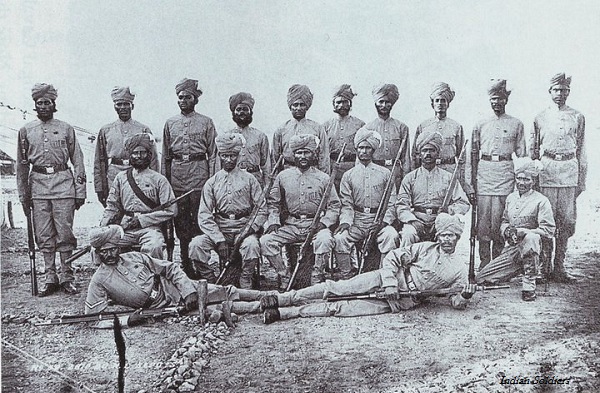
As a counterweight, the army was officered entirely by British officials and a certain number of British troops were maintained to keep the Indian soldiers under control.
Police
Cornwallis had created the police system, which was one of the most popular strengths for the British rule.
Cornwallis relieved the zamindars of their police functions and established a regular police force to maintain law and order.
Interestingly, this put India ahead of Britain where a system of police had not developed yet.
Cornwallis established a system of circles or thanas headed by a daroga, who was an Indian. Later, the post of the District Superintendent of Police was mated to head the police organization in a district.
Once again, Indians were excluded from all superior posts. In the villages the duties of the police continued to he performed by village-watchmen who were maintained by the villagers.
The police gradually succeeded in reducing major crimes such as dacoity.
One of its major achievements was the suppression of thugs who robbed and killed travelers on the highways, particularly in Central India.
The police also prevented the organization of a large-scale conspiracy against foreign control, and when the national movement arose, the police were used to suppress it.
Modern Indian History - Judicial Organization
The British laid the foundations of a new system of dispensing justice through a hierarchy of civil and criminal courts.
Though given a start by Warren Hastings, the system was stabilized by Cornwallis in 1793.
In each district was established a Diwani Adalat, or civil court, presided over by the District Judge who belonged to the Civil Service.
Cornwallis thus separated the posts of the Civil Judge and the Collector.
Appeal from the District Court lay first to four Provincial Courts of Civil Appeal and then, finally, to the Sadar Diwani Adalat.
Below the District Court were Registrars' Courts, headed by Europeans, and a number of subordinate courts headed by Indian judges known as Munsifs and Amins.
To deal with criminal cases, Cornwallis divided the Presidency of Bengal into four Divisions, in each of which a Court of Circuit presided over by the civil servants was established.
The civil courts applied the customary law that had prevailed in any area or among a section of the people since times immemorial.
In 1831, William Bentinck abolished the Provincial Courts of Appeal and Circuit. Their work was assigned first to Commissions and later to District Judges and District Collectors.
Bentinck also raised the status and powers of Indians in the judicial service and appointed them as Deputy Magistrates, Subordinate Judges, and Principal Sadar Amins.
In 1865, High Courts were established at Calcutta, Madras, and Bombay to replace the Sadar Courts of District and Nizamat.
The British also established a new system of laws through the processes of enactment and codification of old laws.
The traditional system of justice in India had been largely based on customary law which arose from the long tradition and practice.
Though many laws were based on the shastras and shariat as well as on imperial authority. However, the British gradually evolved a new system of laws.
British introduced regulations, codified the existing laws, and often systematized and modernized them through judicial interpretation.
The Charter Act of 1833 conferred all law making power on the GovernorGeneral-in-Council.
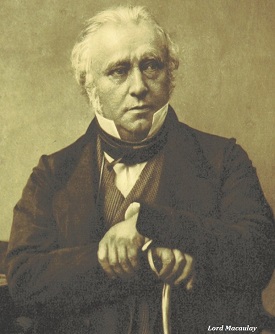
In 1833, the Government appointed a Law Commission headed by Lord Macaulay to codify Indian laws.
Macaulay’s work eventually resulted in the Indian Penal Code, the Westernderived Codes of Civil and Criminal Procedure and other codes of laws.
The same Laws now prevailed all over the country and they were enforced by a uniform system of courts.
The Rule of Law
The British introduced the modern concept of the ‘rule of law.’ This meant that their administration was to he carried out, at least in theory, in obedience to laws, which clearly defined the rights, privileges, and obligations of the subjects and not according to the caprice or personal discretion of the ruler.
In practice, of course, the bureaucracy and the police enjoyed arbitrary powers and interfered with the rights and liberties of the people.
The rule of law was to some extent a guarantee of the personal liberty of a person.
One important feature of the 'concept of the rule of law’ was that any official could be brought before a court of law for breaches of official duty or for acts done in excess of his official authority.
Equality Before Law
The Indian legal system under the British was based on the concept of equality before law. This meant that in the eyes of law ‘all men were equal.’
The same law applied to all persons irrespective of their age, religion, or class.
Previously, the judicial system had paid heed to caste distinctions and had differentiated between the so-called high-born and low-born.
For the same crime lighter punishment was awarded to a Brahmin than to a non-Brahmin. Similarly, in practice zamindars and nobles were not judged as harshly as the common people. In fact, very often they could not be brought to justice at all for their actions.
There was, however, one exception to this excellent principle of equality before law. The Europeans and their descendants had separate courts and even laws.
In criminal cases, Europeans could be tried only by European judges.
Many English officials, military officers, planters, and merchants behaved with Indians in a haughty, harsh, and even brutal manner. When efforts were made to bring them to justice, they were given indirect and undue protection and consequently light or no punishment by many of the European judges before whom alone they could be tried. Consequently, miscarriage of justice occurred (frequently).
In practice, another type of legal inequality emerged; justice became quite expensive as court fees had to be paid, lawyers engaged and the expenses of witnesses met. Courts were often situated in distant towns. Law suits dragged on for years.
The complicated laws were beyond the grasp of the illiterate and ignorant peasants.
Invariably, the rich could turn and twist the laws and courts to operate in their own favor. The mere threat to take a poor person through the long process of justice from the lower court to the highest court of appeal and thus to face harm with complete ruin often sufficed to bring him to heel.
The widespread prevalence of corruption in the ranks of the police and the rest of the administrative machinery led to the denial of justice. Officials often favored the rich.
In contrast, the system of justice that had prevailed pre-British times, was comparatively informal, speedy, and inexpensive.
Social and cultural Policy
Till 1813, the British also followed a policy of non-interference in the religious, social, and cultural life of the country, but after 1813, they took active steps to transform Indian society and culture.
Science and technology also opened new vistas of human progress.
The 18th and 19th centuries witnessed a great ferment of new ideas in Britain and Europe, which influenced the British outlook towards the Indian problems.
Modernization of India was accepted by many English officials, businessmen, and statesmen because it was expected to make Indians better customers of British goods and reconcile them to the alien rule.
The basic dilemma before the British administrators in India was that while British interests in India could not be served without some modernization, full modernization would generate forces, which would go against their interests and would, in the long run, endanger British supremacy in the country.
They had, therefore, to follow a delicately balanced policy of partial modernization that is a policy of introducing modernization in some respects and blocking and preventing it in other respects.
The policy of modernizing Indian society and culture was also encouraged by the Christian missionaries and religious-minded persons such as William Wilberforce and Charles Grant, the Chairman of the Court of Directors of the east India Company, who wanted to spread Christianity in India.
Christian missionaries supported a program of Westernization in the hope that it would eventually lead to the country’s conversion to Christianity. They, therefore, opened modern schools, colleges, and hospitals in the country.
As a matter of fact, the policy of modernization was gradually abandoned after 1858 as Indians proved apt pupils, shifted rapidly towards modernization of their society and assertion of their culture, and demanded to be ruled in accordance with the modern principles of liberty, equality, and nationality.
Lord Bentinck deserves praise for having acted resolutely in outlawing a practice of Sati, which had taken a toll of 800 lives in Bengal alone between 1815 and 1818.
Regulations prohibiting infanticide had been passed in 1795 and 1802, but they were sternly enforced only by Bentinck and Harding.
Harding also suppressed the practice of making human sacrifices that had prevailed among the primitive tribe of Gonds.
In 1856, the Government of India passed an Act enabling Hindu widows to remarry.
Spread of Modern Education
In 1781, Warren Hastings set up the Calcutta Madrasah for the study and teaching of Muslim law and related subjects.
In 1791, Jonathan Duncan started a Sanskrit College at Varanasi, where he was the Resident, for the study of Hindu Law and Philosophy.
Missionaries and their supporters and many humanitarians soon began to exert pressure on the Company to encourage and promote modern secular westernized education in India.
Lord Macaulay, who was the Law Member of the Governor-General’s Council, argued in a famous minute that Indian languages were not sufficiently developed to serve the purpose, and that “Oriental learning was completely inferior to European learning”.
Raja Ram Mohan Roy fervently advocated the study of Western knowledge, which was seen by them as “the Key to the treasures of scientific and democratic thought of the modern West.”
Education and modern ideas were thus supposed to filter or radiate downwards from the upper classes.
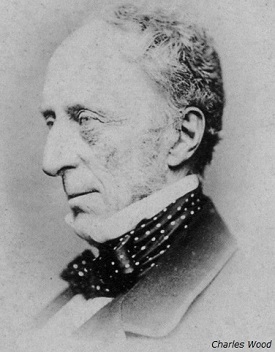
The State’s Educational Dispatch of 1854 (by Charles Wood) was another important step in the development of education in India.
The Dispatch asked the Government of India to assume responsibility for the education of the masses. It thus repudiated the “downward filtration” theory, at last on paper.
As a result of the directions given by the Dispatch, Departments of Education were instituted in all provinces and affiliating Universities were set up in 1857 at Calcutta, Bombay, and Madras.
Bankim Chandra Chatterjee, the famous Bengali novelist, became in 1858 one of the first two graduates of Calcutta University.
Western education was expected to reconcile the people of India to British rule particularly as it glorified the British conquerors of India and their administration. Thus the British wanted to use modern education to strengthen the foundation of their political authority in the country.
The traditional Indian system of education gradually withered away for lack of official support and even more because of the official announcement in 1844 that applicants for government employment should possess knowledge of English. Thus declaration made English-medium schools very popular and compelled more and more students to abandon the traditional schools.
Weakness of Educational System
A major weakness of the educational system was the neglect of mass education with the result that mass literacy in India was hardly better in 1921 than in 1821.
As many as 94 percent of Indians were illiterate in 1911 and 92 percent in 1921.
The emphasis on English as the medium of instruction in place of the Indian language also prevented the spread of education to the masses.
The costly nature of higher education tended to make it a monopoly of the richer classes and the city-dwellers.
A major lacuna in the early educational policy was the almost total neglect of the education of girls for which no funds were allotted. It was because female education lacked immediate usefulness in the eyes of the foreign officials (because women could not be employed as clerks in the Government offices).
The Company’s administration also neglected scientific and technical education.
By 1857, there were only three medical colleges in the country at Calcutta, Bombay, and Madras.
There was only one good Engineering College at Roorkee to impart higher technical education and even this was open only to Europeans and Eurasians.
Social and Cultural Awakening
Western conquest exposed the weakness and decay of Indian society. Hence, thoughtful Indians began to look for the defects of their society and for the ways and means of removing them.
Raja Ram Mohan Roy
The central figure in the awakening was Ram Mohan Roy, who is rightly regarded as the first great leader of modern India.
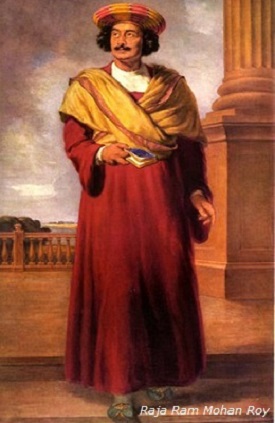
Ram Mohan Roy was pained by the stagnation and corruption of the contemporary Indian society, which was at that time dominated by caste and convention. Popular religion was full of superstitions and was exploited by ignorant and corrupt priests.
The upper classes were selfish and often sacrificed social interest to their own narrow interests.
Ram Mohan Roy possessed great love and respect for the traditional philosophic systems of the East; but, at the same time, he believed that Western culture alone would help to regenerate Indian society.
In particular, Ram Mohan Roy wanted his countrymen to accept the rational and scientific approach and the principle of human dignity and social equality of all men and women. He was also in favor of the introduction of modern capitalism and industry in the country.
Ram Mohan Roy represented a synthesis of the thought of East and West. He was a learned scholar who knew more than dozen languages including Sanskrit, Persian, Arabic, English, French, Latin, Greek, and Hebrew.
As a young man, Ram Mohan Roy had studied Sanskrit literature and Hindu philosophy at Varanasi and Koran and Persian and Arabic literature at Patna.
Ram Mohan Roy was also well-acquainted with Jainism and other religious movements and sects of India.
Ram Mohan Roy made an intensive study of Western thought and culture. Only to study the Bible in the original form, he learnt Greek and Hebrew.
In 1809, Ram Mohan Roy wrote his famous work Gift to Monotheists in Persian. In this work, he put forward weighty arguments against belief in many gods and for the worship of a single God.
Ram Mohan Roy settled in Calcutta in 1814 and soon attracted a band of young men with whose cooperation he started the Atmiya Sabha.
In particular, Ram Mohan Roy vigorously opposed worship of idols, rigidity of caste, and prevalence of meaningless religious rituals. He condemned the priestly class for encouraging and inculcating these practices.
Roy held that all the principal ancient texts of the Hindus preached monotheism or worship of one God.
Roy published the Bengali translation of the Vedas and of five of the principal Upanishads to prove his point. He also wrote a series of tracts and pamphlets in defence of monotheism.
In 1820, Roy published his Precepts of Jesus in which he tried to separate the moral and philosophic message of the New Testament, which ho praised, from its miracle stories.
Roy wanted the high-moral message of Christ to be incorporated in Hinduism. This earned for him the hostility of the missionaries.
Roy vigorously defended Hindu religion and philosophy from the ignorant attacks of the missionaries. At the same time, he adopted an extremely friendly attitude towards other religions.
Roy believed that basically all religions preach a common message and that their followers are all brothers under the skin.
In 1829, Roy founded a new religious society, the Brahma Sabha, later known as the Brahmo Samaj, whose purpose was to purify Hinduism and to preach theism or the worship of one God. The new society was to be based on the twin pillars of reason and the Vedas and Upanishads.
The Brahmo Samaj laid emphasis on human dignity, opposed idolatry, and criticized such social evils as the practice of Sati.
Ram Mohan Roy was one of the earliest propagators of modem education, which he looked upon as a major instrument for the spread of modern ideas in the country.
In 1817, David Hare, who had come to India in 1800 as a watchmaker, but who spent his entire life in the promotion of modern education in the country, founded the famous Hindu College.
Ram Mohan Roy gave most enthusiastic assistance to Hare in his educational projects.
Roy maintained at his own cost an English school in Calcutta from 1817 in which, among other subjects, mechanics and the philosophy of Voltaire were taught.
In 1825, Roy established a Vadanta College in which courses both in Indian learning and in Western social and physical sciences were offered.
Ram Mohan Roy represented the first glimmerings of the rise of national consciousness in India.
In particular, Roy opposed the rigidities of the caste system, which he declared, “has been the source of want of unity among us.” He believed that the caste system was double evil: it created inequality and it divided people and deprived them of patriotic feeling.
Ram Mohan Roy was pioneer of Indian journalism. He brought out journals in Bengali, Persian, Hindi, and English to spread scientific literary, and political knowledge among the people, to educate public opinion on topics of current interest, and to represent popular demands and grievances before the Government.
Roy was also the initiator of public agitation on political questions in the country.
Roy condemned the oppressive practices of the Bengal Zamindars, which had reduced the peasants to a miserable condition.
Roy demanded that the maximum rents paid by the actual cultivators of land should be permanently fixed so that they too would enjoy the benefits of the Permanent Settlement of 1793.
Roy also protested against the attempts to impose taxes on tax-free lands.
Roy demanded the abolition of the Company’s trading rights and the removal of heavy export duties on Indian goods.
Roy raised the demands for the Indianization of the superior services, separation of the executive and the judiciary, trial by jury, and judicial equality between Indians and Europeans.
Ram Mohan Roy took a keen interest in international events and everywhere he supported the cause of liberty, democracy, and nationalism and opposed injustice, oppression, and tyranny in every form.
Roy condemned the miserable condition of Ireland under the oppressive regime of absentee landlordism. He publicly declared that he would emigrate from the British Empire if Parliament failed to pass the Reform Bill.
Henry Vivian Derozio
A radical trend arose among the Bengali intellectuals during the late 1820s and the 1830s. This trend was more modern than Roy’s ideology and is known as the “Young Bengal Movement.”
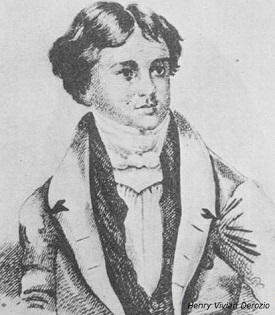
The leader and inspirer of Young Bengal Movement was the young Anglo-Indian Henry Vivian Derozio, who was born in 1809 and who taught at Hindu College from 1826 to 1831.
Derozio possessed a dazzling intellect and followed the most radical views of the time. He was inspired by the great French Revolution.
Derazio and his famous followers, known as the Derozians and Young Bengal, were fiery patriots. Perhaps, he was the first nationalist poet of modern India.
Derozio was removed from the Hindu College in 1831 because of his radicalism and died of cholera soon after at the young age of 22.
Even so, the Derozians carried forward Ram Mohan Roy's tradition of educating the people in social, economic, and political questions through newspapers, pamphlets, and public associations.
Surendranath Banerjee, the famous leader of the nationalist movement, described the Derozians as "the pioneers of the modern civilization of Bengal, the conscript fathers of our race whose virtues will excite veneration and whose failings will be treated with gentlest consideration."
Tatvabodhini Sabha
In 1839, Debendranath Tagore, father of Rabindranath Tagore, founded the Tatvabodhini Sabha to propagate Ram Mohan Roy's ideas.
The Tatvabodhini Sabha and its organ the Tatvabodhini Patrika promoted a systematic study of India's past in the Bengali language.
In 1843, Debendranath Tagore reorganized the Brahmo Samaj and put new life into it.
The Samaj actively supported the movement for widow remarriage, abolition of polygamy, Women's education, improvement of the ryot's condition, etc.
Pandit Ishwar Chandra Vidyasagar
Born in 1820 in a very poor family, Vidyasagar struggled through hardship to educate himself and in the end, became the principal of the Sanskrit College (in 1851).
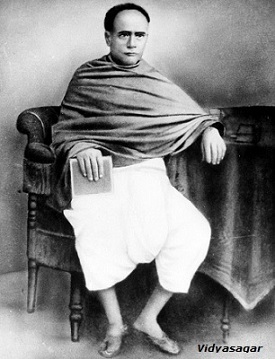
Though Vidyasagar was a great Sanskrit scholar, his mind was open to the Western thought, and he came to represent a happy blend of Indian and Western culture.
Vidyasagar resigned from government service, as he would not tolerate undue official interference.
Vidyasagar’s generosity to the poor was fabulous. He seldom possessed a warm coat that he invariably gave it to the first naked beggar he met on the street.
Vidyasagar evolved a new technique of teaching Sanskrit. He wrote a Bengali primer which is used till this day. By his writings, he helped in the evolution of a modern prose style in Bengali.
Vidyasagar opened the gates of the Sanskrit college to non-Brahmin students as well.
To free Sanskrit studies from the harmful effects of self-imposed isolation, Vidyasagar introduced the study of Western thought in the Sanskrit College. He also helped to establish a college, which is now named after him.
He raised his powerful voice, backed by the weight of immense traditional learning, in favor of widow remarriage in 1855.
The first lawful Hindu widow remarriage among the upper castes in India was celebrated in Calcutta on 7 December 1856 under the inspiration and supervision of Vidyasagar.
In 1850, Vidyasagar protested against child-marriage. All his life, he campaigned against polygamy.
As a Government Inspector of Schools, Vidyasagar organized thirty five girls’ schools, many of which he ran at his own expense.
The Bethune School, founded in Calcutta in 1849, was the first fruit of the powerful movement for women’s education that arose in the 1840s and 1850s.
As Secretary to the Bethune School, Vidyasagar was one of the innovators of higher education for women.
In 1848, several educated young men formed the Students’ Literary and Scientific Society, which had two branches, the Gujarati and the Marathi (Dnyan Prasarak Mandlis).
Jotiba Phule
In 1851, Jotiba Phule and his wife started a girls’ school at Poona and soon many other schools came up.
Phule was also a pioneer of the widow remarriage movement in Maharashtra.
Vishnu Shastri Pundit founded the Widow Remarriage Association in the 1850s.
Karsandas Mulji started a weekly paper in Gujarati called “the Satya Prakash” in 1852 to advocate widow remarriage.
An outstanding champion of a new learning and social reform in Maharashtra was Gopal Hari Deshmukh who became famous by the penname of ‘Lokahitawadi.’
Deshmukh advocated the reorganization of Indian society on rational principles and modern humanistic and secular values.
Dadabhahi Naoroji was another leading social reformer of Bombay. He was one of the founders of an association to reform the Zoroastrian religion and the Parsi Law Association which agitated for the grant of a legal status to women and for uniform laws of inheritance and marriage for the Parsis.
Modern Indian History - The Revolt of 1857
In 1857, a Revolt broke out in Northern and Central India and nearly swept away British rule.
The Revolt began with a mutiny of the sepoys, or the Indian soldiers of the Company's army, but soon engulfed wide regions and people. Millions of peasants, artisans, and soldiers fought heroically for over a year and by their courage and sacrifice wrote a glorious chapter in the history of the Indian people.
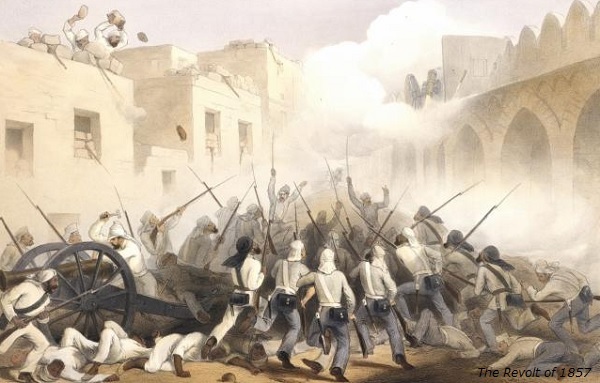
The Revolt of 1857 was much more than a mere product of sepoy discontent. It was, in reality, a product of the accumulated grievances of the people against the Company's administration and of their dislike for the foreign regime.
Immediate Cause of Revolt
By 1857, the material for a mass upheaval was ready, only a spark was needed to set it afire.
The new Enfield rifle had been introduced in the army. Its cartridges had a greased paper cover whose end had to be bitten of before the cartridge was loaded into the rifle.
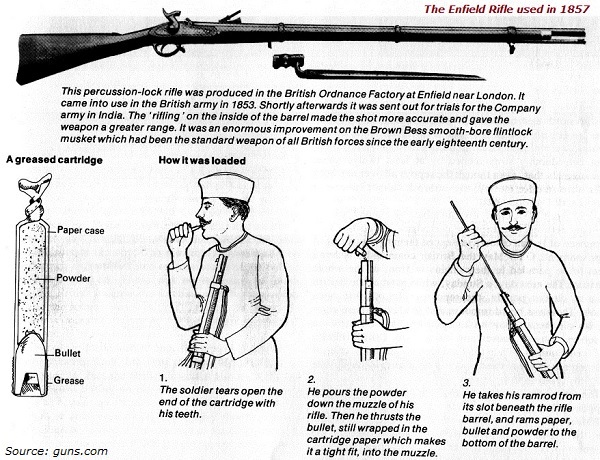
The grease was in some instances composed of beef and pig fat. The sepoys, Hindu as well as Muslim, were enraged, as the use of the greased cartridges would endanger their religion.
Many of the sepoys, believed that the Government was deliberately trying to destroy their religion.
Major Causes of 1857 Revolt
The major causes of 1857 Revolt can be studied under the following heads −
Economic Cause
Perhaps the most important cause of the people’s discontent was the economic exploitation of the country by the British and the complete destruction of its traditional economic fabric.
Socio-Political Cause
Other general causes of revolt were the British land revenue policies and the systems of law and administration. In particular, a large number of peasant proprietors lost their lands to traders and most of the lenders found themselves hopelessly burden under debt.
The common people were hard hit by the prevalence of corruption at the lower levels of administration. The police, petty officials, and lower (law) courts were notoriously corrupt.
The middle and upper classes of Indian society, particularly in the North, were hard hit by their exclusion from the well-paid higher posts in the administration.
Displacement of Indian rulers by the East India Company meant the sudden withdrawal of the patronage and the impoverishment of those who had depended upon it.
Religious preachers, pandits, and maulavis, who felt that their entire future was threatened, were to play an important role in spreading hatred against the foreign rule.
The British remained perpetual foreigners in the country. For one, there was no social link or communication between them and the Indians.
Unlike foreign conquerors before them, they did not mix socially even with the upper classes of Indians; instead, they had a feeling of racial superiority and treated Indians with contempt and arrogance.
The British did not come to settle in India and to make it their home. Their main objective was to enrich themselves and then go back to Britain along with Indian wealth.
Munshi Mohanlal of Delhi, who remained loyal to the British during the Revolt, wrote that even "those who bad grown rich under British rule showed hidden delight at British reverses." Another loyalist, Moinuddin Hasan Khan, pointed out that the people looked upon the British as "foreign trespassers."
The British army suffered major reverses in the First Afghan War (1838-42) and the Punjab Wars (1845-49), and the Crimean War (I854-56).
In 1855-56, the Santhal tribesmen of Bihar and Bengal rose up armed with axes and bows and arrows and revealed the potentialities of a popular uprising by temporarily sweeping away British rule from their area.
The British ultimately won these wars and suppressed the Santhal uprising; however, the disasters British suffered in major battles revealed that the British army could be defeated by determined fighting, even by an Asian army.
The annexation of Avadh by Lord Dalhousie in 1856 was widely resented in India in general and in Avadh in particular. It created an atmosphere of rebellion in Avadh and in the Company's army.
Dalhousie's action angered the Company's sepoys, as most of them came from Avadh.
The annexations rule of Dalhousie, created panic among rulers of the native states. They now discovered that their most groveling loyalty to the British had failed to satisfy the British greed for territory.
This policy of annexation was, for example, directly responsible for making Nana Sahib, the Rani of Jhansi, and Bahadur Shah their staunch enemies.
Nana Sahib was the adopted son of Baji Rao II, the last Peshwa. The British refused to grant Nana Sahib the pension they were paying to Baji Rao II, who died in 1851.
The British insistence on the annexation of Jhansi incensed the proud of Rani Lakshmibai who wanted her adopted son to succeed her deceased husband.
The house of the Mughals was humiliated when Dalhousie announced in 1849 that the Successor to Bahadur Shah would have to abandon the historic Red Fort and move to a humbler residence at the Qutab on the outskirts of Delhi.
In 1856, Canning announced that after Bahadur Shah's death, the Mughals would lose the title of kings and would be known as mere princes.
Religious Cause
An important role in turning the people against British rule was played by their fear that it endangered their religion. This fear was largely due to the activities of the Christian missionaries who were "to be seen everywhere — in the schools, in the hospitals, in the prisons and at the market place."
The missionaries tried to convert people and made violent and vulgar public attacks on Hinduism and Islam. They openly ridiculed and denounced the long cherished customs and traditions of the people.
In 1850, the Government enacted a law, which enabled a convert to Christianity to inherit his ancestral property.
Religious sentiments were also hurt by the official policy of taxing lands belonging to temples and mosques and to their priests or the charitable institutions which had been exempted from taxation by previous Indian rulers.
The many Brahmin and Muslim families dependent on the religious activities were aroused to fury, and they began to propagate that the British were trying to undermine the religions of India.
The sepoys also had religious or caste grievances of their own. The Indians of those days were very strict in observing caste rules, etc.
The military authorities forbade the sepoys to wear caste and sectarian marks, beards, or turbans.
In 1856, an Act was passed under which every new recruit undertook to serve even overseas, if required. This hurt the sepoys' sentiments as, according to the current religious belief of the Hindus, travel across the sea was forbidden and led to less of caste.
Historical Cause
The sepoys also had numerous other grievances against their employers. They were treated with contempt by their British officers.
The sepoys' dissatisfaction was because of the recent order that they would not be given the Foreign Service allowance (batta) when serving in Sindh or in the Punjab. This order resulted in a big cut in the salaries of a large number of them.
The dissatisfaction of the sepoys had, in fact, a long history. A sepoy mutiny had broken out in Bengal as early as 1764. The authorities had suppressed it by blowing away 30 sepoys.
In 1806, the sepoys at Vellore mutinied but were crushed with terrible violence.
In 1824, the 47th Regiment of sepoys at Barrackpore refused to go to Burma by the sea-route. The Regiment was disbanded, its unarmed men were fired upon by artillery, and the leaders of the sepoys were hanged.
In 1844, seven battalions revolted on the question of salaries and batta.
The sepoys in Afghanistan were on the verge of revolt during the Afghan War. Two subedars, a Muslim and a Hindu, were shot dead for giving expression to the discontent in the army.
Beginning of Revolt - Views
It is not yet clear whether the Revolt of 1857 was spontaneous, un-planned, or the result of a careful and secret organization.
The revolts have left behind no records. As they worked illegally, they perhaps kept no records.
The British suppressed any favorable mention of the Revolt, and took strong action against anyone who tried to present their side of the story.
A group of historians and writers has asserted that the Revolt was the result of a widespread and well-organized conspiracy. They pointed to the circulation of chapattis and red lotuses, propaganda by wandering as sanyasis, faqirs, and madaris.
The historians say that many of the Indian regiments were carefully linked in a secret organization which had fixed 31 May 1857 as the day when all of them were to revolt.
It is also said that Nana Sahib and Maulvi Ahmed Shah of Faizabad were playing leading roles in this conspiracy.
Some other writers equally forcefully deny that any careful planning went into the making of the Revolt. They point out that not a scrap of paper was discovered before or after the Revolt indicating an organized conspiracy, nor did a single witness come forward to make such a claim.
The truth perhaps lies somewhere between these two extreme views. It sterns likely that there was an organized conspiracy to revolt but that the organization had not progressed sufficiently when the Revolt broke out accidentally.
Diffusion of 1857 Revolt
The Revolt began at Meerut, 36 miles from Delhi, on 10 May 1857 and then gathering force rapidly spread across Northern India. It soon embraced a vast area from the Punjab in the North and the Narmada in the South to Bihar in the East and Rajputana in the West.
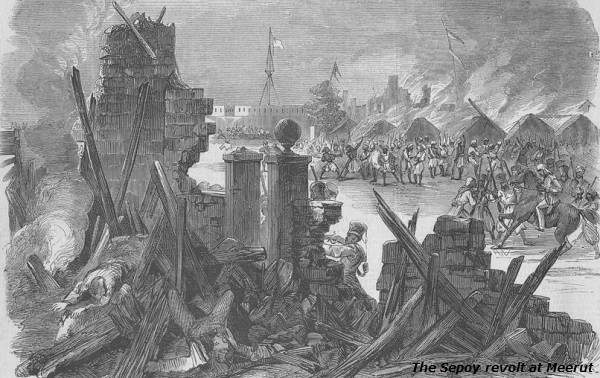
Even before the outbreak at Meerut, Mangal Pande had become a martyr at Barrackpore.
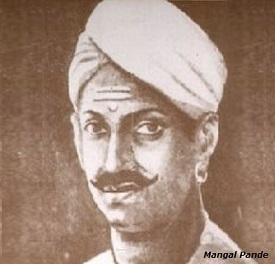
Mangal Pande, a young soldier, was hanged on 29 March 1857 for revolting single-handed and attacking his superior officers. This and many similar incidents were a sign that discontent and rebellion were brewing among the sepoy, and then came the explosion at Meerut.
On 24 April 1857, ninety men of the 3rd Native Cavalry refused to accept the greased cartridges. On 9 May 1857, eighty five of them were dismissed, sentenced to 10 years' imprisonment, and put into fetters. This sparked off a general mutiny among the Indian soldiers stationed at Meerut.
The very next day, on 10 May, sepoys released their imprisoned comrades, killed their officers, and unfurled the banner of revolt. As if drawn by a magnet they set off for Delhi after sunset.
When the Meerut soldiers appeared in Delhi the next morning, the local infantry joined them, killed their own European officers, and seized the city.
The rebellious soldiers proclaimed the aged and powerless Bahadur Shah the Emperor of India.
Delhi was soon to become the center of the Great Revolt and Bahadur Shah its great symbol.
Bahadur Shah, in turn, under the instigation and perhaps the pressure of the sepoys, soon wrote letters to all the chiefs and rulers of India urging them to organize a confederacy of Indian states to fight and replace the British regime.
The entire Bengal Army soon rose in revolt which spread quickly. Avadh, Rohlikhand, the Bundelkhand, Central India, large parts of Bihar, and the East Punjab, all shook off British authority.
In many of the princely states, rulers remained loyal to their British overlord but the soldiers revolted or remained on the brink of revolt.
More than 20,000 of Gwalior's troops went over to Tantia Tope and the Rani of Jhansi.
Many small chiefs of Rajasthan and Maharashtra, revolted with the support of the people, who were quite hostile to the British. Local rebellions also occurred in Hyderabad and Bengal.
The tremendous sweep and breadth of the Revolt were matched by its depth. Everywhere in Northern and Central India, the mutiny of the sepoys was followed by popular revolts of the civilian population.
After the sepoys had destroyed British authority, the common people was up in arms often lighting with spears and axes, bows and arrows, lathis and scythes, and crude muskets.
It was the wide participation to the Revolt by the peasantry and the artisans which gave it real strength as well as the character of a popular revolt, especially in the areas at present included in Uttar Pradesh and Bihar.
The popular character of the Revolt of 1857 also became evident when the British tried to smash it. They had to wage a vigorous and ruthless war not only against the rebellious sepoys but also against the people of Avadh, NorthWestern Provinces and Agra, Central India, and Western Bihar, burning entire villages and massacring villagers and urban people.
The sepoys and the people fought staunchly and valiantly up to the very end. They were defeated but their spirit remained unbroken.
Much of the strength of the Revolt of 1857 lay in Hindu-Muslim unity. Among the soldiers and the people as well as among the leaders there was complete cooperation as between Hindus and Muslims.
In fact, the events of 1857 clearly bring out that the people and politics of India were not basically communal in medieval times and before 1858.
Centers of 1857 Revolt
- The storm-centers of the Revolt of 1857 were −
- Delhi,
- Kanpur,
- Lucknow,
- Jhansi, and
- Arrah in Bihar.
Delhi
At Delhi, the nominal and symbolic; leadership belonged to the Emperor Bahadur Shah, but the real command lay with a Court of Soldiers headed by General Bakht Khan who had led the revolt of the Bareilly troops and brought them to Delhi.
In the British army, Bakht Khan was an ordinary subedar of artillery.
Bakht Khan represented the popular and plebian element at the headquarters of the Revolt.
After the British occupation of Delhi in September 1857, Bakht Khan went to Lucknow and continued to fight the British till he died in a battle on 13 May 1859.
The Emperor Bahadur Shah was perhaps the weakest link in the chain of leadership of the Revolt.
Kanpur
At Kanpur, the Revolt was led by Nana Sahib, the adopted son of Baji Rao II, the last Peshwa.
Nana Sahib expelled the English from Kanpur with the help of the sepoys and proclaimed himself the Peshwa. At the same time, he acknowledged Bahadur Shah as the Emperor of India and declared himself to be his Governor.
The chief burden of fighting on behalf of Nana Sahib fell on the shoulders of Tantia Tope, one of his most loyal servants.
Tantia Tope has won immortal fame by his patriotism, determined fighting, and skillful guerrilla operations.
Azimullah was another loyal servant of Nana Sahib. He was an expert in political propaganda.
Unfortunately, Nana Sahib tarnished his (Azimullah’s) brave record by deceitfully killing the garrison at Kanpur after he had agreed to give them safe conduct.
Lucknow
The revolt at Lucknow was led by the Begum of Avadh who had proclaimed her young son, Birjis Kadr, as the Nawab of Avadh.
Jhansi
One of the great leaders of the Revolt of 1857 and perhaps one of the greatest heroines of Indian history, was the young Rani Lakshmibai of Jhansi.
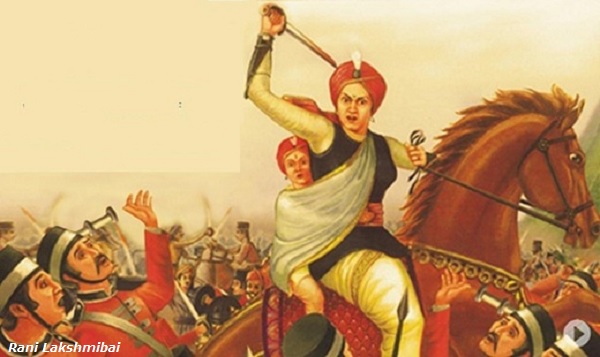
The young Rani joined the rebels when the British refused to acknowledge her right to adopt an heir to the Jhansi gaddi (throne) annexed her state, and threatened to treat her as an instigator of the rebellion of the sepoys at Jhansi.
Rani captured Gwalior with the help of Tantia Tope and her trusted Afghan guards.
Maharaja Sindhia, loyal to the British, made an attempt to fight the Rani but most of his troops deserted to her.
The brave Rani died fighting on 17 June 1858.
Arrah (Bihar)
Kunwar Singh, a ruined and discontented zamindar of Jagdishpur near Arrah, was the chief organizer of the Revolt in Bihar.
Though nearly 80 years old, Kunwar Singh was perhaps the most outstanding military leader and strategist of the Revolt.
Kunwar Singh fought with the British in Bihar, and, later joined hands with Nana Sahib's forces; he also campaigned in Avadh and Central India.
Racing back home, Kunwar Singh treated the British forts near Arrah. But this proved to be his last battle. He had sustained a fatal wound in the fighting. He died on 27 April 1858 in his ancestral house in the village of Jagdishpur.
Maulavi Ahmadullah of Faizabad was another outstanding leader of the Revolt. He was a native of Madras where he had started preaching armed rebellion.
In January 1857, Maulavi Ahmadullah moved towards the North to Faizabad where he fought a largescale battle against a company of British troops sent to stop him from preaching sedition.
When the general Revolt broke out in May, Maulavi Ahmadullah emerged as one of its acknowledged leaders in Avadh. After the defeat at Lucknow, he led the rebellion in Rohilkhand where he was treacherously killed by the Raja of Puwain who was received Rs 50,000 as a reward by the British.
Outcome of 1857 Revolt
The Revolt was suppressed. Sheer courage could not win against a powerful and determined enemy who planned its every step.
The rebels were dealt an early blow when the British captured Delhi on 20 September 1857 after prolonged and bitter fighting.
The aged Emperor Bahadur Shah was taken prisoner. The Royal Princes were captured and butchered on the spot. The Emperor was tried and exiled to Rangoon where he died in 1862.
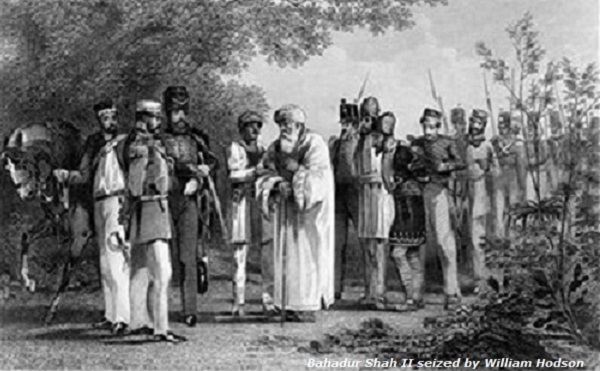
John Lawrence, Outran, Havelock, Neil, Campbell, and Hugh Rose were some of the British commanders who earned military fame in the course of the revolt.
One by one, all the great leaders of the Revolt fell. Nana Sahib was defeated at Kanpur. Defiant to the very end and refusing to surrender, he escaped to Nepal early in 1859, never to be heard of again.
Tantia Tope escaped into the jungles of Central India where he carried on bitter and brilliant guerrilla warfare until April 1859 when he was betrayed by a zamindar friend and captured while asleep. He was put to death after a hurried trial on 15 April 1859.
The Rani Jhansi had died on the field of battle earlier on 17 June 1858.
By 1859, Kunwar Singh, Bakht Khan, Khan Bahadur Khan of Bareilly, Rao Sahib brother of Nana Sahib, and Maulavi Ahmadullah were all dead, while the Begum of Avadh was compelled to hide in Nepal.
By the end of 1859, British authority over India was fully reestablished, but the Revolt had not been in vain. It was the first great struggle of the Indian people for freedom from British imperialism. It paved the way for the rise of the modern national movement.
Weaknesses of Revolt
Indian sepoys and people were short of modern weapons and other materials of war. Most of them fought with such ancient weapons as pikes and swords.
Indian sepoys and other revolt participants were also poorly organized. There was communication gap and they lacked consensus.
The rebel units did not have a common plan of action, or authoritative heads, or centralized leadership.
The sepoys were brave and selfless but they were also ill-disciplined. Sometimes they behaved more like a riotous mob than a disciplined army.
The uprisings in different parts of the country were completely uncoordinated.
Once the Indian people overthrew British power from an area, they did not know what sort of power to create in its place.
They failed to evolve unity of action. They were suspicious and jealous of one another and often indulged in suicidal quarrels. For example, the Begum of Avadh quarreled with Maulavi Ahmadullah and the Mughal princes with the sepoy-generals.
The peasants destroyed revenue records and money-lenders' books, and overthrown the new zamindars, became passive not knowing what to do next.
Modern nationalism was yet unknown in India. Patriotism meant love of one's small locality or region or at most one's state.
In fact, the Revolt of 1857 played an important role in bringing the Indian people together and imparting to them the consciousness of belonging to one country.
Criticism of 1857 Revolt
Even though spread over a vast territory and widely popular among the people, the Revolt of 1857 could not embrace the entire country or all the groups and classes of Indian society.
Most rulers of the Indian states and the big zamindars, selfish to the core and fearful of British might, refused to join in.
On the contrary, the Sindhia of Gwalior, the Holkar of Indore, the Nizam of Hyderabad, the Raja of Jodhpur and other Rajput rulers, the Nawab of Bhopal, the rulers of Patiala, Nabha, Jind, and Kashmir, the Ranas of Nepal, and many other ruling chiefs, and a large number of big zamindars gave active help to the British in suppressing the Revolt. In fact, no more than one per cent of the chiefs of India joined the Revolt.
Governor-General Canning later remarked that these rulers and chiefs "acted as the breakwaters to the storm which would have otherwise swept us in one great wave."
Madras, Bombay, Bengal, and the Western Punjab remained undisturbed, even though the popular feeling in these provinces favored the rebels.
Except for the discontented and the dispossessed zamindars, the middle and upper classes were mostly critical of the rebels; most of the propertied classes were either cool towards them or actively hostile to them.
The money-lenders were the chief targets of the villagers' attacks. They were, therefore, naturally hostile to the Revolt.
The merchants too gradually became unfriendly. The rebels were compelled to impose heavy taxation on them in order to finance the war or to seize their stocks of foodstuffs to feed the army
The merchants often hid their wealth and goods and refused to give free supplies to the rebels.
The big merchants or Bombay, Calcutta, and Madras supported the British because their main profits came from foreign trade and economic connections with the British merchants.
The zamindars of Bengal also remained loyal to the British. They were after all a creation of the British.
The modern educated Indians also did not support the Revolt. They were repelled by the rebels' appeals to superstitions and their opposition to progressive social measures.
The educated Indians wanted to end the backwardness of the country. They mistakenly believed that British rule would help them accomplish these tasks of modernization while the rebels would take the country backward.
The revolutionaries of 1857 proved to be more farsighted in this respect; they had a better, instinctive understanding of the evils of foreign rule and of the necessity to get rid of it.
On the other hand, they did not realize, as did the educated intelligentsia, that the country had fallen prey to foreigners precisely because it had stuck to rotten and outmoded customs, traditions, and institutions.
In any case, it cannot be said that the educated Indians were anti-national or loyal to a foreign regime. As events after 1858 were to show, they were soon to lead a powerful and modem national movement against British rule.
Administrative Changes After 1858
The Revolt of 1857 gave a severe jolt to the British administration in India and made its reorganization inevitable.
Introduction
An Act of Parliament in 1858 transferred the power to govern from the East India Company to the British Crown.
While authority over India had previously been wielded by the Directors of the Company and the Board of Control, now this power was to be exercised by a Secretary of State for India aided by a Council.
The Secretary of State was a member of the British Cabinet and as such was responsible to Parliament. Thus the ultimate power over India remained with British Parliament.
By 1869, the Council was completely subordinated to the Secretary of State. Most of the members of the India Council were retired British-Indian officials.
Under the Act, a government was to be carried on as before by the Governor-General who was also given the title of Viceroy or Crown's personal representative.
Viceroy was paid two and a half lakhs of rupees a year in addition to his other allowances.
With the passage of time, the Viceroy was increasingly reduced to a subordinate status in relation to the British Government in matters of policy as well as the execution of policy.
As a result of the Regulating Act, Pitt's India Act, and the later Charter Acts the Government of India was being effectively controlled from London.
Instructions from London took a few weeks to arrive and the Government of India had often to take important policy decisions in a hurry. Control by the authorities in London was therefore often more in the nature of post facto evaluation and criticism than of actual direction.
By 1870, a submarine cable had been laid through the Red Sea between England and India. Orders from London could now reach India in a matter of hours.
The Secretary of State could now control the minutest details of administration and do so constantly every hour of the day.
No Indian had a voice in the India Council or the British Cabinet or Parliament. Indians could hardly even approach such distant masters.
In a given condition, Indian opinion had even less impact on government policy than before. On the other hand, British industrialists, merchants, and bankers increased their Influence over the Government of India.
In India, the Act of 1858 provided that the Governor-General would have an Executive Council whose members were to act as heads of different departments and as his official advisers.
The position of the members of the Council was similar to that of Cabinet ministers. Originally there were five members of this Council but by 1918, there were six ordinary members, apart from the Commander-in-Chief who headed the Army Department.
The Council discussed all important matters and decided them by a majority vote; but the Governor-General had the power to override any important decision of the Council. In fact, gradually all power was concentrated in the Governor-General's hands.
The Indian Councils Act of 1861 enlarged the Governor-General's Council for the purpose of making laws in which capacity it was known as the Imperial Legislative Council.
The Governor-General was authorized to add to his Executive Council between six and twelve members of whom at least half had to be non-officials who could be Indian or English.
The Imperial Legislative Council possessed no real powers and should not be seen as a sort of elementary or weak parliament. It was merely an advisory body. It could not discuss any important measure, and no financial measures at all, without the previous approval of the Government
The Imperial Legislative Council had no control over the budget. It could not discuss the notions of the administration; the members could not even ask questions about them. The Legislative Council had no control over the executive.
No bill passed by Legislative Council could become an Act until it was approved by the Governor-General.
The Secretary of State could disallow any of its Acts. Thus, the only important function of the Legislative Council was to ditto official measures and give them the appearance of having been passed by a legislative body.
The Indian members of the Legislative Council were few in number and were not elected by the Indian people, but rather were nominated by the GovernorGeneral whose choice invariably fell on princes and their ministers, big zamindars, big merchants, or retired senior government officials.
For the better understanding, we can study the major administrative changes under the following heads −
Provincial Administration
Local Bodies
Change in Army
Public Services
Relations with Princely States
Administrative Policies and
Extreme Backwardness of Social Services
All these headings have been described briefly in subsequent chapters (with the same headings).
Provincial Administration
For the administrative convenience, the British had divided India into provinces; three of which — Bengal, Madras, and Bombay were known as Presidencies.
The Presidencies were administered by a Governor and his three Executive Councils, who were appointed by the Crown.
The Presidency Governments possessed more rights and powers than other provinces. Other provinces were administered by Lieutenant Governors and Chief Commissioners appointed by the Governor-General.
The Act of 1861 marked the turning of the tide of centralization. It laid down that legislative councils similar to that of the center should be established first in Bombay, Madras, and Bengal and then in other provinces.
The provincial legislative councils also were mere advisory bodies consisting of officials and four to eight non-official Indians and Englishmen. They also lacked the powers or a democratic parliament.
The evil of extreme centralization was most obvious in the field of finance. The revenues from all over the country and from different sources were gathered at the center and then distributed by it to the provincial governments.
The Central Government exercised authoritarian control over the smallest details of provincial expenditure. But this system proved quite wasteful in practice. It was not possible for the Central Government to supervise the efficient collection of revenues by a provincial government or to keep adequate check over its expenditure.
The two governments constantly quarreled over minute details of administration and expenditure, and, on the other, a provincial government had no motive to be economical. The authorities therefore decided to decentralize public finance.
In 1870, Lord Mayo had taken the first step in the direction of separating central and provincial finances. The provincial governments were granted fixed sums out of central revenues for the administration of certain services like Police, Jails, Education, Medical Services, and Roads and were asked to administer them as they wished.
Lord Mayo's scheme was enlarged in 1877 by Lord Lytton who transferred to the provinces certain other heads of expenditure such as Land Revenue, Excise, General Administration, and Law and Justice.
To meet the additional expenditure, a provincial government was to get a fixed share of the income realized from that province from certain sources like Stamps, Excise Taxes, and Income Tax.
In 1882, Lord Ripon had brought some changes. The system of giving fixed grants to the provinces was ended and, instead, a province was to get the entire income within it from certain sources of revenue and a fixed share of the income.
Thus all sources of the revenue were now divided into three heads as −
General,
Provincial, and
Those to be divided between the center and the provinces.
The financial arrangements between the center and the provinces were to be reviewed every five years.
Modern Indian History - Local Bodies
Financial difficulties led the Government to further decentralize administration by promoting local government through municipalities and district hoards.
Local bodies were first formed between 1864 and 1868, but almost in every case, they consisted of nominated members and were presided over by the District Magistrates.
The local bodies did not represent local self-government at all nor did the intelligent Indians accept them as such. The Indians looked upon them as instruments for the extraction of additional taxes from the people.
In 1882, Lord Ripon Government laid down the policy of administering local affairs largely through rural and urban local bodies, a majority of whose members would be non-officials.
The non-official members would be elected by the people wherever and whenever officials felt that it was possible to introduce elections.
The resolution also permitted the election of a non-official as Chairman of a local body.
The provincial acts were passed to implement this resolution. But the elected members were in a minority in all the district boards and in many of the municipalities.
Elected members were, moreover, elected by a small number of voters since the right to vote was severely restricted.
District officials continued to act as presidents of district boards though nonofficials gradually became chairmen of municipal committees.
The Government also retained the right to exercise strict control over the activities of the local bodies and to suspend and supersede them at its own discretion.
The local bodies functioned just like departments of the Government and were in no way good examples of local self-government.
Modern Indian History - Change in Army
The Indian army was carefully reorganized after 1858. Some changes were made necessary by the transfer of power to the Crown.
The East India Company's European forces were merged with the Crown troops. But the army was reorganized most of all to prevent the recurrence of another revolt.
The rulers had seen that their bayonets were the only secure foundation of their rule. Several following steps were taken to minimize, if not completely eliminate, the capacity of Indian soldiers to revolt −
The domination of the army by its European branch was carefully guaranteed.
The proportion of Europeans to Indians in the army was raised and fixed at one to two in the Bengal Army and two to five in the Madras and Bombay armies.
The European troops were kept in key geographical and military positions. The crucial branches of the army like artillery and, later in the 20th century, tanks, and armored corps were put exclusively in European hands.
The older policy of excluding Indians from the officer corps was strictly maintained. Till 1914, no Indian could rise higher than the rank of a subedar.
The organization of the Indian section of the army was based on the policy of "balance and counterpoise" or "divide and rule" so as to prevent its chances of uniting again in an anti-British uprising.
Discrimination on the basis of caste, region, and religion was practiced, in recruitment to the army.
A fiction was created that Indians consisted of "martial" and "non-martial" classes.
Soldiers from Avadh, Bihar, Central India, and South India who had first helped the British conquer India but had later taken part in the Revolt of 1857, were declared to be non-martial. They were no longer taken in the army on a large scale.
The Sikhs, Gurkhas, and Pathans, who had assisted in the suppression of the Revolt, were declared to be martial and were recruited in large numbers.
The Indian regiments were made a mixture of various castes' and groups' which were so placed as to balance each other.
Communal, caste, tribal, and regional loyalties were encouraged among the soldiers, so that the sentiment of nationalism would not grow among them.
It was isolated from nationalist ideas by every possible means. Newspapers, journals, and nationalist publications were prevented from reaching the soldiers.
Later, all such efforts failed in the long run and sections of the Indian army played an important role in our struggle for freedom.
Modern Indian History - Public Service
All positions of power and responsibility in the administration were occupied by the members of the Indian Civil Service who were recruited through an annual open competitive examination held in London.
Indians also could sit in this examination. Satyendranath Tagore, brother of Rabindranath Tagore, was the first Indian civil servant.
Almost every year, thereafter, one or two Indians joined the coveted ranks of the Civil Service, but their number was negligible compared to the English entrants.
In practice, the doors of the Civil Service remained barred to Indians because −
The competitive examination was held in faraway London;
It was conducted through the medium of the alien English language;
It was based on Classical Greek and Latin learning, which could be acquired only after a prolonged and costly course of studies in England; and
The maximum age for entry into the Civil Service was gradually reduced from twenty-three in 1859 to nineteen in 1878.
In other departments of administration such as: Police, Public Works Department, and Railways the superior and highly paid posts were reserved for British citizens.
The rulers of India believed it to be an essential condition for the maintenance of British supremacy in India.
The Viceroy, Lord Lansdowne, stressed "the absolute necessity of keeping the government of this widespread Empire in European hands, if that Empire is to be maintained."
The Indians, in the civil services, functioned as agents of British rule and loyally served Britain's imperial purposes.
Under Indian pressure, the different administrative services were gradually Indianised after 1918, but the positions of control and authority were still kept in British hands. Moreover, the people soon discovered that Indianisation of these services had not put any part of political power in their hands.
Relations with Princely States
Before 1857, British had availed themselves of every opportunity to annex princely states. The Revolt of 1857 led the British to reverse their policy towards the Indian States.
Most of the Indian princes had not only remained loyal to the British but had actively assisted in suppressing the Revolt.
Canning declared in 1862 that “the Crown of England stood forward, the unquestioned Ruler and Paramount Power in all India.” Princes were made to acknowledge Britain as the paramount power.
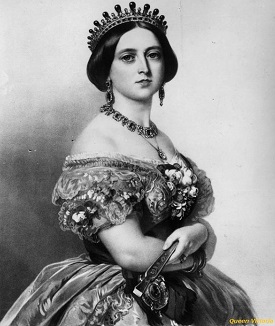
In 1876, Queen Victoria assumed the title of the ‘Empress of India’ to emphasize British sovereignty over the entire Indian subcontinent.
Lord Curzon later made it clear that the princes ruled their states merely as agents of the British Crown. The princes accepted this subordinate position and willingly became junior partners in the Empire because they were assured of their continued existence as rulers of their states.
As the paramount power, the British claimed the right to supervise the internal government of the princely states. They not only interfered in the day to day administration through the Residents but insisted on appointing and dismissing ministers and other high officials.
After 1868, the Government recognized the adopted heir of the old ruler and in 1881, the state was fully restored to the young Maharajah.
In 1874, the ruler of Baroda, Malhar Rao Gaekwad, was accused of misrule and of trying to poison the British Resident and was deposed after a brief trial.
Administrative Policies
The British attitude towards India and, consequently, their policies in India changed for the worse after the revolt of 1857, they now consciously began to follow reactionary policies.
The view was now openly put forward that the Indians were unfit to rule themselves and that they must be ruled by Britain for an indefinite period. This reactionary policy was reflected in many fields.
Divide and Rule Policy
The British had conquered India by taking advantage of the disunity among the Indian powers and by playing them against one another.
After 1858, the British continued to follow the policy of divide and rule by turning the princes against the people, province against province, caste against caste, group against group, and, above all, Hindus against Muslims.
The unity displayed by Hindus and Muslims during the Revolt of 1857 had disturbed the foreign rulers. They were determined to break this unity so as to weaken the rising nationalist movement.
Immediately after the Revolt, the British repressed Muslims, confiscated their lands and property on a large scale, and declared Hindus to be their favorites. However, after 1870, this policy was reversed and an attempt was made to turn upper class and middle class Muslims against the nationalist movement.
Because of industrial and commercial backwardness and the near absence of social services, the educated Indians depended almost entirely on government service. This led to keen competition among them for the available government posts.
The Government utilized this competition to foment provincial and communal rivalry and hatred. It promised official favors on a communal basis in return for loyalty and so played the educated Muslims against the educated Hindus.
Hostility to Educated Indians
The Government of India had actively encouraged modern education after 1833.
The Universities of Calcutta, Bombay, and Madras were started in 1857 and higher education spread rapidly thereafter.
Many British officials commended the refusal by educated Indians to participate in the Revolt of 1857. But this favorable official attitude towards the educated Indians soon changed because some of them had begun to use their recently acquired modern knowledge to analyze the imperialistic character of British rule and to put forward demands for Indian participation in administration.
The officials became actively hostile to higher education and to the educated Indians when the latter began to organize a nationalist movement among the people and founded the Indian National Congress in 1885.
The officials took active steps to curtail higher education. They sneered at the educated Indians whom they commonly referred to as ‘babus.’
Thus the British turned against that group of Indians who had imbibed modern Western knowledge and who stood for progress along modern lines. Such progress was, however, opposed to the basic interests and policies of British imperialism in India.
The official opposition to the educated Indians and higher education shows that British rule in India had already exhausted whatever potentialities for progress it originally possessed.
Attitude towards Zamindars
The British now offered friendship to the most reactionary group of Indians, the princes, the zamindars, and the landlords.
The zamindars and landlords too were placated in the same manner. For example, the lands of most of the talukdars of Avadh were restored to them.
The zamindars and landlords were now hailed as the traditional and 'natural' leaders of the Indian people. Their interests and privileges were protected. They were secured in the possession of their land at the cost of the peasants and were utilized as counter weights against the nationalist-minded intelligentsia.
The zamindars and landlords in return recognized that their position was closely bound up with the maintenance of British rule and became its only firm supporters.
Attitude towards Social Reforms
As a part of the policy of alliance with the conservative classes, the British abandoned their previous policy of helping the social reformers.
The British believed that their measures of social reform, such as the abolition of the custom of Sati and permission to widows to remarry, had been a major cause of the Revolt of 1857.
Pandit Jawaharlal Nehru has put it in his book “The Discovery of India," Because of this natural alliance of the British power with the reactionaries in India, it became the guardian and upholder of many an evil custom and practice, which it otherwise condemned."
It may, however, be noted that the British did not always remain neutral on social questions. By supporting the status quo they indirectly gave protection to existing social evils.
By encouraging casteism and communalism for political purposes, British actively encouraged the social reaction.
Restrictions on the Press
The British had introduced the printing press in India and thus initiated the development of the modern press.
The educated Indians had immediately recognized that the press could play a great role in educating public opinion and in influencing the government policies through criticism and censure.
Ram Mohan Roy, Vdyasagar, Dadabhai Naoroji, Justice Ranade, Surendranath Banerjea, Lokmanya Tilak, G. Subramaniya Iyer, C. Karhnakara Menon, Madan Mohan Malaviya, Lala Lajpat Rai, Bipin Chandra Pal, and other Indian leaders played an important part in starting newspapers and making them a powerful political force.
The Indian press was freed of restrictions by Charles Metcalfe in I835. This step had been welcomed enthusiastically by the educated Indians. It was one of the reasons why they had for some time supported British rule in India.
The nationalists gradually began to use the press to arouse national consciousness among the people and to sharply criticize the reactionary policies of the Government. This turned the officials against the Indian press and they decided to curb its freedom. This was attempted by passing the Vernacular Press Act in 1878.
The Press Act put serious restrictions on the freedom of the Indian language newspapers. Indian public opinion was now fully aroused and it protested loudly against the passage of this Act.
The protest had immediate effect and the Act was repealed in 1882. For nearly 25 years thereafter, the Indian press enjoyed considerable freedom. But the rise of the militant Swadeshi and Boycott movement after 1905 once again led to the enactment of the repressive press laws in 1908 and 1910.
Racial Antagonism
The British in India had always held aloof from the Indians and felt themselves be racially superior.
The Revolt of 1857 and the atrocities committed by both sides had further widened the gulf between the Indians and the British who now began to openly assert the doctrine of racial supremacy and practice racial arrogance.
Railway compartments, waiting rooms at railway stations, parks, hotels, swimming pools, clubs, etc. reserved for “Europeans only” were visible manifestations of this racialism.
Extreme Backwardness of Social Services
The Government of India spent most of its income on the army and wars and the administrative services and starved the social services.
In 1886, of its total net revenue of nearly Rs. 47 crores, the Governmental India spent nearly 19.41 crores on the army and 17 crores on civil administration but less than 2 crores on education, medicine, and public health and only 65 lakhs on irrigation.
The few halting steps that were taken in the direction of providing services like sanitation, water supply, and public health were usually confined to urban areas, and that too to the so called civil lines of British or modern parts of the cities.
Labor Legislation
In the 19th century, the condition of workers in modem factories and plantations was miserable. They had to work between 12 and 16 hours a day and there was no weekly day of rest.
Women and children worked the same long hours as men. The wages were extremely low, ranging from Rs. 4 to 20 per month.
The factories were over-crowded, badly lighted and aired, and completely unhygienic. Work on machines was hazardous, and accidents very common.
The Government of India, which was generally pro-capitalist, took some half-hearted and 'totally inadequate steps to mitigate the sorry state of affairs in the modern factories; many of the factories were owned by the Indians.
The manufacturers of Britain put constant pressure on it to pass factory laws. They were afraid that cheap labor would enable Indian manufacturers to outsell them in the Indian market.
The first Indian Factory Act was passed in l881. The Act dealt primarily with the problem of child labor.
The Factory Act of 1881 laid down that the child below 7 could not work in factories, while the children between 7 and 12 would not work for more than 9 hours a day. Children would also get four holidays in a month.
The Act also provided for the proper fencing around the dangerous machinery.
The second Indian Factory Act was passed in 1891, it provided for a weekly holiday for all workers.
Working hours for women were fixed at 11 per day while daily hours of work for children were reduced to 7. Hours of work for men were still left unregulated.
Neither of the two Acts applied to British-owned tea and coffee plantations. On the contrary, the Government gave every help to the foreign planters to exploit their workers in a most ruthless manner.
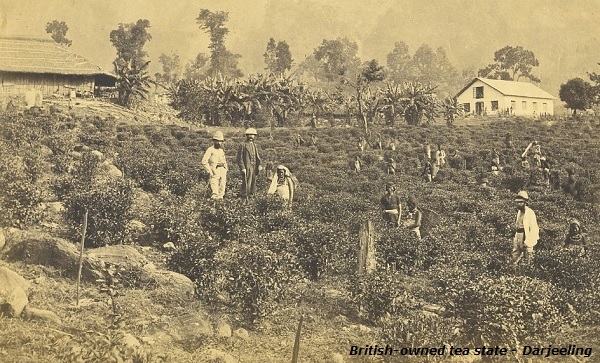
The Government of India gave planters full help and passed penal laws in 1863, 1865, 1870, 1873, and 1882 to enable them to do so.
Once a laborer had signed a contract to go and work in a plantation, he could not refuse to do so. Any breach of contract by a laborer was a criminal offence, the planter also having the power to arrest him.
Better labor laws were, however, passed in the 20th century under the pressure of the rising trade union movement. Still, the condition of the Indian working class remained extremely depressed and deplorable.
India & Her Neighbors
Under the British rule, India developed relations with its neighbors. This was the result of two factors i.e.
The development of modern means of communication and
The political and administrative consolidation of the Country impelled the Government of India to reach out to the geographical frontiers of India.
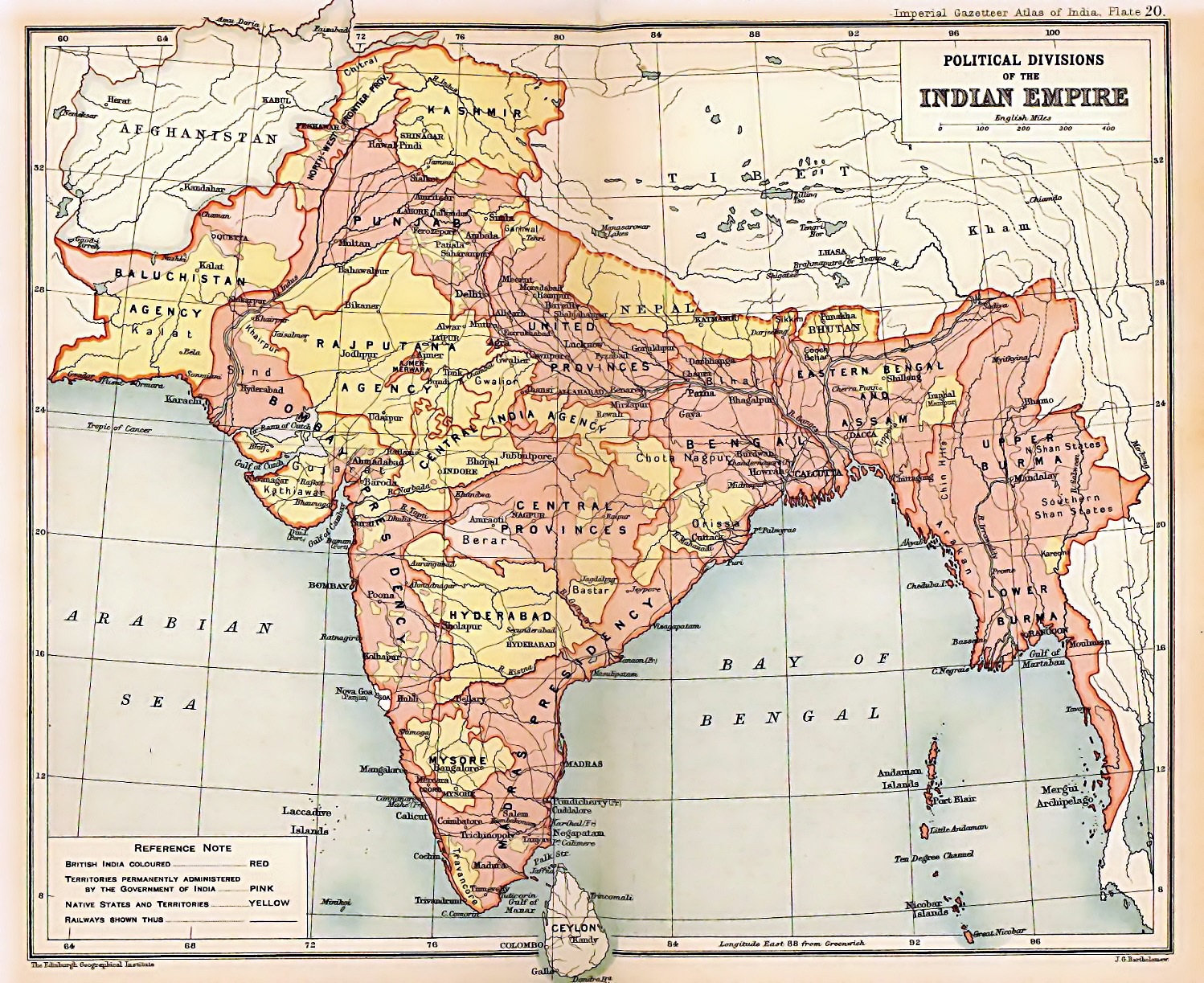
The foreign policy of a free country is basically different from the foreign policy of a country ruled by a foreign power. In the former case, it is based on the needs and interests of the people of the country; and in the latter case, it serves primarily the interests of the ruling country.
In India's case, the foreign policy that the Government of India followed was dictated by the British Government in London.
The British Government had two major aims in Asia and Africa i.e.
Protection of its invaluable Indian Empire and
Expansion of British commerce and other economic interests in Africa and Asia.
Both the aims (discussed above) led to British expansion and territorial conquests outside India's natural frontiers. These aims brought the British Government into conflict with other imperialist nations of Europe who also wanted an extension of their territorial possessions and commerce in AfroAsian lands.
The years between 1870 and 1914 witnessed an intense struggle between the European powers for colonies and markets in Africa and Asia.
While the Indian foreign policy served British imperialism, the cost of its implementation was borne by India.
In pursuance of British interests, India had to wage many wars against its neighbors; the Indian soldiers had to shed their blood and the Indian taxpayers had to meet the heavy cost.
The Indian army was often used in Africa and Asia to fight Britain's battles.
British India’s relation with its neighboring countries can be studied under the following heads (which have been described briefly in subsequent chapters under the same headings) −
Relation with Nepal
Relation with Burma
Relation with Afghanistan
Relation with Tibet
Relation with Sikkim
Relation with Bhutan
Modern Indian History - Relation with Nepal
The British desire to extend their Indian Empire to its natural geographical frontier brought them into conflict, first of all, with the northern Kingdom of Nepal.
War with Nepal, 1814
The Nepal valley had been conquered in 1768 by the Gurkhas, a Western Himalayan tribe.
Gurkhas had gradually built up a powerful army and extended their sway from Bhutan in the East to the river Sutlej in the West.
From the Nepal Tarai, the Gurkha now began to push southward. In the meanwhile, the British conquered Gorakhpur in 1801. This brought the two expanding powers face to face across as ill-defined border.
In October 1814, a border clash between the border police of the two countries led to open war.
The British officials had expected an easy walk-over especially as their army attacked all along the 600 mile frontier. But the Gurkhas defended themselves with vigor and bravery. The British armies were defeated again and again.
In the long run, however, the Gurkhas could not survive. The British were far superior in men, money, and materials
In April 1815, they occupied Kumaon, and on 15th May, they forced the brilliant Gurkha Commander Amar Singh Thapa to surrender.
The Government of Nepal was now compelled for peace. But the negotiations for peace soon broke down. The Government of Nepal would not accept the British demand for the stationing of a Resident at Kathmandu, capital Nepal.
It was realized that to accept a subsidiary alliance with the British amounted to signing away Nepal's independence. Fighting was resumed early in 1816.
The British forces won important victories and reached within 50 miles of Kathmandu. In the end, the Nepal Government had to make a peace agreement (known as Treaty of Sugauli) on British terms.
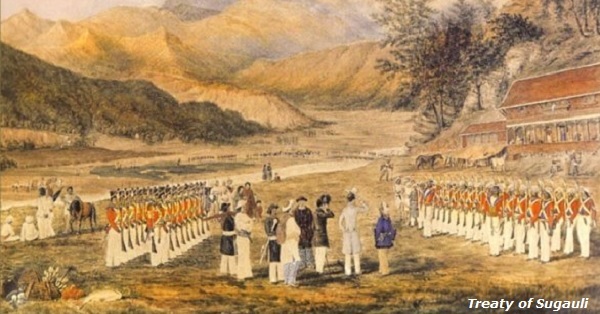
Nepal Government accepted a British Resident. It ceded the districts of Garhwal and Kumaon and abandoned claims to the Tarai areas. It also withdrew from Sikkim.
The agreement held many advantages for the British such as −
Their Indian Empire now reached the Himalayas;
They gained greater facilities for trade with Central Asia;
They also obtained sites for important hill-stations such as Simla, Mussoorie, and Nainital; and
The Gurkhas gave added strength to the British-Indian army by joining it in large numbers.
The relations of the British with Nepal were quite friendly thereafter. Both parties to the War of 1814 had learnt to respect each other's fighting capacity and preferred to live at peace with each other.
Modern Indian History - Relation with Burma
The conflict between Burma and British India was initiated by border clashes. It was whiffed by the expansionist urges.
The British merchants cast avaricious glances on the forest resources of Burma and were keen to promote export of their manufactures among its people.
The British authorities also wanted to check the spread of French commercial and political influence in Burma and the rest of South-East Asia.
Through three successive wars, the independent kingdom of Burma was conquered by the British during the 19th century.
First Burmese War, 1824-26
Burma and British India developed a common frontier at the close of the 18th century when both were expanding powers.
After centuries of internal strife, Burma was united by King Alaungpaya between 1752 and 1760.
Bodawpaya, the successor of King Alaungpaya, was ruling from Ava on the river Irrawaddi repeatedly invaded Siam, repelled many Chinese invasions, and conquered the border states of Arakan (1785) and Manipur (1813) bringing Burma's border up to that of British India. Continuing his westward expansion, he threatened Assam and the Brahmaputra Valley.
In 1822, the Burmese conquered Assam. The Burmese occupation of Arakan and Assam led to continuous friction along the ill-defined border between Bengal and Burma.
The Burmese Government pressed the British authorities to take action against the insurgents (Arakanese fugitives) and to hand them over to the Burmese authorities.
The Burmese forces, chasing the insurgents, would often cross into Indian Territory. In 1823, clashes on the Chittagong Arakan frontier came to a head over the possession of Shahpuri island, which was first occupied by the Burmese and then by the British.
The Burmese proposal for neutralization of the island was rejected by the British and tension between the two began to mount.
Burmese occupation of Manipur and Assam provided another source of conflict between the two. It was looked upon by the British authorities as a serious threat to their position in India. To counter this threat they established British influence over the strategic border states of Cachar and Jaintia.
The Burmese were angered by the British action and marched their troops into Cachar. A clash between Burmese and British troops ensued, the Burmese being compelled to withdraw into Manipur.
For several decades, British Indian authorities had been trying to persuade the Government of Burma to sign a commercial treaty with them and to exclude French traders from Burma.
The British believed that the Burmese power should be broken as soon as possible, especially as they felt that British power was at the time far superior to that of the Burmese. The Burmese, on their part, did nothing to avoid war.
The Burmese rulers had been long isolated from the world and did not correctly assess the strength of the enemy. They were also led to believe that an AngloBurmese war would lead many of the Indian powers to rebel.
The war was officially declared on 24 February 1824. After an initial set-back, the British forces drove the Burmese out of Assam, Cachar, Manipur, and Arakan.
The British expeditionary forces by sea occupied Rangoon in May 1824 and reached within 45 miles of the capital at Ava.
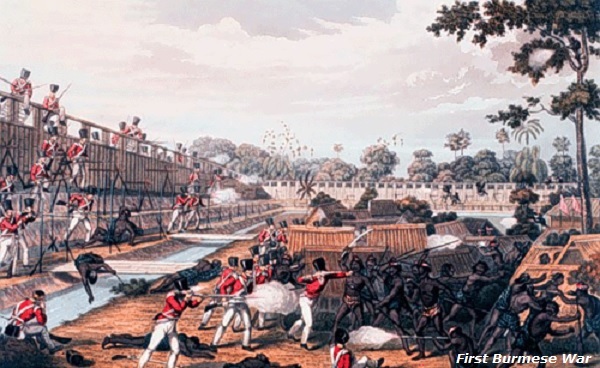
The famous Burmese General Maha Bandula was killed in April 1825. But Burmese resistance was tough and determined. Especially effective was guerrilla warfare in the jungles.
The rainy climate and virulent diseases added to the cruelty of the war. Fever and dysentery killed more people than the war.
In Rangoon, 3,160 died in hospitals and 166 on the battlefield. In all, the British lost 15,000 soldiers out of the 40,000 they had landed in Burma.
The war was proving extremely costly (financially as well as in terms human lives), thus the British, who were winning the war, as well as the Burmese, who were losing it, were glad to make peace which came in February 1826 with the Treaty of Yandabo.
The Government of Burma agreed −
to pay one crore rupees as war compensation;
to cede its coastal provinces of Arakan and Tenasserim;
to abandon all claims to Assam, Cachar, and Jaintia;
to recognize Manipur as an independent state;
to negotiate a commercial treaty with Britain; and
to accept a British Resident at Ava while posting a Burmese envoy at Calcutta.
By this treaty, the British deprived Burma of most of its coastline, and acquired a firm base in Burma for future expansion.
Second Burmese War (1852)
If the First Burmese War was in part the result of border clashes, the second Burmese War which broke out in 1852 was almost wholly the result of British commercial greed.
British timber firms had begun to take interest in the timber resources of Upper Burma. Moreover, the large population of Burma appeared to the British to be a vast market for the sale of British cotton goods and other manufactures.
The British, already in occupation of Burma's two coastal provinces, now wanted to establish commercial relations with the rest of the country, but the Burmese Government did not permit further foreign commercial penetration.
The British merchants now began to complain of ''lack of facilities for trade" and of "oppressive treatment" by the Burmese authorities at Rangoon.
The fact of the matter was that British imperialism was at its zenith and the British believed themselves to be a superior people. British merchants had begun to believe that they had a divine right to force their trade upon others.
By the time, the aggressive Lord Dalhousie became the Governor-General of India. He was determined to heighten British imperial prestige and to push British interests in Burma.
As an excuse for armed intervention in Burma, Dalhousie took up the frivolous and petty complaint of two British sea-captains that the Governor of Rangoon had extorted neatly 1,000 rupees from them.
In November 1851, Dalhousie sent an envoy, accompanied by several ships of war, to Rangoon to demand compensation for the two British merchants.
The British envoy, Commodore Lambert, behaved in an aggressive and unwarranted manner. On reaching Rangoon, he demanded the removal of the Governor of Rangoon before he would agree to negotiate.
The Court at Ava was frightened by the show of British strength and agreed to recall the Governor of Rangoon and to investigate British complaints. But the haughty British envoy was determined to provoke a conflict. He started a blockade of Rangoon and attacked and destroyed over 150 small ships in the port.
The Burmese Government agreed to accept a British Resident at Rangoon and to pay the full compensation demanded by the British.
The Government of India now turned on the screw and pushed up their demands to an exorbitant level. They demanded the recall of the new Governor of Rangoon and also an apology for alleged insults to their envoy.
Such demands could hardly be accepted by an independent government. Obviously, the British desired to strengthen their hold over Burma by peace or by war before their trade competitors, the French or the Americans, could establish themselves there.
A full British expedition was dispatched to Burma in April 1852. This time, the war was much shorter than in 1825-26 and the British victory was more decisive.
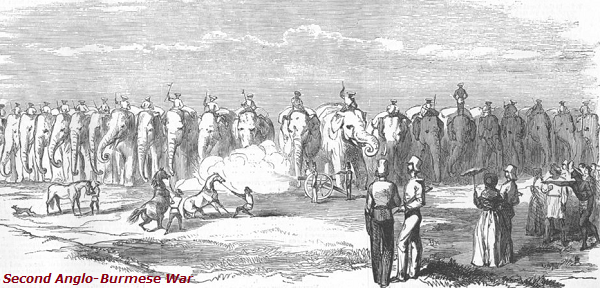
Rangoon was immediately captured and then other important towns—Bassein, Pegu, Prome fell to the British.
Burma was at this time undergoing a struggle for 'power. The Burmese King, Mindon, who had deposed his half-brother, King Pagan Min, in a struggle for power in February 1853, was hardly in a position to fight with the British; at the same time, he could not openly 'agree to surrender Burmese territory. Consequently, there were no official negotiations for peace and the war ended without a treaty.
The British now controlled the whole of Burma's coastline and its entire seatrade.
The brunt of fighting the war was borne by Indian soldiers and its expense was wholly met from Indian revenues.
Third Burmese War (1885)
Relations between Burma and Britain remained peaceful for several years after the annexation of Pegu.
In particular, the British merchants and industrialists were attracted by the possibility of trade with China through Burma.
There was vigorous agitation in Britain and Rangoon for opening the land route to Western China. Finally, Burma was persuaded in 1862 to sign a commercial treaty by which British merchants were permitted to settle in any part of Burma and to take their vessels up the Irrawaddy River to China.
British merchants were impatient of restrictions on their trade and profits and began to press for stronger action against the Burmese Government. Many of them even demanded British conquest of Upper Burma. The king was finally persuaded to abolish all monopolies in February 1882.
Causes of Third Anglo-Burmese War
There are many other political and economic questions over which the Burmese king and the British Government clashed.
The British Government humiliated the king in 1871 by armoring that relations with him would be conducted through the Viceroy of India as if he were merely a ruler of one of the Indian states. Another source of friction was the attempt by the king to develop friendly relations with other European powers.
In 1873, a Burmese mission visited France and tried to negotiate a commercial treaty, which would also enable Burma to import modern arms, but later under British pressure, the French Government refused to ratify the treaty.
King Mindon died in 1878 and was succeeded by King Thibaw.
The British gave shelter to rival princes and openly interfered in Burma's internal affairs under the garb of preventing the alleged cruelties of King Thibaw.
The British thus claimed that they had the right to protect the citizens of Upper Burma from their own king.
Thibaw's desire to pursue his father’s policy of developing commercial and political relations with France.
In 1885, Thibaw signed a purely commercial treaty with France providing for trade. The British were intensely jealous of the growing French influence in Burma.
The British merchants feared that the rich Burmese market would be captured by their French and American rivals.
The British officials felt that an alliance with France might enable the king of Upper Burma to escape British tutelage or might even lead to the founding of a French dominion in Burma and so endanger the safety of their Indian Empire.
The French had already emerged as a major rival of Britain in South-East Asia.
In 1883, they had seized Annam (Central Vietnam), thus laying the foundation of their colony of Indo-China.
They were pushing actively towards North Vietnam, which they conquered between 1885 and 1889, and in the west towards Thailand and Burma.
The chambers of commerce in Britain and the British merchants in Rangoon now pressed the willing British Government for the immediate annexation of Upper Burma.
Immediate Cause
Only a pretext for war was needed. This was provided by the Bombay-Burma Trading Corporation, a British concern which held a lease of the teak forests in Burma.
The Burmese Government accused the Company of extracting more than double the quantity of teak contracted for by bribing local officials, and demanded compensation.
The British Government, which had already prepared a military plan for the attack on Upper Burma, decided to seize this opportunity and put forward many claims on the Burmese Government including the demand that the foreign relations of Burma must be placed under the control of the Viceroy of India.
The Burmese Government could not have accepted such demands without losing its independence. Its rejection was followed by a British invasion on 13 November 1885.
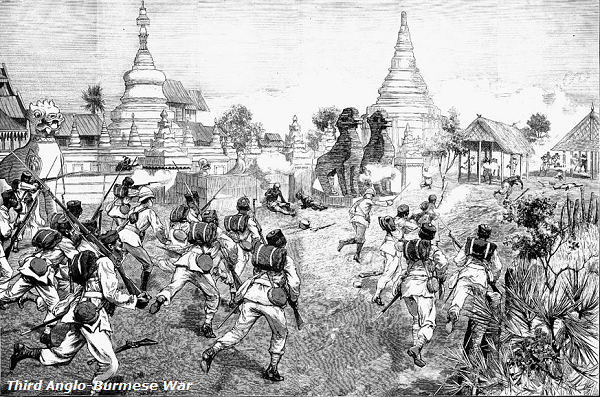
Burma as an independent country had every right to put trade restrictions on foreigners. Similarly, it had every right to establish friendly relations with France and to import arms from anywhere.
The Burmese Government was unable to put up effective resistance to the British forces. The King was incompetent, unpopular, and unprepared for war.
The country was divided by court intrigues. A condition of near civil war prevailed. King Thibaw surrendered on 28 November 1885 and his dominions were annexed to the Indian Empire soon after.
Freedom Struggle of Burma
After the First World War, a vigorous modern nationalist movement arose in Burma. A wide campaign of boycotting British goods and administration was organized and the demand for Home Rule was put forward.
The Burmese nationalists soon joined hands with the Indian National Congress.
In 1935, the British separated Burma from India in the hope of weakening the Burmese struggle for freedom. The Burmese nationalists opposed this step.
The Burmese nationalist movement reached new heights under the leadership of U Aung San during the Second World War. And, finally, Burma won its independence on 4 January 1948.
Relation with Afghanistan
The British Indian Government fought two wars with Afghanistan before its relations with the Government of Afghanistan were stabilized.
During the 19th century, the problem of Indo-Afghan relations got inextricably mixed up with the Anglo-Russian rivalry. Britain was expanding colonial power in West, South, and East Asia, Russia was an expanding power in Central Asia and desired to extend its territorial control in West and East Asia.
The two imperialisms openly clashed all over Asia. In fact, in 1855, Britain in alliance with France and Turkey, fought a war with Russia, known as the Crimean War.
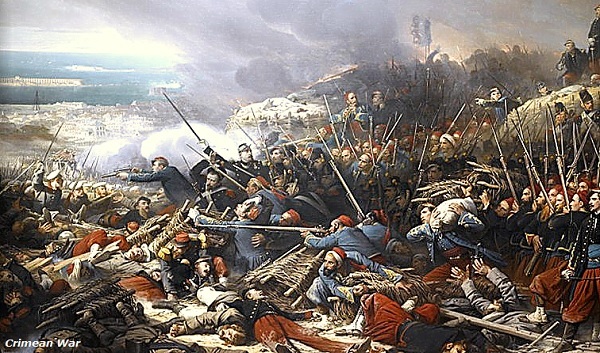
Throughout the 19th century, the British rulers of India feared that Russia would launch an attack on India through Afghanistan and the North Western frontier of India. They, therefore, wanted to keep Russia at a safe distance from the Indian frontier.
Afghanistan was placed in a crucial position geographically from the British point of view. It could serve as an advanced post outside India’s frontiers for checking Russia's potential military threat as well as for promoting British commercial interests in Central Asia.
The British policy towards Afghanistan entered an active phase in 1835 when the Whigs came to power in Britain and Lord Palmerston became the Foreign Secretary.
Afghan politics had been unstable since the early years of the 19th century. Dost Muhammad Khan(the ruler of Afghanistan) had brought about partial stability, but was constantly threatened by internal and external enemies such as −
In the North, Dost Muhammad faced internal revolts and the potential Russian danger;
In the South, one of his brothers challenged his power at Kandahar;
In the East, Maharaja Ranjit Singh had occupied Peshawar and beyond him lay the English; and
In the West, enemies were at Herat and the Persian threat
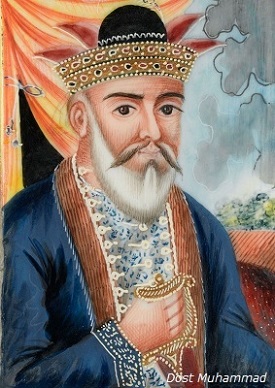
Dost Muhammad Khan was therefore in dire need of powerful friends. And, since he had a high regard for English strength, he desired some sort of an alliance with the Government of India.
The Russians tried to convince Dost Mohammad Khan, but he refused to comply. While discouraging the Russian envoy, he adopted a friendly attitude towards the British envoy, Captain Burns. But he failed to get adequate terms from the British who would not offer anything more than a verbal sympathy.
The British wanted to weaken and end Russian influence in Afghanistan, but they did not want a strong Afghanistan. They wanted to keep her a weak and divided country which they could easily control.
Lord Auckland, the Indian Governor-General, offered Dost Muhammed an alliance based on the subsidiary system.
Dost Muhammed wanted to be an ally of the British Indian Government on the basis of complete equality and not as one of its puppets or subsidiary allies.
Having tried his best to acquire British friendship, but failed, Dost Muhammad reluctantly turned towards Russia.
The First Afghan War
Auckland now decided to replace Dost Mohammed with a friendly i.e. subordinate ruler. His gaze fell on Shah Shuja, who had been deposed from the Afghan throne in 1809 and since then living at Ludhiana as a British pensioner.
On 26 June 1838, the Indian Government, Maharaja Ranjit Singh, and Shah Shuja signed a treaty at Lahore (three allies) by which the first two promised to help Shah Shuja capture power in Afghanistan and, in return, Shah Shuja promised not to enter into negotiations with any foreign state without the consent of the British and the Punjab Governments.
The three allies launched an attack on Afghanistan in February 1839. But Ranjit Singh cleverly hung back and never went beyond Peshawar. The British forces had not only to take the lead but to do all weary fighting.
Most of the Afghan tribes had already been won over with bribes. Kabul fell to the English on 7 August 1839, and Shah Shuja was immediately placed on the throne.
Shah Shuja was detested and despised by the people of Afghanistan, especially as he had come back with the help of foreign bayonets.
The Afghani people resented British interference in their administration. Gradually, the patriotic, freedom-loving Afghans began to rise up in anger and Dost Muhammed and his supporters began to harass the British army.
Dost Muhammed was captured in November 1840 and sent to India as a prisoner. But popular anger went on increasing and more and more Afghan tribes rose in revolt.
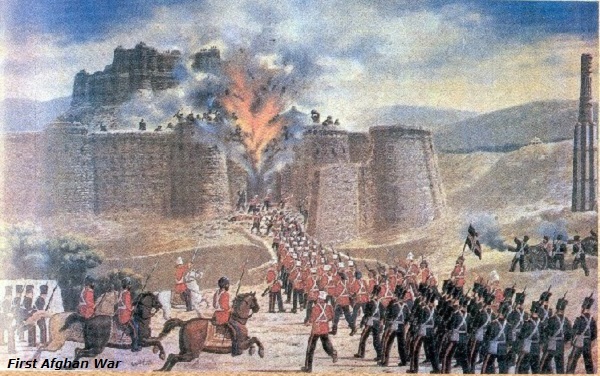
Then suddenly, on 2 November 1841, art uprising broke out at Kabul and the sturdy Afghans fell upon the British forces.
On 11 December 1841, the British were compelled to sign a treaty with the Afghan chiefs by which they agreed to evacuate Afghanistan and to restore Dost Mohammed.
As the British forces withdrew, the Afghan were attacked all along the way. Out of 16,000 men, only one reached the frontier alive, while a few others survived as prisoners.
The entire Afghan adventure ended as total failure. It had proved as one of the greatest disasters suffered by the British arms in India.
The British Indian Government now organized a new expedition. Kabul was reoccupied on 16 September 1842.
But it had learnt its lesson well, having avenged its recent defeat and humiliation, it arrived at a settlement with Dost Mohammed by which the British evacuated Kabul and recognized him as the independent ruler of Afghanistan.
Afghan War cost India over one and a half crores of rupees and its army, about 20,000 men.
Policy of Non-Interference
A new period of Anglo-Afghan friendship was inaugurated in 1855 with the signing of a treaty of friendship between Dost Mohammed and the Government of India.
The two governments promised to maintain friendly and peaceful relation, to respect each other's territories, and to abstain from interfering in each other's internal affairs.
Dost Mohammed also agreed that he would be "the friend of the friends of the East India Company and the enemy of its enemies." He remained loyal to this treaty during the Revolt of 1857 and refused to give help to the rebels.
After 1964, the policy of non-interference was vigorously pursued by Lord Lawrence and his two successors. As Russia again turned its attention to Central Asia after its defeat in the Crimean War; however, the British followed the policy of strengthening Afghanistan as a powerful buffer.
The British gave the Amir of Kabul aid and assistance to help him discipline his rivals internally and maintain his independence from foreign enemies. Thus, by a policy of non-interference and occasional help, the Amir was prevented from aligning himself with Russia.
Second Afghan War
The policy of non-interference did not, however, last very long. From 1870 onwards, there was a resurgence of imperialism all over the world. The Anglo-Russian rivalry was also intensified.
The British Government was again keen on the commercial and financial penetration of Central Asia.
Anglo-Russian ambitions clashed ever, more openly in the Balkans and West Asia.
The British statesmen once again thought of bringing Afghanistan under direct political control so that it could serve as a base for British expansion in Central Asia.
The Indian Government was directed by London to make Afghanistan a subsidiary state whose foreign and defence policies would be definitely under British control.
Sher Ali, the Afghan ruler or Amir, was fully conscious of the Russian danger to his independence and he was, therefore, quite willing to cooperate with the British in eliminating any threat from the North.
Sher Ali offered the Government of India a defensive and offensive alliance against Russia and asked it for promise of extensive military aid in case of need against internal or foreign enemies.
The Indian Government refused to enter into any such reciprocal and unconditional commitment. It demanded instead the unilateral right to keep a British mission at Kabul and to exercise control over Afghanistan's foreign relations.
When Sher Ali refused to comply, he was declared to be anti-British and pro-Russian in his sympathies.
Lord Lytton, who had come to India as Governor-General in 1876, openly declared: "A tool in the hands of Russia, I will never allow him to become. Such a tool it would be my duty to break before it could be used."
Lytton proposed to effect "the gradual disintegration and weakening of the Afghan power."
To force British terms on the Amir, a new attack on Afghanistan was launched in 1878. Peace came in May 1879 when Sher Ali's son, Yakub Khan, signed the Treaty of Gandamak by which the British secured all they had desired.
They secured certain border districts, the right to keep a Resident at Kabul, and control over Afghanistan's foreign policy.
The British success was short lived. The national pride of the Afghans had been hurt and once again they rose to defend their independence.
On 3 September 1879, the British Resident, Major Cavagnari, and his military escort were attacked and killed by rebellious Afghan troops. Afghanistan was again Invaded and occupied.
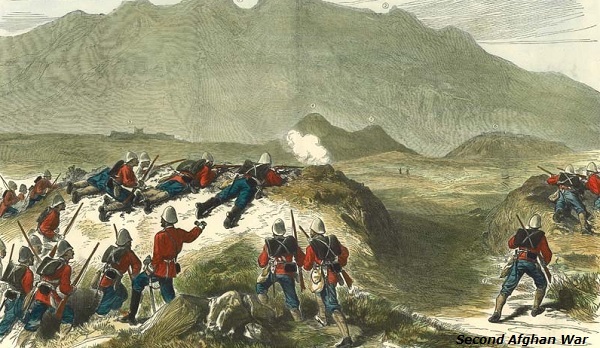
A change of government took place in Britain in 1880 and Lytton was replaced by a new Viceroy, Lord Ripon.
Ripon rapidly reversed Lytton's aggressive policy and went back to the policy of non-interference in the internal affairs of a strong and friendly Afghanistan.
Ripon recognized Abdur Rahman a grandson of Dost Mohammed, as the new ruler of Afghanistan.
The demand for the maintenance of a British Resident in Afghanistan was withdrawn in return, Abdur Rahman agreed not to maintain political relations with any power except the British.
The Government of India also agreed to pay Amir an annual subsidy and to come to his support in case of foreign aggression.
Amir of Afghanistan lost control of his foreign policy and, to that extent became a dependent ruler.
Third Anglo-Afghan War
The First World War and the Russian Revolution of 1917 created a new situation in Anglo-Afghan relations.
The war gave rise to strong anti-British feeling in Muslim countries, and the Russian Revolution inspired new anti-imperialist sentiments in Afghanistan as, in fact, all over the world.
The disappearance of Imperial Russia, moreover, removed the perpetual fear of aggression from the northern neighbor, which had compelled successive Afghan rulers to look to the British for support.
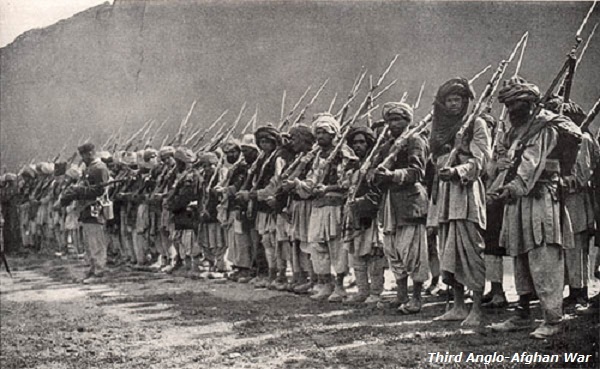
The Afghans now demanded full Independence from British control. Habibullah, who had succeeded Abdul Rahman in 1901 as Amir, was assassinated on 20 February 1919 and his son Amanullah, the new Amir, declared open war on British India.
Peace came in 1921 by a treaty, Afghanistan recovered its independence in foreign affairs.
Modern Indian History - Relation with Tibet
Tibet lies to the north of India where the Himalayan peaks separate it from India. It was ruled by a Buddhist religious aristocracy (the Lamas) who had reduced the local population to serfdom and even slavery.
The chief political authority was exercised by the Dalai Lama, who claimed to be the living incarnation of the power of the Buddha.
The lamas wanted to isolate Tibet from the rest of the world; however, since the beginning of the 17th century, Tibet had recognized the nominal suzerainty of the Chinese Empire.
The Chinese Government also discouraged contacts with India though a limited trade and some pilgrim traffic between India and Tibet existed.
The Chinese Empire under the Manchu monarchy entered a period of decline during the 19th century. Gradually, Britain, France, Russia, Germany, Japan, and the United States of America penetrated China commercially and politically and established indirect political control over the Manchus.
The Chinese people also created a powerful anti-Manchu and anti-imperialist nationalist movement at the end of the 19th century and the Manchus were overthrown 'in 1911.
But the nationalists led by Dr. Sun Yat Sen failed to consolidate their power and China was torn by civil war during the next few years.
The result was that, China, since the middle of the 19th century, was in no position to assert even nominal control over Tibet. The Tibetan authorities still acknowledged in theory Chinese over lordship so that other foreign powers would not feel tempted to penetrate Tibet. But Tibet was not able to maintain its complete isolation for long.
Both Britain and Russia were keen to promote relations with Tibet. The British policy towards Tibet was governed by both economic and political considerations.
Economically, the British wanted to develop lndo-Tibetan trade and to exploit its rich mineral resources.
Politically, the British wanted to safeguard the northern frontier of India. But up to the end of the 19th century, the Tibetan authorities blocked all British efforts to penetrate it.
At this time, Russian ambitions also turned towards Tibet. Russian influence in Tibet was on the increase, this the British Government would not tolerate.
The Government of India, under Load Curzon, a vigorous empire builder, decided to take immediate action to counter Russian moves and to bring Tibet under its system of protected Border States.
According to some historians, the Russian danger was not real and was merely used as an excuse by Curzon to intervene in Tibet.
In March 1904, Curzon dispatched a military expedition to Lhasa, the Capital of Tibet, under Francis Younghusband.
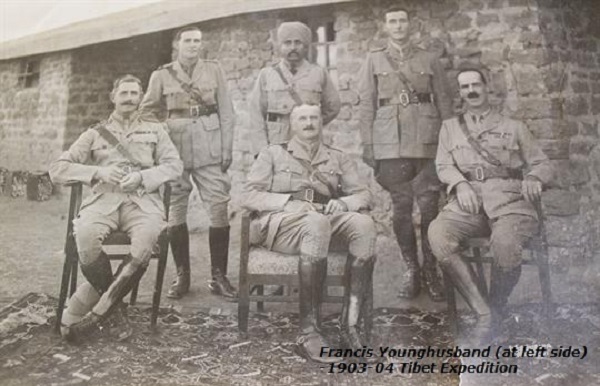
The virtually unarmed Tibetans, who lacked modern weapons, fought back bravely but without success.
In August 1904, the expedition reached Lhasa without coming across any Russians on the way. A treaty was signed after prolonged negotiations.
Tibet had to pay Rs. 25 lakhs as indemnity; the Chumbi valley was to be occupied by the British for three years; a British trade mission was to be stationed at Gyantse.
The British agreed not to interfere in Tibet's internal affairs. On their part, the Tibetans agreed not to admit the representatives of any foreign power into Tibet.
The British achieved very little by the Tibetan expedition. It secured Russia's withdrawal from Tibet, but at the cost of confirming Chinese suzerainty.
Relations with Sikkim
The state of Sikkim lies to the north of Bengal, adjacent to Nepal and at the border between Tibet and India (as shown in the map given below – highlighted with red line).

In 1835, the Raja of Sikkim ceded to the British territory around Darjeeling in return for an annual money grant.
Friendly relations between the British and Raja (of Sikkim) were disturbed in 1849 when a minor quarrel led Dalhousie to send troops into Sikkim whose ruler was in the end forced to cede nearly 1700 square miles of his territory to British India.
In 1860, the second clash occurred when the British were engaged by the troops of the Diwan of Sikkim.
By the peace treaty signed in 1861, Sikkim was reduced to the status of a virtual protectorate.
The Raja of Sikkim expelled the Diwan and his relations from Sikkim, agreed to pay a fine of Rs. 7,000 as well as full compensation for British losses in the war, opened his country fully to British trade, and agreed to limit the transit duty on goods exchanged between India and Tibet via Sikkim.
In 1886, fresh trouble arose when the Tibetans tried to bring Sikkim under their control with the complicity of its rulers who were pro-Tibet. But the Government of India would not let this happen.
It looked upon Sikkim as an essential buffer for the security of India's northern frontier, particularly of Darjeeling and its tea-gardens. The British, therefore, carried out military operations against the Tibetans in Sikkim during 1888.
A settlement came in 1890 with the signing of an Anglo-Chinese agreement. The treaty recognized that Sikkim was a British protectorate over whose internal administration and foreign relations, the Government of India had the right to exercise exclusive control.
Relations with Bhutan
Bhutan is a large hilly country to the East of Sikkim and at India's northern border (as shown in the map given below – highlighted with red line).

Warren Hastings established friendly relations with the ruler of Bhutan after 1774 when Bhutan permitted Bengal to trade with Tibet through its territory.
Relations between the Government of India and Bhutan became unsatisfactory after 1815. The British now began to cast greedy eyes upon the narrow strip or territory of about 1,000 square miles at the base of Bhutan hills containing a number of duars or passes.
This area would give India a well-defined and defendable border and useful tea-lands to the British planters.
In 1841, Lord Auckland annexed the Assam duars.
The relations between India and Bhutan were further strained by the intermittent raids made by the Bhutiyas (tribal group) on the Bengal side of the border.
In 1865, a brief war broke out between the British and Bhutan. The fighting was utterly one-sided and was settled by a treaty signed in November 1865.
Economic Impact of British Rule
There was hardly any aspect of the Indian economy that was not changed for better or for worse during the entire period of British rule down to 1947.
Disruption of Traditional Economy
The economic policies followed by the British led to the rapid transformation of Indian’s economy into a colonial economy whose nature and structure were determined by the needs of the British economy that totally disrupted the traditional structure of the Indian economy.
Ruin of Artisans and Craftsmen
There was a sudden and quick collapse of the urban handicrafts, which had for centuries made India’s name a byword in the markets of the entire civilized world.
Indian goods made with primitive techniques could not compete with goods produced on a mass scale by powerful steam-operated machines.
The development of railways enabled British manufactures to reach and uproot the traditional industries in the remotest villages of the country.
The gradual destruction of rural crafts broke up the union between agricultural and domestic industry in the countryside and thus contributed to the destruction of the self-sufficient village economy.
In the very beginning of British rule in Bengal, the policy of Clive and Warren Hastings of extracting the largest possible land revenue had led to such devastation that even Cornwallis complained that one-third of Bengal had been transformed into “a jungle inhabited only by wild beasts.”
Over a period of time, the British rule introduced the concept of transferability of land; likewise, the British revenue system enabled the money-lender or the rich peasant to take possession of land.
The process of transfer of land from cultivators was intensified during periods of scarcity and famines.
By the end of the 19th century, the money-lender had become a major curse of the countryside and an important cause of the growing poverty of the rural people.
In 1911, the total rural debt was estimated at Rs 300 crores and by 1937, it was 1,800 crores.
The pressure of taxation and growing poverty pushed the cultivators into debt, which in turn increased their poverty.
The growing commercialization of agriculture also helped the money-lendercum-merchant to exploit the cultivator.
The Permanent Settlement in North Madras and the Ryotwari Settlement in the rest of Madras were equally harsh.
Stagnation and Deterioration of Agriculture
Following were the major reasons for stagnation and deterioration of agriculture −
Overcrowding of agriculture;
Excessive land revenue demand;
Growth of landlordism;
Increasing indebtedness; and
The growing impoverishment of the cultivators.
Indigo manufacture was introduced in India at the end of the 18th century and flourished in Bengal and Bihar.
Indigo planters gained notoriety for their oppression over the peasants who were compelled by them to cultivate indigo. This oppression was vividly portrayed by the famous Bengali writer Dinbandhu Mitra in his play “Neel Darpan” in 1860.
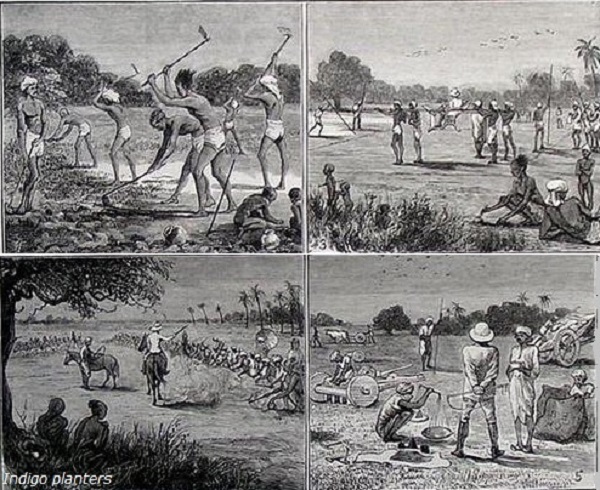
The invention of a synthetic dye gave a big blow to the indigo industry and it gradually declined.
Poverty and Famines
The poverty of the people found its culmination in a series of famines which ravaged all parts of India in the second half of the 19th century.
The first of these famines occurred in Western U.P. in 1860-61 and cost over 2 lakh lives.
In 1865-66, a famine engulfed Orissa, Bengal, Bihar, and Madras and took a toll of nearly 20 lakh lives; Orissa alone lost 10 lakh people.
Perhaps the worst famine in Indian history till then occurred in 1876-78 in Madras, Mysore, Hyderabad, Maharashtra, Western U. P., and Punjab
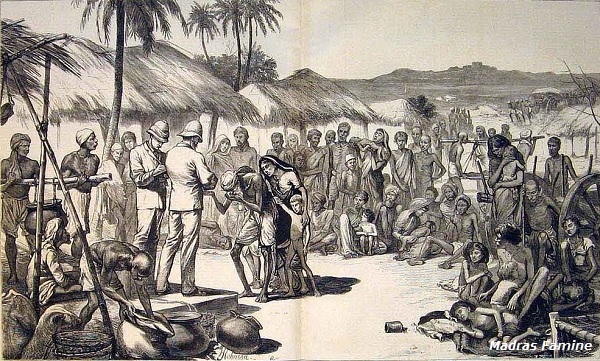
Madras lost nearly 35 lakhs,
Maharashtra lost 8 lakh people,
Mysore lost nearly 20 per cent of its population, and
U. P. lost over 12 lakhs.
The famine of 1896-97 affected over 9.5 crore people of whom nearly 45 lakhs died. The famine of 1899-1900 followed quickly and caused widespread distress.
In spite of official efforts to save lives through the provision of famine relief, over 25 lakh people died.
Apart from these major famines, many other local famines and scarcities occurred. William Digby, a British writer, has calculated that, in all, over 28,825,000 people died during famines from 1854 to 1901.
Another famine in 1943 carried away nearly 3 million people in Bengal.
These famines and the high losses of life in them indicate the extent to which poverty and starvation had taken root in India.
Nationalist Movement (1858-1905)
The second half of the 19th century witnessed the full flowering of the national political consciousness and the growth of an organized national movement in India.
In December 1885, the Indian National Congress was established under whose leadership, Indians waged a prolonged and courageous struggle for independence from foreign rule, which India finally won on 15 August 1947.
Consequence of Foreign Domination
The modem Indian nationalism arose to meet the challenges of foreign domination.
It was British rule and its direct and indirect consequences, which provided the material, moral, and intellectual conditions for the development of a national movement in India.
The Indians realized gradually that their interests were being sacrificed to those of Lancashire manufacturers and other dominant British interests.
The foundations of the Indian nationalist movement lay in the fact that increasingly British rule became the major cause of India's economic backwardness. It became the major barrier to India's further economic, social, cultural, intellectual, and political development.
The peasants saw that the Government took away a large part of his produce as land revenue; that the Government and its machinery – the police, the courts, the officials – favored and protected the zamindars and landlords, who rack-rented them, and the merchants and money- lenders, who cheated and exploited him in diverse way and who took away their land.
The artisans or handicraftsmen saw that the foreign regime had helped foreign competition to ruin them and had done nothing to rehabilitate them.
All these three classes of Indian society—the peasants, the artisans, and the workers, constituting the overwhelming majority of Indian population — discovered that they had no political rights or powers, and that virtually nothing was being done for their intellectual or cultural improvement.
Education did not percolate down to them. There were hardly any schools in villages and the few that were there were poorly run.
Economic exploitation by Britain was swelling India’s poverty. They began to complain of the extreme costliness of the Indian administration, of the excessive burden of taxation especially on the peasantry, of the destruction of India's indigenous industries, of official attempts to check the growth of modern industries through a pro-British tariff policy, of the neglect of nation-building and welfare activities such as education, irrigation, sanitation, and health services.
The Indian intelligentsia suffered from growing unemployment. The few Indians who were educated were not able to find employment and even those who did find jobs discovered that most of the better paid jobs were reserved for the English middle and upper classes, who looked upon India as a special pasture for their sons.
The educated Indians found that the economic and cultural development of the country and its freedom from foreign control alone could provide them with better employment opportunities.
Instead, the Government and its bureaucracy favored foreign capitalists who came to India with their vast resources and appropriated the limited industrial field.
The Indian capitalists were particularly opposed to the strong competition from foreign capitalists. In the 1940's, many of the Indian industrialists demanded that "all British investments in India be repatriated."
In 1945, M.A. Master, President of the Indian Merchants' Chamber warned: "India would prefer to go without industrial development rather than allow the creation of new East India Companies in this country, which would not only militate against her economic independence, but would also effectively prevent her from acquiring her political freedom."
The Indian capitalists, therefore, realized that there existed a contradiction between imperialism and their own independent growth, and that only a national government would create conditions for the rapid development of Indian trade and industries.
Administrative and Economic Unification of India
The British had gradually introduced a uniform and modern system of government throughout the country and thus unified it administratively.
The destruction of the rural and local self-sufficient economy and the introduction of modern trade and industries on an all-India scale had increasingly made India's economic life a single whole and inter-linked the economic fate of people living in different parts of the country. For example, if famine or scarcity occurred in one part of India, prices and availability of foodstuffs were affected in all other parts of the country.
Introduction of the railways, telegraphs, and a unified postal system had brought the different parts of the country together and promoted mutual contact among the people, especially among the leaders.
The anti-imperialist feeling was itself a factor in the unification of the country and the emergence of a common national outlook.
Western Thought and Education
As a result of the spread of modern western education and thought during the 19th century, a large number of Indians imbibed a modern rational, secular, democratic, and nationalist political outlook.
The Indians began to study, admire, and emulate the contemporary nationalist movements of the European nations. Rousseau, Paine, John Stuart Mill, and other western thinkers became their political guides, while Martini, Garibaldi, and Irish nationalist leaders became their political heroes.
The educated Indians were the first to feel the humiliation of foreign subjection. By becoming modern in their thinking, they also acquired the ability to study the evil effects of the foreign rule. They were inspired by the dream of a modern, strong, prosperous, and united India. In a course of time, the best among them became the leaders and organizers of the national movement.
In fact, in the schools and colleges, the authorities tried to inculcate notions of docility and servility to foreign rule. Nationalist ideas were a part of the general spread of modern ideas.
Modern education also created a certain uniformity and community of outlook and interests among the educated Indians. The English language played an important role in this respect. It became the medium for the spread of modern ideas. It also became the medium of communication and exchange of idea, between educated Indians from different linguistic regions of the country.
Political leaders like Dadabhai Naoroji, Sayyid Ahmed Khan, Justice Ranade, Tilak, and Gandhiji agitated for a bigger role for the Indian languages in the educational system.
Role of the Press and Literature
The chief instrument through which the nationalist-minded Indians spread the message of patriotism and modern economic, social, and political ideas and created an all-India consciousness was the press.
In their columns, the official policies were constantly criticized; the Indian point of view was put forward; the people were asked to unite and work for national welfare; and ideas of self-government, democracy, industrialization, etc., were popularized among the people.
Some of the prominent nationalist newspapers of the period were the Hindu Patriot, the Amrita Bazar Patrika, the Indian Mirror, the Bengalee, the Som Prakash and the Sanjivani in Bengal; the Rast Goftar, the Native Opinion, the Indu Prakash, the Mahratta, and the Kesari (in Bombay); the Hindu, the Swadesamitran, the Andhra Prakasika, and the Kerala Patrika (in Madras); the Advocate, the Hindustani, and the Azad (in U. P.); and the Tribune, the AkhbarI-Am, and the Koh-i-Noor (in Punjab).
National literature in the form of novels, essays, and patriotic poetry also played an important role in arousing the national consciousness.
Bankim Chandra Chatterjee and Rabindranath Tagore in Bengali, Lakshminath Bezbarua in Assamese; Vishnu Shastri Chiplunkar in Marathi, Subramanya Bharati in Tamil; Bharatendu Harishchandra in Hindi; and Altaf Husain Hah in Urdu were some of the prominent nationalist writers of the period.
Rediscovery of India's Past
Many Indians had fallen so low as to have lost confidence in their own capacity for self-government.
Many British officials and writers of the time constantly advanced the thesis that Indians had never been able to rule themselves in the past that Hindus and Muslims had always fought one another, that Indians were destined to be ruled by foreigners, that their religion and social life were degraded and uncivilized making them unfit for democracy or even self-government.
Many of the nationalist leaders tried to arouse the self-confidence and selfrespect of the people by countering this propaganda. They pointed to the cultural heritage of India with pride and referred the critics to the political achievements of rulers like Asoka, Chandragupta Vikramaditya, and Akbar.
Unfortunately, some of the nationalists went to the other extreme and began to glorify India's past uncritically ignoring its weakness and backwardness. Great harm was done, in particular, by the tendency to look up only to the heritage of ancient India while ignoring the equally great achievements of the medieval period.
The ignorance of medieval period encouraged the growth of communal sentiments among the Hindus and the counter tendency among the Muslims of looking to the history of the Arabs and the Turks for cultural and historical inspiration.
In meeting the challenge of cultural imperialism of the West, many Indians tended to ignore the fact that in many respects, the people of India were culturally backward.
A false sense of pride and smugness was produced, which tended to prevail Indians from looking critically at their society.
The growth of communal sentiments weakened the struggle against social and cultural backwardness, and led many Indians to turn away from healthy and fresh tendencies and ideas from other people.
Racial Arrogance of Rulers
An important factor in the growth of national sentiments in India was the tone of racial superiority adopted by many Englishmen while dealing with Indians.
Many Englishmen openly insulted even educated Indians. A particularly odious and frequent form taken by racial arrogance was the failure of justice whenever an Englishman was involved in a dispute with an Indian.
The Indian newspapers often published instances in which an Englishmen had hit and killed an Indian but escaped very lightly. This was not only because of conscious partiality by the judges and administrators but even more because of racial prejudice.
Racial arrogance branded all Indians irrespective of their caste, religion, province, or class with the badge of inferiority.
The Indians were kept out of exclusively European clubs and were often not permitted to travel in the same compartment in a train with the European passengers. This made them conscious of national humiliation.
Immediate Factors
By the 1870's, it was evident that Indian nationalism had gathered enough strength and momentum to appear as a major force on the Indian political scene. However, it required the reactionary regime of Lord Lytton to give it visible form and the controversy around the Ilbert Bill gave it an organized form.
During Lytton's viceroyalty from 1876-80, most of the import duties on British textile imports were removed to please the textile manufacturers of Britain. This action was interpreted by Indians as proof of the British desire to ruin the small but growing textile industry of India. It created a wave of anger in the country and led to widespread nationalist agitation.
The Second War against Afghanistan aroused vehement agitation against the heavy cost of this imperialist war, which the Indian Treasury was made to bear.
The Arms Act of 1878, which disarmed the people, appeared to them as an effort to emasculate the entire nation.
The Vernacular Press Act of 1878 was condemned by the politically conscious Indians as an attempt to suppress the growing nationalist criticism of the alien government.
The holding of the imperial Durbar at Delhi in 1877 at a time when the country was suffering from a terrible famine led people to believe that their rulers cared very little even for their lives.
In 1878, the government announced new regulations reducing the maximum age limit for sitting in the Indian Civil Service Examination from 21 years to 19.
Already Indian students had found it difficult to compete with English boys since the examination was conducted in England and through English medium. The new regulations further reduced their chances of entering the Civil Service.
The Indians now realized that the British had no intention of relaxing their near-total monopoly of the higher grades of services in the administration.
Lytton’s viceroyalty helped to intensify discontent against foreign rule.
In 1883, Ripon who succeeded Lytton as the Viceroy, tried to pass a law to enable Indian district magistrates and session judges to trial Europeans in criminal cases.
Under the existing law, even Indian members of the Indian Civil Service were not authorized to try Europeans in their courts.
The Europeans in India organized a vehement agitation against this Bill, which came to be known as Ilbert Bill (after Ilbert, the Law Member).
The Ilbert Bill poured abuse on Indians and their culture and character. They declared that even the most highly educated among the Indians were unfit to trial a European.
Modern Indian History - Predecessors of INC
The Indian National Congress (INC), founded in December 1885, was the first organized expression of the Indian National Movement on an all-India scale. It had, however, many predecessors.
Major Public Associations
Following are the important public associations, established before the Indian National Congress −
The Landholders' Society − founded in 1837, it was an association of the landlords of Bengal, Bihar, and Orissa. Its purpose was to promote the class interests of the landlords.
The Bengal British Indian Society − founded in 1843, it was organized to protect and promote general public interests.
In 1851, the Landholders’ Society and the Bengal British Indian Society merged to form the British India Association.
The Madras Native Association and the Bombay Association were established in 1852.
The Scientific Society founded by Sayyid Ahmad Khan, were established in different towns of the country.
All the above-discussed associations were dominated by wealthy and aristocratic elements — called in those days’ prominent persons and were provincial or local in character.
The members of public associations worked for reform of administration, association of Indians with the administration, and spread of education, and sent long petitions, putting forward Indian demands, to the British Parliament.
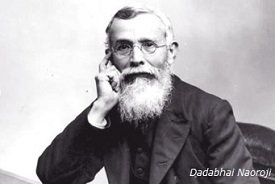
In 1866, Dadabhai Naoroji organized the East India Association in London to discuss the Indian question and to influence British public men to promote Indian welfare. Later he organized branches of the Association in prominent Indian cities.
Born in 1825, Dadabhai Naoroji devoted his entire life to the national movement and soon came to be known as the 'Grand Old Man of India.'
Dadabhai Naoroji was the first economic thinker of India. In his writings on economics, he showed that the basic cause of India’s poverty lay in the British exploitation of India and the drain of its wealth.
Dadabhai was honored by being thrice elected president of the Indian National Congress.
Surendranath Banerjea
Surendranath Banerjea was a brilliant writer and orator. He was unjustly turned out of the Indian Civil Service as his superiors could not tolerate the presence of an independent-minded Indian in the ranks of this service.
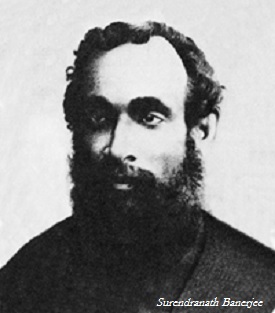
Banerjea began his public career in 1875 by delivering brilliant addresses on nationalist topics to the students of Calcutta.
Led by Surendranath and Anandamohan Bose, the younger nationalists of Bengal founded the Indian Association in July 1876.
The Indian Association set before itself the aims of creating a strong public opinion in the country on political questions and the unification of the Indian people on a common political program.
In order to attract large numbers of people to its banner, the Indian Association fixed a low membership fee for the poorer classes.
The first major issue that the Indian Association took up for agitation was the reform of the Civil Service regulations and the raising of the age limit for its examination.
Surendranath Banerjea toured different parts of the country during 1877-78 in an effort to create an all-India public opinion on this question.
The Indian Association also carried out agitation against the Arms Act and the Vernacular Press Act and in favor of protection of the tenants from oppression by the reminders.
During 1883-85, the Indian Association organized popular demonstrations of thousands of peasants to get the Rent Bill changed in favor of the tenants.
The Indian Association agitated for better conditions of work for the workers in the English-owned tea plantations.
Many branches of the Indian Association were opened in the towns and villages of Bengal and also in many towns outside Bengal.
Some other Important Public Associations were −
Justice Ranade and others organized the Poona Sarvajanik Sabha in the 1870's.
The Madras Mahajan Sabha was started in 1881 and the Bombay Presidency Association in 1885.
The most important of the pre-Congress nationalist organizations was the Indian Association of Calcutta.
The Poona Sarvajanik Sabha brought out a quarterly journal under the guidance of Justice Ranade. This journal became the intellectual guide of new India, particularly on economic questions.
These organizations were mainly devoted to criticism of important administrative and legislative measures.
Indian National Congress
A. O. Hume, a retired English Civil Servant along with prominent Indian leaders founded all-India organization namely the “Indian National Congress.”
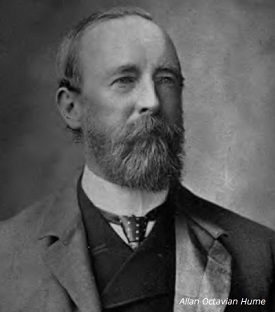
The first session of the Indian National Congress was held at Bombay in December 1885. It was presided by W. C. Bonnerjee and attended by 72 delegates.
Aims of INC
The aims of the National Congress were declared to be −
Promotion of friendly relations among nationalist political workers residing in different parts of the country;
Development and consolidation of the feeling of national unity irrespective of caste, religion, or province;
Formulation of popular demands and their presentation before the Government; and
Training and organization of public opinion in the country.
One of the main aims of Hume in helping to found the National Congress was to provide an outlet i.e. 'a safety valve'—to the increasing popular discontent against British rule.
In 1879, Wasudeo Balwant Phadke, a clerk in the commissariat department, had gathered a band of Ramoshi peasants and started an armed uprising in Maharashtra. Though this crude and an ill-prepared attempt was easily crushed, it was a portent of events to come.
Hume as well as other English officials and statesmen were afraid that the educated Indians might provide leadership to the masses and organize a powerful rebellion against the foreign government. As Hume put it: "A safety valve for the escape of great and growing forces generated by our own action was urgently needed."
Hume believed that the National Congress would provide a peaceful and constitutional outlet to the discontent among the educated Indians and would thus help to avoid the outbreak of a popular revolt.
The National Congress represented the urge of the politically conscious Indians to set up a national organization to work for their political and economic advancement.
In any case, the Indian leaders, who cooperated with Hume in starting this National Congress, were patriotic men of high character who willingly accepted Hume's help as they did not want to arouse official hostility towards their efforts at so early stage of political activity.
Surendranath Banerjea and many other leaders of Bengal had not attended the first session of the National Congress as they were busy with the Second National Conference at Calcutta.
In 1886, Surendranath Banerjea and other leaders of Bengal merged their forces with those of the National Congress whose second session met in Calcutta in December 1886 under the president-ship of Dadabhai Naoroji.
From the Calcutta session, the National Congress became 'the whole country's Congress'. Its delegates, numbering 436, were elected by different local organizations and groups.
The National Congress met every year in December, in a different part of the country.
The number of its delegates soon increased to thousands. Its delegates consisted mostly of lawyers, journalists, traders, industrialists, teachers, and landlords.
In 1890, Kadambini Ganguli, the first woman graduate of Calcutta University addressed the Congress session.
This was symbolic of the fact that India's straggle for freedom would raise Indian women from the degraded position to which they had been reduced for centuries past.
Some of the great presidents of the National Congress during its early years were Dadabhai Naoroji, Badruddin Tyabji, Pherozeshah Mehta, P. Ananda Charlu, Surendranath Banerjea, Ramesh Chandra Dutt, Ananda Mohan Bose, and Gopal Krishna Gokhale.
Modern Indian History - INC & Reforms
Reforms after the Indian National Congress can be studied under the following heads −
Constitutional Reforms
Economic Reforms
Administrative Reforms
Methods of Political Work
Let’s discuss each one of them separately in brief −
Constitutional Reforms
From 1885 to 1892, the nationalist leaders demanded the expansion and reform of the Legislative Councils. They demanded membership of the councils for elected representatives of the people and also an increase in the powers of the councils.
The British Government was forced by their agitation to pass the Indian Councils Act of 1892. By this Act, the number of members of the Imperial Legislative Council as well as of the provincial councils was increased.
Some of the members of Councils could be elected indirectly by Indians, but the officials' majority remained as it is.
The Councils were also given the right to discuss the annual budgets though they could not vote on them.
The nationalists were totally dissatisfied with the Act of 1892 and declared it to be a hoax. They demanded a larger share for Indians in the councils as also wider powers for them. In particular, they demanded Indian control over the public purse and raised the slogan that had earlier become the national cry of the American people during their War of Independence: 'No taxation without representation.’
By the beginning of the 20th century, the nationalist leaders advanced further and put forward the claim for Swarajya or self-government within the British Empire on the model of self-governing colonies like Australia and Canada.
This demand was made from the Congress platform by Gokhale in 1905 and by Dadabhai Naoroji in 1906.
Economic Reforms
Dadabhai Naoroji declared as early as 1881 that British rule was "an everlasting, increasing, and every day increasing foreign invasion" that was "utterly, though gradually, destroying the country."
The nationalists blamed the British for the destruction of India's indigenous Industries. The chief remedy they suggested for the removal of India's poverty was the rapid development of modern industries.
The Indian people made a great effort to popularize the idea of swadeshi or the use of Indian goods and the boycott of British goods as a means of promoting Indian industries.
Students in Poona and in other towns of Maharashtra publicly burnt foreign clothes in 1896 as part of the larger swadeshi campaign.
Indians agitated for improvement in the work conditions of the plantation laborers.
The nationalists declared high taxation to be one of the causes of India's poverty and demanded abolition of the salt tax and reduction of land revenue.
The nationalists condemned the high military expenditure of the Government of India and demanded its reduction.
Administrative Reforms
The most important administrative reform the Indians desired at this time was Indianization of the higher grades of administrative services. They put forward this demand on economic, political, and moral grounds.
Economically, the European monopoly of the higher services was harmful on two grounds −
Europeans were paid at very high rates and this made Indian administration very costly—Indians of similar qualifications could be employed on lower salaries; and
Europeans sent out of India a large part of their salaries and their pensions were paid in England. This added to the drain of wealth from India.
Politically, the nationalists hoped that the Indianization of these (civil) services would make the administration more responsive to Indian needs and hence, they −
Demanded separation of the judiciary from executive powers;
Opposed the curtailment of the powers of the juries;
Opposed the official policy of disarming the people;
Asked the government to trust the people and grant them the right to bear arms and thus defend themselves and their country in times of need;
Urged the government to undertake and develop welfare activities of the state;
Demanded greater facilities for technical and higher education;
Urged the development of agricultural banks to save the peasant from the clutches of the money-lender; and
Demanded extension of medical and health facilities and improvement of the police system to make it honest, efficient, and popular.
Methods of Political Work
The Indian national movement up to 1905 was dominated by leaders who have often been described as moderate nationalists or Moderates.
The political methods of the Moderates can be summed up briefly as constitutional agitation within the four walls of the law and slow orderly political progress.
Moderates believed that if public opinion was created and organized and popular demands presented to the authorities through petitions, meetings, resolutions, and speeches, the authorities would concede these demands gradually and step by step.
In 1889, the British Committee started a journal called ‘India.’
Dadabhai Naoroji spent a major part of his life and income in England in popularizing India’s case among England’s people.
Moderates genuinely believed that the continuation of India's political connection with Britain was in the interests of India at that stage of history. They, therefore, planned not to expel the British but to transform British rule to approximate to national rule.
Later, when Moderates took note of the evils of British rule and the failure of the government to accept nationalist demands for reform, many of them stopped talking of loyalty to British rule and started demanding selfgovernment for India.
From the beginning, many nationalist leaders had no faith in the good intentions of the British. They believed in depending on political action by, and the strength of the Indian people themselves.
Tilak and numerous other leaders and newspaper editors represented the trend, that later came to be known as Extremists or radical nationalists.
Attitude of the Government
The British authorities were from the beginning hostile to the rising nationalist movement and had become suspicious of the National Congress.
The British officials branded the nationalist leaders as 'disloyal babus', 'seditious brahmins' and 'violent villains'.
As the British became apparent that the National Congress would not become a tool in the hands of the authorities, but rather it was gradually becoming a focus of Indian nationalism. British officials now began to criticize and condemn the National Congress and other Rationalist spokesmen openly.
In 1887, Dufferin attacked the National Congress in a public speech and ridiculed it as representing only 'a microscopic minority of the people.’
In 1900; Lord Curzon announced to the Secretary of State, that "the Congress is tottering to its fall, and one of my great ambitions, while in India, is to assist it to a peaceful demise".
The British authorities also pushed further the policy of ‘divide and rule.’ They encouraged Sayyid Ahmed Khan, Raja Shiva Prasad of Benaras, and other proBritish individuals to start an anti-Congress movement.
Some critics say that the nationalist movement and the National Congress did not achieve much success in their early phase; however, it established the political truth that India must be ruled in the interests of the Indians and made the issue of nationalism a dominant one in Indian life.
Religious & Social Reforms
Many Indians realized that social and religious reformation was an essential condition for the all-round development of the country on modern lines and for the growth of national unity and solidarity.
After 1858, the earlier reforming tendency was broadened. The work of earlier reformers, like Raja Ram Mohan Roy and Pandit Vidyasagar, was carried further by major movements of religious and social reform.
Religious Reforms
Filled with the desire to adapt their society to the requirements of the modern world of science, democracy, and nationalism, and determined to let no obstacles stand in the way, thoughtful Indians set out to reform their traditional religions.
Brahmo Samaj
After 1843, the Brahmo tradition founded by Raja Ram Mohan Roy was carried forward by Devendranath Tagore and after 1866 by Keshub Chandra Sen.
Devendranath Tagore repudiated the doctrine that the Vedic scriptures were infallible.
The Brahmo Samaj made an effort to reform Hindu religion by removing abuses, by basing it on the worship of one God and on the teachings of the Vedas and Upanishads, and by incorporating the best aspects of modern western thought.
The Brahmo Samaj denied the need for a priestly class for interpreting religious writings. Every individual had the right and the capacity to decide with the help of his own intellect what was right and what was wrong in a religious book or principle.
The Brahmos were basically opposed to idolatry and superstitious practices and rituals, in fact, the entire Brahmanical system; they could worship one God without the mediation of the priest.
The Brahmos were also great social reformers. They actively opposed the caste system and child-marriage; and supported the general uplift of women, including widow remarriage, and the spread of modern education to men and women.
The Brahmo Samaj was weakened by internal dissentions in the second half of the 19th century.
Religious Reform in Maharashtra
Religious reform was begun in Bombay in 1840 by the Parmahans Mandali, Which aimed at fighting idolatry and the caste system.
The earliest religious reformer in Western India perhaps was Gopal Hari Deshmukh, known popularly as 'Lokahitwadi'. He wrote in Marathi, made powerful rationalist attacks on Hindu orthodoxy, and preached religious and social equality.
Later the Prarthana Samaj was started with the aim of reforming Hindu religious thought and practice in the light of modern knowledge.
It preached the worship of one God and tried to free religion of caste orthodoxy and priestly domination.
Two of its great leaders were R.G. Bhandarkar, the famous Sanskrit scholar and historian, and Mahadev Govind Ranade (1842-1901).
Prarthana Samaj was powerfully influenced by the Brahmo Samaj. Its activities also spread to South India as a result of the efforts of the Telugu reformer, Viresalingam.
Theosophical Society
The Theosophical Society was founded in the United States by Madam H.P. Blavatsky and Colonel H.S. Olcott, who later came to India and founded the headquarters of the Society at Adyar near Madras in 1886.
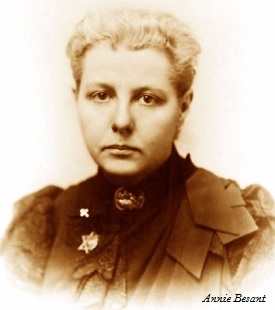
The Theosophist movement soon grew in India as a result of the leadership given to Mrs. Annie Besant who had come to India in 1893.
The Theosophists advocated the revival and strengthening of the ancient religion of Hinduism, Zoroastrianism, and Buddhism.
The Theosophists recognized the doctrine of the transmigration of the soul. They also preached the universal brotherhood of man.
It was a movement led by westerners who glorified Indian religions and philosophical tradition.
Theosophical movement helped Indians to recover their self-confidence, even though it tended to give them a sense of false pride in their past greatness.
One of Mrs. Besant's many achievements in India was the establishment of the Central Hindu School at Banaras which was later developed by Madan Mohan Malaviya into the Banaras Hindu University.
Religious Reform among Muslims
The Mohammedan Literary Society was founded at Calcutta in 1863. This Society promoted discussion of religious, social, and political questions in the light of modern ideas and encouraged upper and middle class Muslims to take to western education.
Religious Reform among Parsis
In 1851, the Rehnumai Mazdayasan Sabha or Religious Reform Association was started by Naoroji Furdonji, Dadabhai Naoroji, S.S. Bengalee, and others.
Religious Reform Association campaigned against the entrenched orthodoxy in the religious field and initiated the modernization of Parsi social customs regarding the education of women, marriage, and the social position of women in general.
Religious Reform among Sikhs
Religious reform among the Sikhs was begun at the end of the 19th century when the Khalsa College was started at Amritsar.
In 1920, the Akali Movement rose in Punjab. The main aim of the Akalis was to purify the management of the gurudwaras or Sikh shrines.
These gurudwaras had been heavily endowed with land and money by devout Sikhs. But they had come to be managed autocratically by corrupt and selfish mahants.
The Sikh masses led by the Akalis started in 1921 a powerful Satyagraha against the mahants and the Government which came to their aid.
The Akalis soon forced the Government to pass a new Sikh Gurudwaras Act in 1922, which was later amended in 1925.
Modern Indian History - Religious Reformers
Following are the significant religious reformers of modern India −
Ramakrishana and Vivekananda
Ramakrishna Parmhansa (1834-1886) was a saintly person who sought religious salvation in the traditional ways of renunciation, meditation, and devotion (bhakti).
Parmhansa, again and again, emphasized that there were many roads to God and salvation and that service of man was service of God, for man was the embodiment of God.
Swami Vivekananda (1863-1902), a disciple of Ramakrishan Parmhansa popularized his religious message and tried to put it in a form that would suit the needs of contemporary Indian society.
Swami Vivekananda said, “Knowledge unaccompanied by action in the actual world in which we lived was useless.”
In 1898, Swami Vivekananda wrote – “For our own motherland a junction of the two great systems, Hinduism and Islam … is the only hope.”
Vivekananda condemned the caste system and the current Hindu emphasis on rituals, ceremonies, and superstitions, and urged the people to imbibe the spirit of liberty, equality, and free thinking.
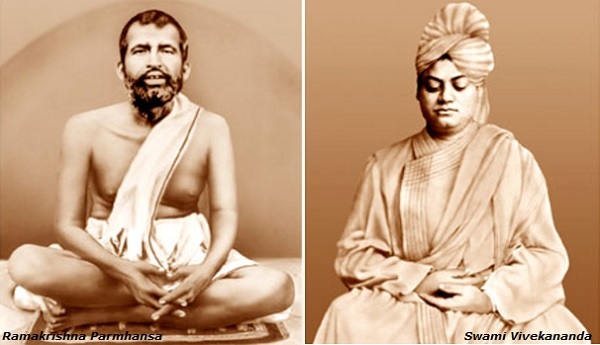
To the educated Indians, Swami Vivekananda said, “So long as the millions live in hunger and ignorance, I hold everyman a traitor who having been educated at their expense, pays not the least heed to them.”
In 1896, Vivekananda founded the Ramakrishna Mission to carry on humanitarian relief and social work.
The Mission had many branches in different parts of the country and carried on social service by opening schools, hospitals, and dispensaries, orphanages, libraries, etc.
Swami Dayanand (Arya Samaj)
Arya Samaj was founded in 1875 by Swami Dayanand Saraswati (1824-1883).
Swami Dayanand believed that selfish and ignorant priests had perverted Hindu religion with the aid of the Puranas, which he said were full of false teachings.
Swami Dayanand rejected all later religious thought if it conflicted with the Vedas. His total dependence on the Vedas and their infallibility gave his teachings an orthodox coloring.
Swami Dayanand was opposed to idolatry, ritual, and priesthood and particularly to the prevalent caste practices and popular Hinduism as preached by brahmins.
Some of Swami Dayanand's followers later started a network of schools and colleges in the country to impart education on western lines; Lala Hansraj played a leading part in this effort.
On the other hand, in 1902, Swami Shradhananda started the Gurukul near Hardwar to propagate the most traditional ideals of education.
Sayyid Ahmad Khan (Aligarh School)
The Mohammedan Literary Society was founded at Calcutta in 1863. This Society promoted discussion of religious, social, and political questions in the light of modern ideas and encouraged upper and middle class Muslims to take to western education.
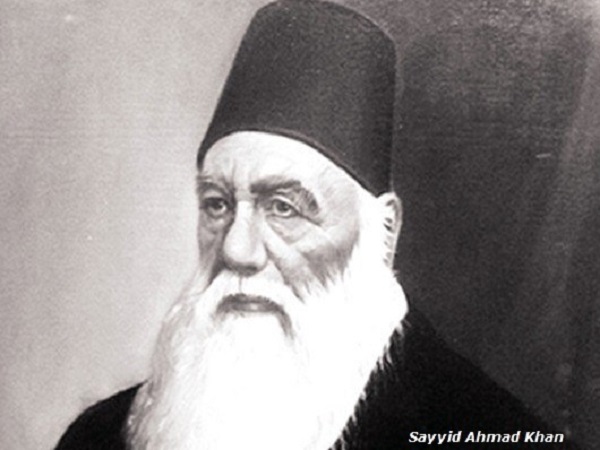
The most important reformer among the Muslims was Sayyid Ahmad Khan (1817-1898). He was tremendously impressed by modern scientific thought and worked all his life to reconcile it with Islam.
Sayyid Ahmad Khan, first of all, declared that the Quran alone was the authoritative work for Islam and all other Islamic writings were secondary.
Sayyid Ahmad Khan urged the people to develop a critical approach and freedom of thought. He said, "so long as freedom of thought is not developed, there can be no civilized life."
He also warned against fanaticism, narrow-mindedness, and exclusiveness, and urged students and others to be broadminded and tolerant. A closed mind, he said, was the hallmark of social and intellectual backwardness.
Therefore promotion of modern education remained his first task throughout his life. As an official, he founded schools in many towns and had many western books translated into Urdu.
In 1875, Sayyid Ahmad Khan founded the Mohammedan Anglo-Oriental College at Aligarh as a center for spreading western sciences and culture. Later, this College grew into the Aligarh Muslim University.
Sayyd Ahmad Khan was a great believer in religious toleration. He believed that all religions had a certain underlying unity, which could be called practical morality. Believing that a person's religion was his or her private affair, he roundly condemned any sign of religious bigotry in personal relations. He was also opposed to communal friction. He appealed to Hindus and Muslims to unite.
Sayyid Ahmad Khan wrote in favor of raising the women's status in society and advocated removal of purdah and spread of education among women. He also condemned the customs of polygamy and easy divorce.
Sayyid Ahmad Khan was helped by a band of loyal followers who are collectively described as the Aligarh School.
Muhammad Iqbal
One of the greatest poets of modern India, Muhammad Iqbal (1876- 1938) also profoundly influenced by his poetry, the philosophical and religious outlook of the younger generation of Muslims as well as of Hindus.
Iqbal was basically a humanist. In fact, he raised human action to the status of a prime virtue.
Women’s Emancipation
Based on the various religious practices and the personal laws, it was assumed that the status of women was inferior to that of men.
After 1880s, when Dufferin hospitals, named after Lady Dufferin (wife of the Viceroy), were started, efforts were made make modern medicine and child delivery techniques available to Indian Women.
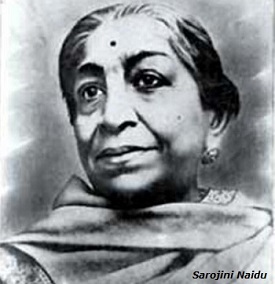
Sarojini Naidu, the famous poetess, became the President of the National Congress in 1925.
In 1937, several women became ministers or parliamentary secretaries.
All India Women's Conference founded in 1927.
Women's struggle for equality took a big step forward after the independence.
Articles 14 and 15 of the Indian Constitution (1950) guaranteed the complete equality of men and women.
The Hindu Succession Act of 1956 made the daughter an equal co-heir with the son.
The Hindu Marriage Act of 1955 permitted dissolution of marriage on specific grounds.
Monogamy has been made mandatory for men as well as women.
The Constitution gives women equal right to work and to get employment in State agencies.
The Directive Principles of the Constitution lay down the principle of equal pay for equal work for both men and women.
Struggle Against Caste
The Hindus were divided into numerous castes (jath). The caste, into which a person was born, determined large areas of his/her life.
The caste system determined whom he/she would marry and with whom he/she would didn’t.
Caste largely determined one’s profession and his social loyalties. The castes were carefully graded into a hierarchy of status.
At the bottom of the ranking, scheduled castes (or untouchables caste) came, they constituted about 20 per cent of the Hindu population.
The untouchables suffered from numerous and severe disabilities and restrictions, which of course varied from place to place. Their touch was considered impure and was a source of pollution.
In some parts of the country, particularly in the South, their shadow was avoided, so that they had to move away if a Brahmin was seen or heard coming.
The scheduled caste could not enter the Hindu temples or study the shartras.
Often scheduled caste’s children could not attend a school in which children of upper caste (of Hindus) studied.
Public services such as the police and other were closed for them.
The untouchables were forced to take up menial and other such jobs which were considered as 'unclean,' for example, scavenging, shoe-making, removing dead bodies, skinning dead animals, tanning hides and skins, etc.
The caste system was an evil in modern times, it became a major obstacle in the growth of a united national feeling and the spread of democracy.
The introduction of modern industries, railways, and buses and growing urbanization made it difficult to prevent mass contact among persons of different castes, especially in the cities.
Modern commerce and industry opened new fields of economic activity to all.
Modern democratic and rationalist ideas spread among Indians and they raised their voice against the caste system.
The Brahma Samaj, the Prarthana Samaj, the Arya Samaj, the Ramakrishna Mission, the Theosophists, the Social Conference, and nearly all the great reforms of the 19th century attacked on the caste system.
The growth of the national movement played a significant role in waning the caste system. The national movement was opposed to all institutions which tended to divide Indian people.
All his life, Gandhi ji kept the abolition of untouchability in the front of his public activities.
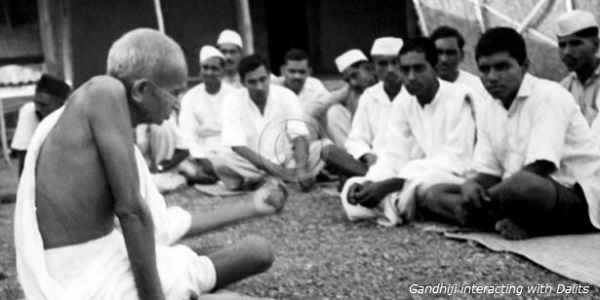
Dr. B. R. Ambedkar, who belonged to one of the scheduled castes, devoted his entire life to fighting against caste tyranny.
Ambedkar organized the “All India Depressed Classes Federation” for the purpose.
In South India, the non-Brahmins organized during the 1920s the “SelfRespect Movement” to fight the disabilities, which Brahmins had opposed.
The Constitution of Independent India has provided the legal framework for the final abolition of untouchability. It has declared that “untouchability” is abolished and its practice in any form is forbidden and punishable.
Nationalist Movement (1905-1918)
Introduction
The Indian national movement in its early days had increasingly made a large number of people conscious of the evils of foreign domination and of the need for fostering patriotism. It had imparted the necessary political training to the educated Indians.
There was a strong demand for more vigorous political action and methods than those of meetings, petitions, memorials, and speeches in the legislative councils.
Recognition of True Nature of British Rule
The politics of the moderate nationalists were founded on the belief that British rule could be reformed from within. But the spread of knowledge regarding political and economic questions gradually undermined this belief.
The nationalist writers and agitators blamed British rule for the poverty of the people. Politically conscious Indians were convinced that the purpose of British rule was to exploit India economically, that is, to enrich England at the cost of India.
The nationalists realized that India could make little progress in the economic field unless British imperialism was replaced by a government controlled and run by the Indian people.
In 1898, a law was passed making it an offence to excite "feelings of disaffection" towards the foreign government.
In 1899, the number of Indian members in the Calcutta Corporation was reduced.
In 1904, the Indian Official Secrets Act was passed restricting the freedom of the press.
The Nathu brothers were deported in 1897 without trial; even the charges against them were not made public.
In 1897, Lokamanya Tilak and other newspaper editors were sentenced to long terms of imprisonment for arousing the people against the foreign government.
The moderate leader Gokhale complained that "the bureaucracy was growing frankly selfish and openly hostile to national aspirations."
The Indian Universities Act of 1904 was seen by the nationalists as an attempt to bring Indian universities under tighter official control and to check the growth of higher education.
Gradually, an increasing number of Indians were getting convinced that selfgovernment was essential for the sake of the economic, political, and cultural progress of the country and that political enslavement meant stunting the growth of the Indian people.
Growth of Self-respect and Self-confidence
By the end of the 19th century, the Indian nationalists had grown in selfrespect and self-confidence. They had acquired faith in their capacity to govern themselves and in the future development of their country.
Tilak and Bipin Chandra Pal preached the message of self-respect and asked the nationalists to rely on the character and capacities of the Indian people.
The nationalists taught the people that the remedy to their sad condition lay in their own hands and that they should, therefore, become fearless and strong.
Swami Vivekananda, though not a political leader, again and again, drove home the message that “If there is a sin in the world it is weakness; avoid all weakness, weakness is sin, weakness is death… and here is the test of truth – anything that makes you weak physically, intellectually and spiritually, reject as poison, there is no life in it, it cannot be true.”
Swami Vivekananda wrote that “The only hope of India is from the masses. The upper classes are physically and morally dead.”
The educated Indians became the best propagators and followers of militant nationalism both because they were low-paid or unemployed and because they were educated in modern thought and politics and European and world history.
Existence of Militant Nationalist School of Thought
From almost the beginning of the national movement a school of militant nationalism had existed in the country. This school was represented by leaders like Rajnarain Bose and Ashwini Kumar Dutt in Bengal and Vishnu Shastri Chiplunkar in Maharashtra.
The most outstanding representative of militant school was Bal Gangadhar Tilak later popularly known as Lokamanya Tilak.
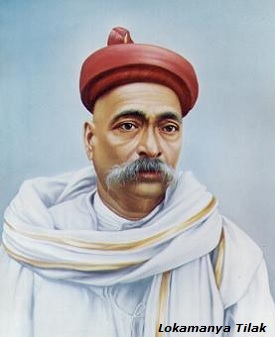
Tilak was born in 1856. From the day of his graduation from the Bombay University, he devoted his entire life to the service of the country.
From 1889, Tilak edited the Kesari and preached nationalism in its columns and taught people to become courageous, self-reliant, and selfless fighters in the cause of India's independence.
In 1893, Tilak started using the traditional religious Ganpati festival to propagate nationalist ideas through songs and speeches, and in 1895, he started the Shivaji festival to stimulate nationalism among young Maharashtrians by holding up the example of Shivaji for emulation.
During 1896-1897, Tilak initiated a ‘no-tax’ campaign in Maharashtra. He asked the famine-stricken peasants of Maharashtra to withhold payment of land revenue if their crops had failed.
Tilak set a real example of boldness and sacrifice when the authorities arrested him in 1897 on the charge of spreading hatred and disaffection against the government. He refused to apologize to the government and was sentenced to 18 months rigorous imprisonment.
Modern Indian History - Partition of Bengal
The conditions for the emergence of militant nationalism had developed when in 1905 the partition of Bengal was announced.
On 20 July 1905, Lord Curzon issued an order dividing the province of Bengal into two parts i.e. Eastern Bengal and Assam with a population of 31 million and the rest of Bengal with a population of 54 million, of whom 18 million were Bengalis and 36 million were Biharis and Oriyas.
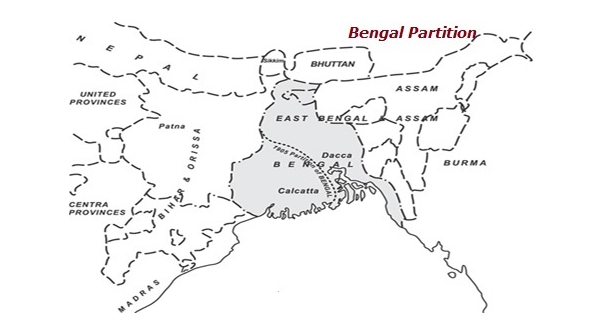
The Indian National Congress and the nationalists of Bengal firmly opposed the partition.
The Anti-Partition Movement was initiated on 7 August 1905. On that day, a massive demonstration against the partition was organized in the Town Hall in Calcutta.
The partition too effect on 16 October 1905. The leaders of the protest movement declared it to be a day of national mourning throughout Bengal.
Swadeshi and Boycott
Mass meetings were held all over Bengal where Swadeshi or use of Indian goods and boycott of British goods were proclaimed and pledged. At many places, public tannings of foreign cloth were organized and shops selling foreign cloth were picketed.
The Swadeshi movement gave a great deal of encouragement to Indian industries. Many textile mills, soap and match factories, handloom weaving concerns, national banks, and insurance companies were opened.
The Swadeshi movement had several consequences in the realm of culture. There was a flowering of nationalist poetry, prose, and journalism.
National educational institutions where literary, technical, or physical education was imparted were opened by nationalists who regarded the existing system of education as denationalizing and, in any case, inadequate.
On 15 August 1906, a National Council of Education was set up. A National College with Aurobindo Ghose as principal was started in Calcutta.
Role of Students, Women, Muslims, and Masses
A noticeable part in the Swadeshi agitation was played by the students of Bengal. They practiced and propagated swadeshi and took the lead in organizing picketing of shops selling foreign cloth. They were perhaps the main creators of the swadeshi spirit in Bengal.
The government made every attempt to suppress the students. Orders were issued to penalize those schools and colleges whose students took an active part in the Swadeshi agitation: their grants-in-aid and other privileges were to be withdrawn.
Many students were fined, expelled from schools and colleges, arrested, and some time beaten by the police. However, students refused to be cowed down.
The traditionally home-centered women of the urban middle classes joined processions and picketing. Likewise, from this time, students were taken an active part in the nationalist movement.
Many prominent Muslims joined the Swadeshi movement including Abdul Rasul, the famous barrister, Liaquat Husain, the popular agitator, and Guznavi, the businessman.
Tilak quickly observed that with the inauguration of this movement in Bengal, a new chapter in the history of Indian nationalism had opened i.e. the challenge and an opportunity to lead a popular struggle against the British Raj and to unite the entire country in one bond of common sympathy.
The Governments of the two Bengals, particularly of East Bengal made active efforts to divide Hindus and Muslims. Seeds of Hindu-Muslim disunity in Bengal politics were perhaps sown at this time, which embittered the nationalists.
As the consequences of Swadeshi movement −
Shouting of ‘Bande Mataram’ in public streets in East Bengal was banned;
Public meetings were restricted and sometimes forbidden;
Laws controlling the press were enacted;
Swadeshi workers were prosecuted and imprisoned for the long periods;
Many students were given corporal punishment;
Prosecutions against a large number of nationalist newspapers were launched and freedom of the press was completely suppressed;
Military police was stationed in many towns where it clashed with the people;
In December 1908, nine Bengal leaders, including the venerable Krishna Kumar Mitra and Ashwini Kumar Dutt were deported;
Earlier in 1907, Lala Lajpat Rai and Ajit Singh had been deported; and
In 1908, the great Tilak was again arrested and given the savage sentence of 6 years imprisonment.
Growth of Revolutionary Terrorism
Government repression and frustration caused by the failure of the political struggle ultimately resulted in revolutionary terrorism.
The Yugantar wrote on 22 April 1906 after the Barisal Conference: "The remedy lies with the people themselves. The 30 crores of people inhabiting India must raise their 60 crores of hands to stop this curse of oppression. Force must be stopped by force."
The revolutionary young men did not try to generate a mass revolution. Instead, they decided to copy the methods of the Irish terrorists and the Russian Nihilists, that is, to assassinate unpopular officials.
In 1897, the Chapekar brothers assassinated two unpopular British officials at Poona.
In 1904, V.D. Savarkar had organized the Abhinava Bharat, a secret society of revolutionaries.
After 1905, several newspapers had begun to advocate revolutionary terrorism. The Sandhya and the Yugantar in Bengal and the Kal in Maharashtra were the most prominent among them.
In April 1908, Khudiram Bose and Prafulla Chaki threw a bomb at a carriage, which they believed was occupied by Kingsford, the unpopular Judge at Muzzaffarpur. Prafulla Chaki shot himself dead while Khudiram Bose was hanged.
Many secret societies of terrorist youth came into existence. The most famous of these was the Anushilan Samiti whose Dacca section alone had 500 branches.
Soon terrorist societies became active in the rest of the country also. They became so bold as to throw a bomb at the Viceroy, Lord Harding, while he was riding on an elephant in a state procession at Delhi. The Viceroy was wounded.
The terrorists also established centers of activity abroad. In London, the lead was taken by Shyamji Krishnavarma, V.D. Savarkar, and Har Dayal, while in Europe Madam Cama and Ajit Singh were the prominent leaders.
The terrorists did make a valuable contribution to the growth of nationalism in India.
Indian National Congress (1905-1914)
After Bengal partition, all sections of the National Congress united in opposing the partition and supported the Swadeshi and Boycott movement of Bengal.
There was much public debate and disagreement between the moderate and the militant nationalists. While the latter wanted to extend the mass movement in Bengal as well as in the rest of the country, the Moderates wanted to confine the movement to Bengal and even there to limit it to Swadeshi and Boycott.
There was a tussle between the militant nationalists and moderates for the president-ship of the National Congress. In the end, Dadabhai Naoroji, respected by all nationalists as a great patriot, was chosen as a compromise.
Dadabhai electrified the nationalist ranks by openly declaring in his presidential address that the goal of the Indian national movement was 'self-government' or Swaraj, like that of the United Kingdom or the colonies.
The split between the two came at the Surat session of the National Congress in December 1907: The moderate leaders having captured the machinery of the Congress excluded the militant elements from it.
In the long run, the split did not prove useful to either party. The moderate leaders lost touch with the younger generation of nationalists.
The British Government played the game of 'Divide and Rule' and tried to win over moderate nationalist opinion so that the militant nationalists could be isolated and suppressed.
To appease the moderate nationalists it announced constitutional concessions through the Indian Councils Act of 1909, which are known as the Morley-Minto Reforms of 1909.
In 1911, the Government also announced the cancellation of the partition of Bengal. Western and eastern Bengals were to be reunited while a new province consisting of Bihar and Orissa was to be created.
In 1911, the seat of the Central Government was moved from Calcutta to Delhi
The Morley-Minto Reforms Increased the number of elected members in the Imperial Legislative Council and the provincial councils. But most of the elected members were elected indirectly, by the provincial councils in the case of the Imperial Council and by municipal committees and district boards in the case of provincial councils. Some of the elected seats were reserved for landlords and British capitalists in India.
Out of the 68 members of the Imperial Legislative Council, 36 were officials and 5 were nominated non-officials.
Of the 27 elected members, 6 were to represent the big landlords and 2 the British capitalists.
The reformed councils still enjoyed no real power, being merely advisory bodies. The reforms in no way changed the undemocratic and foreign character of British rule or the fact of foreign economic exploitation of the country.
The Reforms also introduced the system of separate electorates under which all Muslims were grouped in separate constituencies from which Muslims alone could be elected. This was done for the sake of protecting the Muslim minority. But in reality, this was a part of the policy of dividing Hindus and Muslims and thus maintaining British supremacy in India.
The system of separate electorates was based on the idea that the political and economic interests of Hindus and Muslims were separate. This notion was unscientific because religions cannot be the basis of political and economic interests or of political groupings.
The moderate nationalists did not fully support the Morley-Minto Reforms. They soon realized that the Reforms had really not granted much.
Nationalists and World War I
In June 1914, the First World War broke out between Great Britain, France, Italy, Russia, Japan, and the United States of America on one side and Germany, Austria-Hungary, and Turkey on the other.
In the beginning, the Indian nationalist leaders, including Lokamanya Tilak, who had been released in June 1914, decided to support the war effort of the British Government.
The nationalists adopted an actively pro-British attitude mainly in the mistaken belief that grateful Britain would repay India’s loyalty with gratitude and enable India to take a long step forward on the road to self-government.
Muslim League & Growth of Communalism
Modern political consciousness was late in developing among the Muslims. As nationalism spread among the Hindus and Parsees of the lower middle class, it failed to grow equally rapidly among the Muslims of the same class.
After the suppression of the 1857 Revolt, the British officials had taken a particularly vindictive attitude towards the Muslims, hanging 27,000 Muslims in Delhi alone.
To check the growth of a united national feeling in the country, the British decided to follow more actively the policy of 'Divide and Rule' and to divide the people along religious lines. They encourage communal and separatist tendencies in Indian politics.
The British promoted provincialism by talking of Bengali domination. They tried to utilize the caste structure to turn the non-Brahmins against Brahmins and the lower castes against the higher castes.
In U.P. and Bihar, where Hindus and Muslims had always lived in peace, the British actively encouraged the movement to replace Urdu as a court language by Hindi.
Sayyid Ahmad Khan laid the foundations of Muslim communalism when in the 1880's he gave up his earlier views and declared that the political interests of Hindus and Muslims were not the same but different and even divergent.
Sayyid Ahmad Khan preached complete obedience to British rule. When the Indian National Congress was founded in 1885, he decided to oppose it and tried to organize along with Raja Shiva Prasad of Varanasi a movement of loyalty to British rule.
Sayyid Ahmad Khan urged the Muslims not to listen to Badruddin Tyabji’s appeal to join the National Congress.
Sayyid Ahmed Khan and others raised the demand for special treatment for the Muslims in the matter of government services.
Bombay was the only province where the Muslims had taken to commerce and education quite early; and the Nationalist Congress included in its ranks such brilliant Muslims as Badruddin Tyabji, R.M. Sayani, A. Bhhimji, and the young barrister Muhammad Ali Jinnah.
In his presidential address to the National Congress of 1886, Dadabhai had given the clear assurance that the Congress would take up only national questions and would not deal with religious and social matters.
In 1889, the Congress adopted the principle that it would not take up any proposal which was considered harmful to the Muslims by a majority of the Muslim delegates to the Congress.
Many Hindus began to talk of Hindu nationalism and many Muslims of Muslim nationalism.
The politically immature people failed to realize that their economic, educational, and cultural difficulties were the result of common subjection to foreign rule and of economic backwardness and that only through common effort they could free their country, develop it economically, and thus solve the underlying common problems, such as unemployment and poverty.
In 1906, the All India Muslim League was founded under the leadership of the Aga Khan, the Nawab of Dacca, and Nawab Mohsin-ul-Mulk.
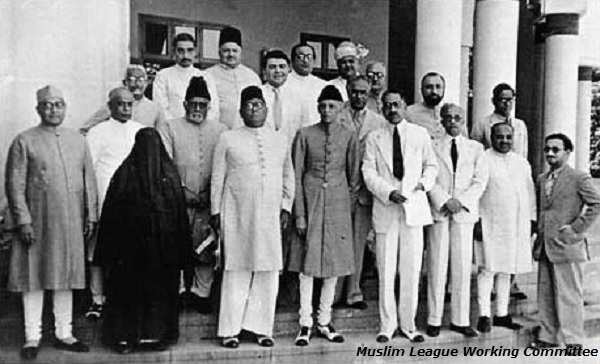
The Muslim League supported the partition of Bengal and demanded special safeguards for the Muslims in government services.
To increase its usefulness, the British also encouraged the Muslim League to approach the Muslim masses and to assume their leadership.
The educated Muslim young men were, in particular, attracted by radical nationalist ideas.
The militant nationalist Ahrar movement was founded at this time under the leadership of Maulana Mohammed Ali, Hakim Ajmal Khan, Hann Imam, Maulana Zafar Ali Khan, and Mazhar-ut-Haq. These young men disliked the loyalist politics of the Aligarh school and the big nawabs and zamindars. Moved by modern ideas of self-government, they advocated active participation in the militant nationalist movement.
Maulana Abul Kalam Azad, Maulana Mohammed Ali and other young men preached a message of courage and fearlessness and said that there was no conflict between Islam and nationalism.
Modern Indian History - Home Rule Leagues
Two Home Rule Leagues were started in 1915-16, one under the leadership of Annie Besant, and S. Subramaniya Iyer.
The two Home Rule Leagues carried out intense propaganda all over the country in favor of the demand for the grant of Home Rule or self-government to India after the War.
It was during Home Rule agitation, Tilak gave the popular slogan i.e. “Home Rule is my birth-right, and I will have it.”
The war period also witnessed the growth of the revolutionary movement, as the terrorist groups spread from Bengal and Maharashtra to the whole of northern India.
Indian revolutionary in the United States of America and Canada had established the “Ghadar (Rebellion) Party in 1913.”
Most of the members of Ghadar Party were Sikh peasants and soldiers, but their leaders were mostly educated Hindus or Muslims.
Ghadar Party had active members in some other countries as well including Mexico, Japan, China, Philippines, Malaya, Singapore, Thailand, East and South Africa.
The Ghadar Party was pledged to wage a revolutionary war against the British in India.
As soon as the First World War I broke out in 1914, the Ghadarites decided to send arms and men to India to start an uprising with the help of soldiers and local revolutionaries.
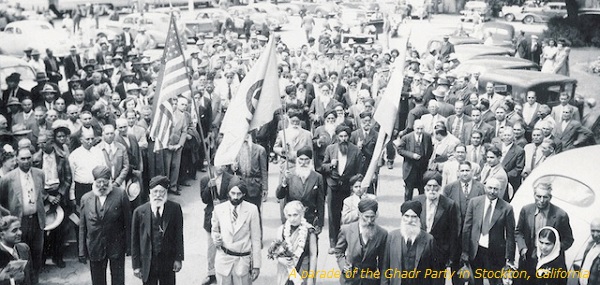
Several thousand men volunteered to come back to India. Millions of dollars were contributed to pay for their expenses. Many gave their life-long savings and sold their lands and other property.
The Ghadarites also contacted Indian soldiers in the Far East, South-East Asia, and all over India and persuaded several regiments to rebel.
21 February 1915 was fixed as the date for an armed revolt in the Punjab. Unfortunately, the British authorities came to know of Ghadarites’ plans and took immediate action.
The rebellious regiments were disbanded and their leaders were either imprisoned or hanged. For example, 12 men of the 23rd Cavalry were executed. The leaders and members of the Ghadar Party in the Punjab were arrested on a mass scale.
42 of arrested men were hanged, 114 were transported for life, and 93 were sentenced to long terms of imprisonment.
Many of the Ghadarites, after their release, founded the Kirti and Communist movements in the Punjab. Some of the prominent Ghadar leaders were: Baba Gurmukh Singh, Kartar Singh Saraba, Sohan Singh Bhakna, Rahmat Ali Shah, Bhai Parmanand, and Mohammad Barkatullah.
Inspired by the Ghadar Party, 700 men of the 5th Light Infantry at Singapore revolted under the leadership of Jamadar Chisti Khan and Subedar Dundey Khan. They were crushed after a bitter battle in which many died. Thirty-seven others were publicly executed, while 41 were transported for life.
In 1915, during an unsuccessful revolutionary attempt, Jatin Mukerjea popularly known as 'Bagha Jatin’ died while fighting a battle with the police at Balasore.
Rash Bihari Bose, Raja Mahendra Pratap, Lala Hardayal, Abdul Rahim, Maulana Obaidullah Sindhi, Champak Raman Pillai, Sardar Singh Rana, and Madam Cama were some of the prominent Indians who carried on revolutionary activities and propaganda outside India.
Congress Lucknow Session
The nationalists soon saw that disunity in their ranks was injuring their cause and that they must put up a united front.
Urge for the unity produced two historic developments at the Lucknow Session of the Indian national Congress in 1916: i.e.
The two wings i.e. Indian National Congress and Muslim League united, as their split had not benefited either group; and
The Congress and the All Indian Muslim league put up a common political demands.
An important role in bringing the moderates and extremists together was played by Lokamanya Tilak.
The British felt necessary to appease the nationalists; therefore, they heavily relied on repression to quieten the nationalist agitation. Large numbers of radical nationalists and revolutionaries had been jailed or interned under the notorious Defence of India Act and other similar regulations.
Modern Indian History - Struggle for Swaraj
Introduction
To win popular support for their war effort, the Allied nations – Britain, the United States, France, Italy, and Japan, promised a new era of democracy and national self-determination to all the peoples of the world; but after their victory, they showed little willingness to end the colonial system.
Nationalism had gathered its forces and the nationalists were expecting major political gains after the war; and they were willing to fight back if their expectations were thwarted.
The economic situation in the post-war years had taken a turn for the worse. There was first a rise in prices and then a depression in economic activity.
The Indian industries, which had prospered during the war because foreign imports of manufactured goods had ceased, now faced losses and closure.
The Indian industrialists wanted protection of their industries through imposition of high customs duties and grant of government aid; they realized that a strong nationalist movement and an independent Indian Government alone could secure their demands.
The workers, facing unemployment and high prices and living in great poverty, also turned actively towards the nationalist movement.
Indian Soldiers, returned with their triumphs from Africa, Asia, and Europe, imparted some of their confidence and their knowledge of the wide world to the rural areas.
The peasantry, groaning under deepening poverty and high taxation, was waiting for a lead. On the other hand, the urban educated Indians were dissented because of increasing unemployment.
A major impetus to the national movements was given by the impact of the Russian Revolution.
On 7 November 1917, the Bolshevik (Communist) Party, led by V.I. Lenin, overthrew the Czarist regime in Russia and declared the formation of the first socialist state, the Soviet Union, in the history of the world.
The Russian Revolution gave people self-confidence and indicated to the leaders of the national movement that they should rely on the strength of the common people.
The Government, aware of the rising tide of nationalist and anti-government sentiments, once again decided to follow the policy of the 'carrot and the stick,' in other words, of concessions and repression.
Montagu-Chelmsford Reforms
In 1918, Edwin Montagu, the Secretary of State, and Lord Chelmsford, the Viceroy, produced their scheme of constitutional reforms which led to the enactment of the Government of India Act of 1919.
Government of India Act
Major provisions of Government of India Act of 1919 were −
The Provincial Legislative Councils were enlarged and the majority of their members were to be elected.
The provincial governments were given more powers under the system of Diarchy.
Under the Diarchy system, auditory subjects, such as finance and law and order, were called 'reserved' subjects and remained under the direct control of the Governor; others such as education, public health, and local selfgovernment, were called 'transferred' subjects and were to be controlled by ministers responsible to the legislatures.
The Governor retained complete control over the finances. The Governor could, moreover, overrule the ministers on any grounds that he considered special.
At the center, there were to be two houses of legislature i.e.
The lower house, the Legislative Assembly, was to have 41 nominated members in a total strength of 144.
The upper house, the Council of State, was to have 26 nominated and 34 elected members.
The legislature had virtually no control over the Governor-General and his Executive Council. On the other hand, the Central Government had unrestricted control over the provincial governments and the right to vote was severely restricted.
Indian nationalists had, however, advanced far beyond such halting concessions. They were no longer willing to let an alien government decide their fitness for self-government, nor would they be satisfied with the shadow of political power.
The Indian National Congress met in a special session at Bombay in August 1918 under the president-ship of Hasan Imam to consider the reform proposals. It condemned them as "disappointing and unsatisfactory” - and demanded effective self-government instead.
The Rowlatt Act
In March 1919, the British Government passed the Rowlett Act even though every single Indian member of the Central Legislative Council opposed it. Three of them, Mohammed Ali Jinnah, Madan Mohan Malaviya, and Mazhar-ul-Huq resigned their membership of the Council.
This Act authorized the Government to imprison any person without trial and conviction in a court of law.
The Act would thus also enable the Government to suspend the right of Habeas Corpus which had been the foundation of civil liberties in Britain.
The Rowlett Act came like a sudden blow. To the people of India, promised extension of democracy during the war, the government step appeared to be a cruel joke.
People felt humiliated and were filled with anger. Unrest spread in the country and a powerful agitation against the Act arose.
During this agitation, Mohandas Karamchand Gandhi, took command of the nationalist movement.
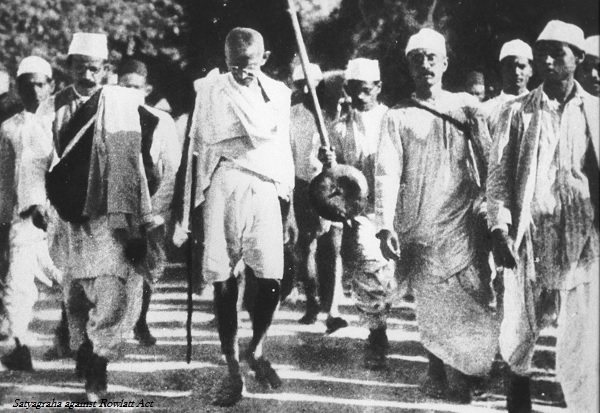
Gandhiji planned for a “Satyagraha” against the Rowlatt Act. In 1919, a Satyagraha Sabha was formed and 6 April was fixed as the date to launch Satyagraha.
Mahatma Gandhi Assumes Leadership
Mohandas Karamchand Gandhi was born on 2 October 1869 at Porbandar in Gujarat.
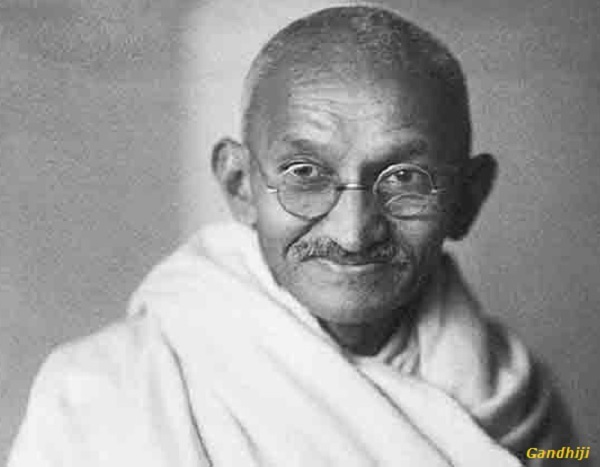
After attaining his legal education in Britain, Gandhiji went to South Africa to practice law.
Imbued with a high sense of justice, Gandhiji was revolted by the injustice, discrimination, and degradation to which Indians had to submit in the South African colonies.
Indian laborers who had gone to South Africa, and the merchants who followed were denied the right to vote. They had to register and pay a poll-tax. They could not reside except in prescribed locations, which were insanitary and congested.
In some of the South African colonies, the Asians, also the Africans, could not stay out of door after 9 p.m.; nor could they use public footpaths.
Gandhi soon became the leader of the struggle against these conditions and during 1893-94 was engaged in a heroic though unequal struggle against the racist authorities of South Africa.
It was during this long struggle lasting nearly two decades that Gandhiji evolved the technique of Satyagraha based on truth and non-violence.
The ideal satyagrahi was to be truthful and perfectly peaceful, but at the same time, Gandhiji would refuse to submit to what he considered wrong. He would accept suffering willingly in the course of struggle against the wrong-doer. This struggle was to be part of his love of truth.
In a famous article in his weekly journal, Young India, published in 1920, Gandhiji wrote that "Non-violence is the law of our species, as violence is the law of the brute", but that "where there is only a choice between cowardice and violence, I would advise violence ....."
Gandhiji returned to India in 1915 at the age of 46. He was keen to serve his country and his people.
In 1916, Gandhi founded the Sabarmati Ashram at Ahmedabad where his friends and followers were to learn and, practice the ideals of truth and nonviolence.
Champaran Satyagraha (1917)
Gandhi's first great experiment in Satyagraha came in 1917 in Champaran, a district in Bihar.
In Champaran, the peasants of the indigo plantations were excessively oppressed by the European planters. They were compelled to grow indigo on at least 3/20th of their land and to sell it at prices fixed by the planters.
Similar conditions had prevailed earlier in Bengal, but as a result of a major uprising during 1859-61 the peasants there had won their freedom from the indigo planters.
Having heard of Gandhi's campaigns in South Africa, several peasants of Champaran invited him to come and help them.
Accompanied by Baba Rajendra Prasad, Mazhar-ul-Huq, J. B. Kripalani, and Mahadev Desai, Gandhiji reached Champaran in 1917 and began to conduct a detailed inquiry into the condition of the peasants.
The infuriated district officials ordered him to leave Champaran, but he defied the order and was willing to face trial and imprisonment. This forced the Government to cancel its earlier order and to appoint a committee of inquiry on which Gandhi served as a member.
Ultimately, the disabilities from which the peasantry was suffering were reduced and Gandhi had won his first battle of civil disobedience in India.
Ahmedabad Mill Strike
In 1918, Mahatma Gandhi intervened in a dispute between the workers and mill owners of Ahmedabad.
Gandhiji undertook a fast unto death to force a compromise. The mill owners relented on the fourth day and agreed to give the workers 35 per cent increase in wages.
Gandhiji also supported the peasants of Khaira in Gujarat in their struggle against the collection of land revenue when their crops had failed.
Sardar Vallabhbhai Patel left his lucrative practice at the Bar at this time to help Gandhiji.
These experiences (discussed above) brought Gandhiji in close contact with the masses whose interests he actively exposed all his life.
Gandhiji was the first Indian nationalist leader who identified his life and his manner of living with the life of the common people.
The following issues were very close to Gandhi's heart −
Hindu-Muslim unity;
The fight against untouchability; and
The raising of the social status of women in the country.
Satyagraha Against Rowlett Act
Along with other nationalists, Gandhiji was also aroused by the Rowlett Act.
In February 1919, he founded the Satyagraha Sabha whose members took a pledge to disobey the Act.
Gandhiji asked the nationalist workers to go to the villages. That is where India lives, he said.
Gandhiji increasingly turned the face of nationalism towards the common man and the symbol of this transformation was to be null, or hand-spun and handwoven cloth, which soon became the uniform of the nationalists.
Gandhiji emphasized on the dignity of labor and the value of self-reliance. India's salvation would come, he said, when the masses were wakened from their sleep and became active in politics.
March and April 1919 witnessed a remarkable political awakening in India. There were hartals (strikes) and demonstrations. The slogans of Hindu-Muslim unity filled the air. The entire country was electrified. The Indian people were no longer willing to submit to the degradation of foreign rule.
Jallianwalla Bagh Massacre
Gandhiji gave a call for a mighty hartal on 6 April 1919. The people responded with unprecedented enthusiasm.
The Government decided to meet the popular protest with repression, particularly in the Punjab.
An unarmed but large crowd had gathered on 13 April 1919 at Jallianwalla Bagh to protest against the arrest of their popular leaders, Dr. Saifuddin Kitchlew and Dr. Satyapal.
Jallianwala Bagh (located in Amritsar, Punjab) was a large open space which was enclosed on three sides by buildings and had only one exit.
General Dyer surrounded the Bagh (garden) with his army until closed the exit with his troops, and then ordered his men to shoot onto the trapped crowd.
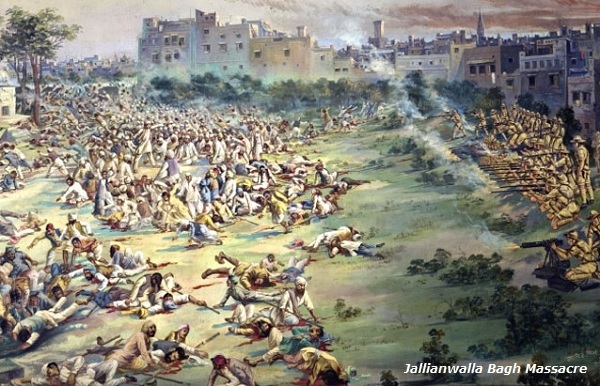
They fired till their ammunition was exhausted. Thousands were killed and wounded.
After this massacre, martial law was proclaimed throughout the Punjab and the people were submitted to most uncivilized atrocities.
Khilafat & Non-Cooperation Movement
The politically-conscious Muslims were critical of the treatment meted out to the Ottoman (or Turkish) Empire by Britain and its allies who had partitioned it and taken away Thrace from Turkey proper.
This was in violation of the earlier pledge of the British Premier, Lloyd George, who had declared: "Nor are we fighting to deprive Turkey of the rich and renowned lands of Asia Minor and Thrace which are predominantly Turkish in race."
The Muslims also felt that the position of the Sultan of Turkey, who was also regarded by many as the Caliph or the religious head of the Muslims, should not be undermined.
A Khilafat Committee was soon formed under the leadership of the Ali brothers, Maulana Azad, Hakim Ajmal Khan, and Hasrat Mohani, and a countrywide agitation was organized.
The All-India Khilafat Conference held at Delhi in November 1919, decided to withdraw all cooperation from the Government if their demands were not met.
The Muslim League, now under the leadership of nationalists, gave full support to the National Congress and its agitation on political issues.
The Congress leaders, including Lokamanya Tilak and Mahatma Gandhi, viewed the Khilafat agitation as a golden opportunity for cementing Hindu-Muslim unity and bringing the Muslim masses into the national movement.
The Congress leaders realized that different sections of the people—Hindus, Muslims, Sikhs and Christians, capitalists and workers, peasants and artisans, women and youth, and tribes and peoples of different regions—would come into the national movement through the experience of fighting for their own different demands and seeing that the alien regime stood in opposition to them.
In June 1920, an all-party conference met at Allahabad and approved a program of boycott of schools, colleges, and law courts.
The Khilafat Committee launched a non-cooperation movement on 31 August 1920.
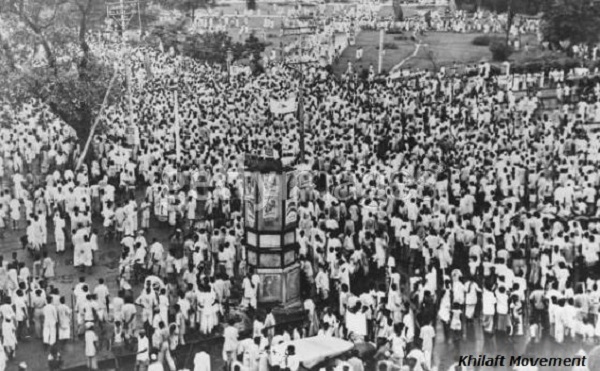
The Congress met in special session in September 1920 at Calcutta. Only a few weeks earlier it had suffered a grievous loss—Lokamanya Tilak had passed away on 1 August at the age of 64.
The Congress supported Gandhi's plan for non-cooperation with the Government till the Punjab and Khilafat wrongs were removed and Swaraj established.
“The British people will have to beware,” declared Gandhiji at Nagpur, that if they do not want to do justice, it will be the bounden duty of every Indian to destroy the Empire.
The Nagpur session also made changes in the constitution of the Congress. Provincial Congress Committees were reorganized on the basis of linguistic areas.
Congress membership was thrown open to all men and women of the age of 21 or more on payment of 4 annas as annual subscription. However, in 1921, the age limit for membership was reduced to 18.
The years 1921 and 1922 witnessed an unprecedented movement of the Indian people. Thousands of students left government schools and colleges and joined national schools and colleges.
Hundreds of lawyers, including Chittaranjan Das (popularly known as Deshbandhu), Motilal Nehru, and Rajendra Prasad, gave up their legal practice.
The Tilak Swarajya Fund was started to finance the non-cooperation movement and within six months, over crore of rupees were subscribed.
Women showed great enthusiasm and freely offered their jewelry.
Huge bonfires of foreign cloth were organized all over the land.
Khadi soon became a symbol of freedom.
In July 1921, the All-India Khilafat Committee passed a resolution declaring that no Muslim should serve in the British Indian army.
In September, the Ali brothers were arrested for 'sedition'. Immediately, Gandhiji gave a call for repetition of this resolution at hundreds of meetings.
Fifty members of the All India Congress Committee issued a similar declaration that no Indian should serve the government which degraded India socially, economically, and politically.
By the end of 1921, all important nationalist leaders, except Gandhiji, were behind the bar along with 3,000 others.
In November 1921, huge demonstrations greeted the Prince of Wales, heir to the British throne, during his tour of India. He had been asked by the Government to come to India to encourage loyalty among the people and the princes.
In Bombay, the Government tried to suppress the demonstration by killing 53 persons and wounding about 400 or more.
The annual session of the Congress, meeting at Ahmedabad in December 1921, passed a resolution affirming "the fixed determination of the Congress to continue the program of non-violent non-cooperation with greater vigor than hitherto ….till the Punjab and Khilafat wrongs were redressed and Swarajya is established."
The resolution urged all Indians, and in particular students, "quietly and without any demonstration to offer themselves for arrest by belonging to the volunteer organizations."
All such Satyagrahis were to take a pledge to "remain non-violent in word and deed to promote unity among Hindus, Muslims, Sikhs, Parsis, Christians, and Jews, and to practice swadeshi and wear only khadi.
In Malabar (Northern Kerala), the Moplahs, or Muslim peasants, created a powerful anti-zamindar movement.
The Viceroy wrote to the Secretary of State in February 1919 that "The lower classes in the towns have been seriously affected by the non-cooperation movement.
On 1 February 1922, Mahatma Gandhi announced that he would start mass civil disobedience, including non-payment of taxes, unless within seven days the political prisoners were released and the press freed from government control.
Withdrawal of Civil Disobedience Movement
On 5 February 1922, a Congress procession of 3,000 peasants at Chauri Chaura, a village in the Gorakhpur District of U.P., was fired upon by the police. The angry crowd attacked and burnt the police station causing the death of 22 policemen.
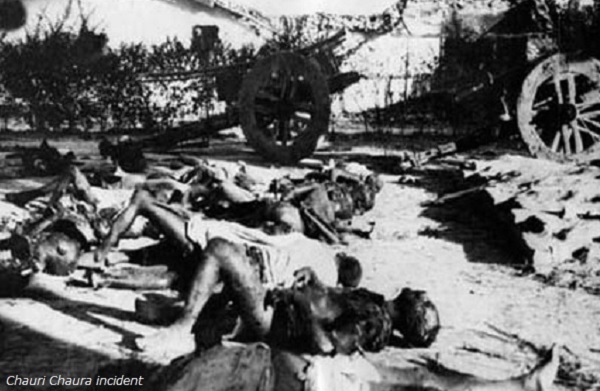
Gandhiji took a very serious view of Chauri Chaura incident. It convinced him that the nationalist workers had not yet properly understood nor learnt the practice of non-violence without which, he was convinced, civil disobedience could not be a success.
Apart from the fact that Gandhiji would have nothing to do with violence, he also perhaps believed that the British would be able to crush easily a violent movement, for people had not yet built up enough strength and stamina to resist government repression.
Gandhiji, therefore, decided to suspend the nationalist campaign. The Congress Working Committee met at Bardoli in Gujarat on 12 February and passed a resolution stopping all activities, which would lead to breaking of laws.
The Bardoli resolution stunned the country and had a mixed reception among the nationalists, while some had implicit faith in Gandhiji, others resented this decision to retreat.
The first non-cooperation and civil disobedience movement virtually came to an end.
The Government arrested Mahatma Gandhiji on 10 March and charged him with spreading disaffection against the Government. Gandhiji was sentenced to six years imprisonment.
End of Khilafat Agitation
Very soon the Khilafat, question also lost relevance. The people of Turkey rose up under the leadership of Mustafa Kamal Pasha and, in November 1922, deprived the Sultan of his political power.
Kamal Pasha took many measures to modernize Turkey and to make it a secular state. He abolished the Caliphate (or the institution of the Caliph) and separated the state from religion by eliminating Islam from the Constitution.
Kamal Pasha nationalized education, granted women extensive rights, introduced legal codes based on European models, and took steps to develop agriculture and to introduce modern industries. All these steps broke the back of the Khilafat agitation.
In December 1922, Chittaranjan Das and Motilal Nehru formed the Congress-Khilafat Swaraj Party; Das as president and Motilal Nehru as one of the secretaries.
The communal elements took advantage of the situation to propagate their views and after 1923, the country was repeatedly plunged into communal riots.
The Muslim League and the Hindu Mahasabha, which was founded in December 1917, once again became active. The result was that the growing feeling that all people were Indians first received a set-back.
The Swarajist Party, whose main leaders, Motilal Nehru and Das, were staunch nationalists, was split by communalism.
A group known as “responsivists” including Madan Mohan Malviya, Lala Lajpat Rai, and N. C. Kelkar, offered cooperation to the Government so that the socalled Hindu interests might be safeguarded.
In September 1924, Gandhiji went on 21 days fast at Maulana Mohammed Ali’s house in Delhi to do penance for the inhumanity revealed in the communal riots. But his efforts were of little avail.
Second Non-Cooperation Movement
Introduction
Socialist and Communist groups came into existence in the 1920s. M. N. Roy became the first Indian elected to the leadership of the Communist International.
In 1924, the Government arrested Muzaffer Ahmed and S. A. Dange, accused them of spreading Communist ideas, and filed a case against them along the others involved in the Kanpur Conspiracy case.
In 1928, under the leadership of Sardar Vallabhbhai Patel, the peasants organized a “No Tax Campaign” and won their demand.
The trade unionism had grown during the early 1920s under the leadership of the All India Trade Union Congress.
All India Trade Union Congress was established in October 1920 at Bombay.
Resurgence of Terrorist Movement
The failure of the first non-cooperation movement had led to the revival of the terrorist movement. Therefore, after an All India Conference, the Hindustan Republican Association was founded in October 1924 to organize an armed revolution.
The terrorists soon came under the influence of socialist ideas; in 1928, under the leadership of Chandra Shekhar Azad, changed the title of the organization from the “Hindustan Republican Association” to the “Hindustan Socialist Republican Association.”
Bhagat Singh and B.K. Dutt threw a bomb in the Central Legislative Assembly on 8 April 1929 to protest against the passage of the Public Safety Bill, which would have reduced civil liberties.
The bomb did not harm anyone, as it had been deliberately made harmless. The aim was not to kill but, as a terrorist leaflet put it, “to make the deaf hear.”
Bhagat Singh and B. K. Dutt could have easily escaped after throwing the bomb, but they deliberately chose to be arrested for they wanted to make use of the court as a forum for revolutionary propaganda.
In April 1930, a raid was manipulated on the government armory at Chittagong under the leadership of Surya Sen.
The remarkable aspect of the terrorist movement in Bengal was the participation of young women.
To protest against the horrible conditions in the prisons, Jatin Das sat on hunger strike; as a result of which, he attained martyrdom after 63 days of epic fast.
In spite of huge protests, Bhagat Singh, Sukhdev, and Rajguru were executed on 23 March 1931.
In February, 1931, Chandra Shekhar Azad was killed in a shooting encounter with the police in a public park; later this park renamed as Azad Park (located at Allahabad in Uttar Pradesh).
Surya Sen was arrested in February 1933 and hanged soon after.
In March 1929, thirty-one prominent trade union and communist leaders (including three Englishmen) were arrested and after a trial (known as Meerut Conspiracy Case) lasting four years, sentenced for long periods of imprisonment.
Boycott of Simon Commission
In November 1927, the British Government appointed the Indian Statutory Commission to work on the constitutional reform, named as ‘Simon Commission,’ after the name of its Chairman John Simon.
All members of the Simon Commission were Englishmen, which was unanimously protested by all Indians.
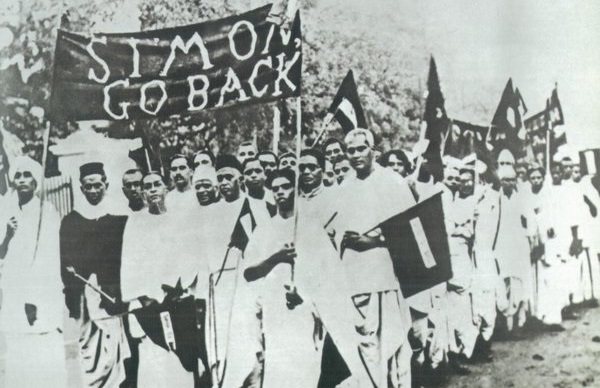
At its Madras Session in 1927, presided over by Dr. Ansari, the National Congress decided to boycott the Simon Commission “at every stage and in every form.”
On February 3, 1928, the day the Simon Commission reached Bombay, an all India strike was proclaimed. Wherever the Commission went, it was greeted with strikes and black-flag demonstrations under the slogan ‘Simon Go Back.’
Nehru Report
An All Parties Conference was convened for the purpose first at Delhi and then at Poona. The Conference appointed a sub-committee headed by Motilal Nehru and included among its members Ali Imam, Tej Bahadur Sapru, and Subhash Bose.
In August 1928, the sub-committee submitted its report known as the “Nehru Report.”
The Nehru Report recommended that
The attainment of Dominion Status should be considered the "next immediate step;"
India should be a federation built on the basis of linguistic provinces and provincial autonomy;
The executive should be fully responsible to the legislature;
The elections should be by joint electorates and on the basis of adult suffrage; and
The seats in the legislatures should be reserved for religious minorities for a period of 10 years.
Unfortunately, the All Party Convention, held at Calcutta in December 1928, failed to pass the Nehru Report.
Objections were raised by some of the communal-minded leaders belonging to the Muslim League, the Hindu Mahasabha and the Sikh League.
The Muslim League was itself split on the issue along nationalist and communal lines. Mohammed Ali Jinnah put forth his "fourteen points" demands at this time, claiming, among other things −
Separate electorates;
One third of the seats in the central legislature for the Muslims;
Reservation of seats for the Muslims in Bengal and the Punjab in proportion to population; and
The vesting of residual powers in the provinces.
The Hindu Mahasabha denounced the Nehru Report as pro-Muslim. Thus the prospects of national unity were foiled by communal groups.
Civil Disobedience Movement II
Gandhiji came back to active politics and attended the Calcutta session of the Congress in December 1928.
Jawaharlal Nehru was now made the President of the Congress at the historic Lahore session of 1929. This event had its romantic side, as son had succeeded his father (i.e. Motilal Nehru, father of Jawaharlal Nehru was President of the Congress in 1928).
The Lahore session of the Congress gave voice to the new, militant spirit. It passed a resolution declaring Poorna Swaraj (Full Independence) to be the Congress objective.
On December 31, 1929, a newly adopted tri-color flag of freedom hoisted and 26 January, 1930 was fixed as the first Independence Day, which was to be so celebrated every year with the people taking the pledge that it was “a crime against man and God to submit any longer” to British rule.
Second Civil Disobedience Movement
The Second Civil Disobedience Movement was started by Gandhiji on March 12, 1930 with his famous Dandi March.
Together with 78 chosen followers, Gandhiji walked nearly 200 miles from Sabarmati Ashram to Dandi, a village on the Gujarat sea-coast. Here Gandhiji and his followers made salt in violation of the salt laws.
The act of making salt was a symbol of the Indian people's refusal to live under British-made laws or under the British rule.
The movement now spread rapidly. Everywhere in the country, people joined strikes, demonstrations, and the campaign to boycott foreign goods and to refuse to pay taxes.
The movement reached the extreme north-western corner of India and stirred the brave and hardy Pathans.
Under the leadership of Khan Abdul Ghaffer Khan, popularly known as "the Frontier Gandhi", the Pathans organized the society of Khudai Khidmatgars (or Servants of God), known popularly as Red Shirts.
Nagaland produced a brave heroine i.e. Rani Gaidinliu who at the age of 13 responded to the call of Gandhiji and the Congress and raised the banner of rebellion against foreign rule.
The young Rani was captured in 1932 and sentenced to life imprisonment. She wasted her bright youthful years in the dark cells of various Assam jails, to be released only in 1947 by the Government of free India.
The British Government summoned in London in 1930, the first Round Table Conference of Indian leaders and spokesmen of the British Government to discuss the Simon Commission Report. But the National Congress boycotted the Conference and its proceedings proved abortive.
Lord Irwin and Gandhi negotiated a settlement in March 1931. The Government agreed to release those political prisoners who had remained non-violent, while the Congress suspended the Civil Disobedience Movement and agreed to take part in the Second Round Table Conference.
The Karachi Session of Congress is also notable for a resolution on Fundamental Rights and the National Economic Program. The resolution guaranteed basic civil and political rights to the people.
Gandhiji went to England in September 1931 to attend the Second Round Table Conference. But in spite of his powerful advocacy, the British Government refused to concede the basic nationalist demand for freedom on the basis of the immediate grant of Dominion Status. On his return, the Congress resumed the Civil Disobedience Movement.
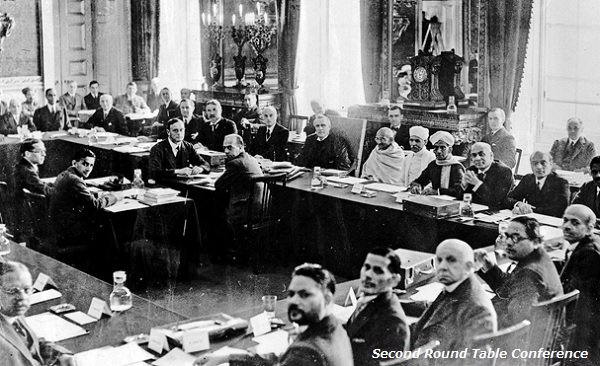
Just after the signing of the Gandhi-lrwin Pact, a crowd had been fired in East Godavari, in Andhra Pradesh, and four persons were killed simply because the people had put up Gandhi's portrait.
After the failure of the Round Table Conference, Gandhiji and other (cadets of the Congress were again arrested and the Congress declared illegal.
The Civil Disobedience Movement gradually waned and political enthusiasm and exhilaration gave way to frustration and depression.
The Congress officially suspended the movement in May 1933 and withdrew it in May 1934. Gandhi once again withdrew from active politics.
The Third Round Table Conference met in London in November 1932, without the leaders of the Congress.
Government of India Act (1935)
After the Third Round Table Conference, the Government of India Act of 1935 passed.
The Act provided for the establishment of an All India Federation and a new system of government for the provinces on the basis of provincial autonomy.
The federation was to be based on a union of the provinces of British India and the Princely States.
There would be a bicameral federal legislature in which the States were given disproportionate weightage.
The representatives of the States were not to be elected by the people, but appointed directly by the rulers.
Only 14 per cent of the total population in British India was given the right to vote. Even this legislature, in which the Princes were once again to be used to check and counter the nationalist elements, was denied the real power.
Defence and foreign affairs remained outside the legislature’s control, while the Governor-General retained special control over the other subjects.
The Governor-General and the Governors were to be appointed by the British Government and were responsible for the governance.
In the provinces, local power was increased. The ministers responsible to the provincial assemblies were to control all departments of provincial administration. But the Governors were given special powers. They could veto legislative action and legislate on their own.
Moreover, the government retained full control over the civil service and the police.
The Act could not satisfy the nationalist aspiration for both political and economic power continued to be concentrated in the hands of the British Government.
Foreign rule was to continue as before, only a few popularly elected ministers were to be added to the structure of British administration in India.
The Congress condemned the Act as "totally disappointing."
The federal part of the Act was never introduced, but the provincial part was soon put into operation.
Though bitterly opposed to the Act, the Congress contested the elections under the new Act of 1935.
The elections conclusively demonstrated that a large majority of Indian people supported the Congress, which swept the polls in most of the provinces.
Congress ministries were formed in July 1937 in seven out of eleven provinces. Later, Congress formed coalition governments in two others. Only Bengal and the Punjab had non-Congress ministries.
Congress Ministries
The important features of Congress Ministries after 1937 election were −
The Congress ministers reduced their own salaries drastically to Rs. 500 per month;
Most of them travelled in the second or third class railway compartments;
They set up new standards of honesty and public service;
They paid greater attention to primary, technical, and higher education and public health;
They helped the peasant by passing anti-usury and tenancy legislation;
They promoted civil liberties. Political prisoners were released;
There was "relaxation of police and secret service raj;"
Freedom of the press was enhanced; and
Trade unions felt freer and were able to win wage increases for workers.
The period between 1935 and 1939 witnessed several other important political developments which, in a way, marked a new turn in the nationalist movement and the Congress.
Growth of Socialist Ideas
The decade of 1930s witnessed the rapid growth of socialist ideas within and outside the Congress.
In 1929, there was a great economic slump or depression in the United States, which gradually spread to the rest of the world resulting in economic distress and unemployment on a large scale (across the world). But the economic situation in the Soviet Union was just the opposite. There was not only no slump, but the years between 1929 and 1936 witnessed the successful completion of the first two Five Year Plans, which increased the Soviet industrial production by more than four times.
The world depression, thus, brought the capitalist system into disrepute and drew attention towards Marxism, socialism, and economic planning. Consequently, socialist ideas began to attract more and more people, especially the young, the workers, and the peasants.
The economic depression also worsened the conditions of the peasants and workers in India. The prices of agricultural products dropped by over 50 per cent by the end of 1932.
The employers tried to reduce wages. The peasants all over the country began to demand land reforms, reduction of land revenue and rent, and relief from indebtedness.
Workers in the factories and plantations increasingly demanded better conditions of work and recognition of their trade union rights. Consequently, there was rapid growth of trade unions in the cities and the Kisan Sabhas (peasants' unions) in many areas, particularly in Uttar Pradesh, Bihar, Tamil Nadu, Andhra Pradesh, Kerala, and Punjab.
The first all-India peasant organization, the All-India Kisan Sabha was formed in 1936. The peasants also began to take a more active part in the national movement.
In his presidential address to the Lucknow Congress in 1936, Nehru urged the Congress to accept socialism as its goal and to bring itself closer to the peasantry and the working class.
In 1938, Subhash Chandra Bose had been re-elected as the president of the Congress even though Gandhi had opposed him. However, an opposition by Gandhi and his supporters in the Congress Working Committee compelled Bose to resign from the President-ship of the Congress in 1939.
Congress and World Affairs
During the period of 1935-1939, Congress actively participated for the development of world affairs. It had gradually developed a foreign policy based on opposition to the spread of imperialism.
In February 1927, Jawaharlal Nehru on behalf of the National Congress attended the Congress of oppressed nationalities at Brussels organized by political exiles and revolutionaries from the countries of Asia, Africa, and Latin America, suffering from economic or political imperialism.
In 1927, the Madras session of the National Congress warned the Government that the people of India would not support Britain in any war undertaken with its imperialist aims.
Princely States’ Struggle
Popular struggles by the princely states were waged in many of the states including Rajkot, Jaipur, Kashmir, Hyderabad, Travancore, etc.
People of many of the princely states now began to organize movements for democratic rights and popular governments.
All India States’ People’s Conference had already been founded in December 1927 to coordinate political activities in the different states.
In the Government of India Act of 1935, the proposed federal structure was so planned as to check the forces of nationalism. It was provided that the princes would get 2/5rd of the seats in the Upper House and 1/3rd of the seats in the Lower House.
The Nizam of Hyderabad declared that the popular agitation was anti-Muslim; the Maharaja of Kashmir branded it as anti-Hindu; while the Maharaja of Travancore claimed that Christians were behind the popular agitation.
The National Congress supported the states' people's struggle and urged the princes to introduce democratic representative government and to grant fundamental civil rights.
In 1938, when the Congress defined its goal of independence it included the independence of the princely states.
In 1939, Jawaharlal Nehru became the President of the All India States' People's Conference. The States' people's movement awakened the national consciousness among the people of the states. It also spread a new consciousness of unity all over India.
Growth of Communalism
In 1940, the Muslim League passed a resolution demanding partition of the country and the creation of a state to be called Pakistan after independence.
The Muslim League propaganda gained by the existence of such communal bodies among the Hindus as the Hindu Mahasabha.
The Hindu communalists echoed the Muslim communalists by declaring that the Hindus were a distinct nation and that India was the land of the Hindus. Thus they too accepted the two-nation theory.
The Hindu communalists actively opposed the policy of giving adequate safeguards to the minorities so as to remove their fears of domination by the majority.
National Movement During World War II
The Second World War broke out in September 1939 when Nazi (Germany) invaded Poland in pursuance of Hitler’s scheme of German expansion.
The Government of India immediately joined the war without consulting the National Congress or the elected members of the central legislature.
The Congress leaders demanded that India must be declared free or at least effective power put in Indian hands before it could actively participate in the war. The British Government refused to accept this demand the Congress ordered its ministries to resign.
In October 1940, Gandhi gave the call for a limited Satyagraha by a few selected individuals.
By March 1942, Japan quickly overran the Philippines, Indo-China, Indonesia, Malaya, and Burma and occupied Rangoon. This brought the war to India’s door-step.
The British Government now desperately wanted the active cooperation of Indians in the war effort.
Cripps Mission
To secure this cooperation, British Government sent to India a mission headed by a Cabinet Minister, Sir Stafford Cripps in March 1942.
Cripps declared that the aim of British policy in India was "the earliest possible realization of self-government in India," but detailed negotiations between the British Government and the Congress leaders broke down, as the British Government refused to accept the Congress demand for the immediate transfer of effective power to Indians.
Quit India Movement
The All India Congress Committee met at Bombay on August 8, 1942. It passed the famous 'Quit India' Resolution and proposed the starting of a non-violent mass struggle under Gandhiji’s leadership to achieve this aim.
Early in the morning of August 9, Gandhiji and other Congress leaders were arrested and the Congress was once again declared illegal.
The news of these arrests left the country aghast, and a spontaneous movement of protest arose everywhere, giving expression to the pent up anger of the people.
All over the country there were strikes in factories, schools and colleges, and demonstrations which were lathi-charged and fired upon.
The Government on its part went all out to crush the 1942 movement. Its repression knew no bounds. The press was completely muzzled. The demonstrating crowds were machine-gunned and even bombed from the air.
In the end, the Government succeeded in crushing the movement. The Revolt of 1942, as it has been termed, was in fact short-lived.
After the suppression of the Revolt of 1942, there was hardly any political activity inside the country till the war ended in 1945.
The established leaders of the national movement were behind the bars, and no new leaders arose to take their place or to give a new lead to the country.
In 1943, Bengal was plunged into the worst famine in recent history. Within a few months over three million people died because of starvation. There was deep anger among the people for the Government could have pre-vented the famine from taking such a heavy toll of life.
Azad Hind Fauj
The national movement, however, found a new expression outside the country's frontiers. Subhas Chandra Bose bad escaped from India in March 1941, went the Soviet Union for help. But when the Soviet Union joined the allies in June 1941, he went to Germany.
In February 1943, Bose left for Japan to organize an armed struggle against British rule with Japanese help.
In Singapore, Bose formed the Azad Hind Fauj (Indian National Army or INA) to conduct a military campaign for the liberation of India. He was assisted by Rash Behari Bose, an old terrorist revolutionary.
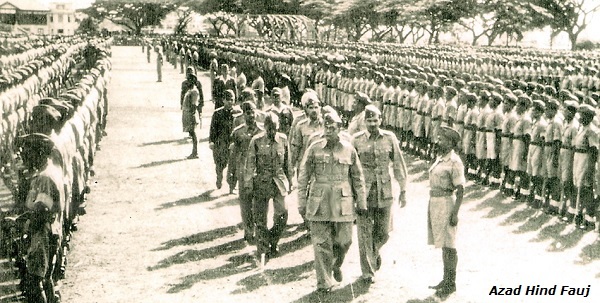
Before the arrival of Subhash Bose, steps towards the organization of the INA had been taken by General Mohan Singh (at that time, he was a captain of the British Indian army).
Subhash Bose, who was now called Netaji by the soldiers of the INA, gave his followers the battle cry of 'Jai Hind'.
The INA joined the Japanese army in its march on India from Burma. Inspired by the aim of freeing their homeland, the soldiers and officers of the INA hoped to enter India as its liberators with Subhash Bose at the head of the Provisional Government of Free India.
With the collapse of Japan in the War during 1944-45, the INA too met defeat, and Subhash Bose was died in an airplane accident on his way to Tokyo.
Modern Indian History - Post-War Struggle
The Revolt of 1942 and INA had revealed the heroism and determination of the Indian people.
The new struggle took the form of a massive movement against the trial of the soldiers and officers of the INA.
The Government decided to put on trial in the Red Fort at Delhi to Generals Shah Nawaz, Gurdial Singh Dhillon, and Prem Sehgal of the INA, who had earlier been officers in the British Indian Army.
On the other hand, the Indian people welcomed INA soldiers as national heroes. Huge popular demonstrations demanding their release were held all over the country.
This British Government was this time in no position to ignore Indian opinion; even though the Court Martial held the INA prisoners guilty, the Government felt it expedient to set free.
The changed attitude of the British Government is explained by the following factors −
The war had changed the balance of power in the world; United States of America and the Soviet Union emerged as the big powers and both supported India’s demand for freedom;
Even though Britain was on the winning side in the war, its economic and military power was shattered;
Having fought and shed their blood for nearly six years (i.e. World War II), they had no desire to spend many more years away from home in India suppressing the Indian people’s struggle for freedom;
The British Indian Government could no longer rely on the Indian personnel of its civil administration and armed forces to suppress the national movement. One of the most significant examples was the famous revolt of the Indian naval ratings at Bombay in February 1946. The ratings had fought a seven-hour battle with the army and navy and had surrendered only when asked to do so by the national leaders;
The confident and determined mood of the Indian people were now evident that they would no longer in mood to tolerate the humiliation of foreign rule; and
There was large-scale labor unrest and mass strikes all over the country.
Cabinet Mission
The British Government, therefore, sent Cabinet Mission in March 1946 to negotiate with the Indian leaders; the terms for the transfer of power to Indians.
The Cabinet Mission proposed a two-tiered federal plan, which was expected to maintain national unity while conceding the largest measure of regional autonomy.
There was to be a federation of the provinces and the states, with the federal center controlling only defence, foreign affairs, and communications.
Both the National Congress and the Muslim League accepted this plan. But the two could not agree on the plan for an interim government, which would convene a constituent assembly to frame a constitution for the free, federal India.
The National Congress and the Muslim League also put differing interpretations on the Cabinet Mission scheme to which they had agreed earlier.
In September 1946, Interim Cabinet, headed by Jawaharlal Nehru, was formed by the Congress.
The Muslim League joined the Cabinet in October after some hesitation; but it decided to boycott the constituent assembly.
Clement Attlee’s Declaration & Independence
On February 20, 1947, Clement Attlee, British Premier, declared that the British would quit India in June 1948.
The ecstasy of coming independence was marred by the large-scale communal riots during and after August 1946. The Hindu and Muslim communalists blamed each other for starting the heinous killings and competed with each other in cruelty.
Lord Louis Mountbatten, who had come to India as Viceroy in March 1947, worked out a compromise after long discussions with the leaders of the Congress and the Muslim League: the country was to be free but not united.
India would be partitioned and a new state of Pakistan would be created along with a free India.
The nationalist leaders agreed to the partition of India in order to avoid the large-scale blood bath that communal riots threatened. But they did not accept the two-nation theory.
The nationalist leaders did not agree to hand over one-third of the country to the Muslim League as the latter wanted and as the proportion of the Muslims in Indian population would have indicated.
The national congress agreed to the separation of only those areas where the influence of the Muslim League was predominant.
In the North Western Frontier Province, and the Sylhet district of Assam where the influence of the League was doubtful, a plebiscite was held.
The Indian nationalists accepted the partition not because there were two nations in India - a Hindu nation and a Muslim nation, but because of the historical development of communalism, both Hindu and Muslim. In last 70 years, the communalism had created a situation where the alternative to partition was mass killing of lakhs of innocent people in senseless and barbaric communal riots.
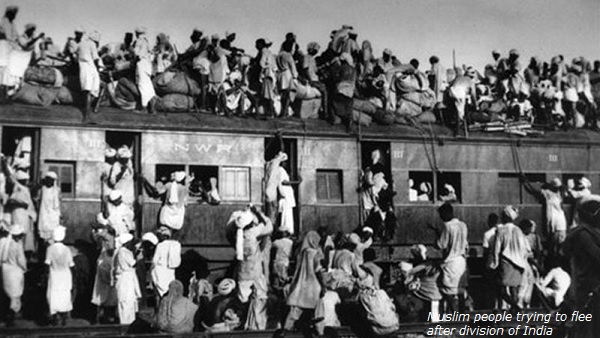
The announcement that India and Pakistan would be free was made on 3 June 1947.
On 15 August 1947, India celebrated with joy its first day of freedom.
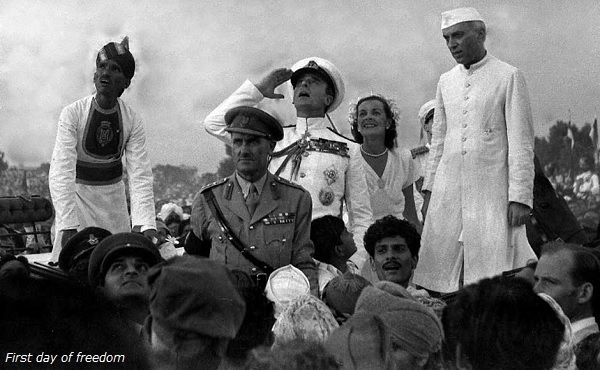
After the independence, the princely states were given the choice of joining either of the new states (i.e. India or Pakistan).
Under the pressure of the popular states’ people's movements and guided by the masterful diplomacy of Sardar Patel (the Home Minister), most of the princely states acceded to India.
The Nawab of Junagadh, the Nizam of Hyderabad, and the Maharaja of Jammu and Kashmir held back for some time.
The Nawab of Junagadh, a small state on the coast of Kathiawar, announced accession to Pakistan even though the people of the state desired to join India. In the end, Indian troops occupied the state and a plebiscite was held, which went in favor of joining India.
The Nizam of Hyderabad made an attempt to claim an Independent status, but was forced to accede in 1948 after an internal revolt had broken out in its Telengana area and then Indian troops had marched into Hyderabad.
The Maharaja of Kashmir also delayed accession to India or Pakistan even though the popular forces led by the National Conference wanted accession to India. However, he acceded to India in October 1947 after Pathans and irregular armed forces of Pakistan invaded Kashmir.
Reference & Disclaimer
Statement of Copyright and Fair Use
The facts of the study material (Modern Indian History), presented here are based on NCERT Modern History, Old Edition (Class XII written by Bipan Chandra) under the copyright guidelines.
Furthermore, the Modern Indian History Study Materials available on this website is published in good faith and only for general information. However, if the authority of this study material feels otherwise, kindly contact us at contact@tutorialspoint.com we will make changes or even remove those parts.